The Grizzle Blog


Done right, you can build an engaged audience of loyal fans and customers. The trick is to:
- Post valuable content consistently—both single tweets and threads
- Interact with your audience in the comments, rather than scheduling posts and walking away
This strategy will help you build an audience and brand awareness at speed while attracting new leads and users who have problems you can solve.
Here’s why investing in your Twitter presence is effective for growth and lead generation, and how to write content that generates reach, engagement, and leads.
Why Twitter is an audience and revenue-generating machine
When you build a community around your brand (both business and personal), your credibility compounds and improves your brand equity because people see you as a human rather than a faceless entity.
This awareness helps you attract fans that are eager to pay attention to what you have to say because your content resonates with them.
As you consistently provide helpful content, you’ll build authority and credibility—just like you would from any other content marketing channel.
The key is to stop thinking of Twitter as a repurposing platform and start thinking about it as a channel to create original content. It’s a content platform with its own ecosystem and search engine. It’s more than a digital billboard for your latest article, event, or announcement—a mindset that severely undermines its potential for attracting your audience.
You wouldn’t post a blog that says “We wrote a new thread on quality content so go check it out on Twitter” with a link. Yet, that’s exactly what some businesses use Twitter to do. This strategy doesn’t work because it’s outdated, cumbersome, and neglects how people want to digest information on the platform.
Users want content served to them directly on the platforms they’re logged into. Non-native content disrupts the intended user experience and breaks a pattern. Unless given a compelling reason to click away, they want platform-specific content.
Amanda Natividad, VP of Marketing at SparkToro, coined the term zero-click content to describe that, now more than ever, people crave in-platform content without needing to interrupt their consumption habits.
SparkToro’s data (as well as our own) show that platforms and algorithms favor in-platform content:

It’s obvious why algorithms prefer it; they want to keep people on their platforms.
But people also expressly favor high-quality native content because it allows them to:
- Engage with brands where they already are (clicking away can feel cumbersome)
- Experience non-intrusive messaging (CTAs and external links can feel out of place)
- Actually read what’s put in front of them (links are often overlooked or not read)
On that last point, the data is fascinating. A study from Columbia University found that 59% of social media links shared by news domains aren’t clicked on at all.
Furthermore, HubSpot looked at 2.7 million link-containing tweets and found that there is no correlation between retweets and clicks. This means that people will retweet something without even reading it, which aligns with the Columbia findings.
The data makes our jobs as marketers seem bleak, but that's only true if you treat Twitter like a place to simply distribute content. When you tack a link onto the tail end of platform-specific content it will only drive traffic if:
- You’ve spent time sharing native content without links and built an engaged audience on the platform
- You do it sparingly (the 80/20 rule is a good true north for articles)
Not all links are created equal, so the 80/20 rule doesn’t always apply. A link to a blog post is different from a link to a newsletter signup form, for example. The former requires a decent time commitment while the latter is a quick action.
As such, newsletter CTAs or forms can be tacked onto most posts, preferably a few hours after you share them. This works to:
- Bring your post to the top of people’s feeds again (additional tweets in a thread can trigger the algorithm to ‘reshare’ it)
- Provide a key window of time for native-only content to be consumed
For example, I created native content almost exclusively in my first four months on Twitter and grew my audience from ~500 to ~14k.
Because of this, by the time I promoted an article, people were eager to not only click but spend time reading it. In 24 hours, we generated::
- 233 pageviews
- 214 unique pageviews
- 4:48 average time on page
My goal was to build my credibility to a point where people believed me when I said “read this: it's worth your time.” This experiment proved successful and my links now generate clicks, leads, and new clients.
Both threads and single tweets are critical to growth
Single tweets are important and should be incorporated into your content strategy. But love them or hate them, threads tend to have a bigger reach (and impact).
Use threads to expand organic reach
Check out the difference in impressions between a single tweet of mine vs. a thread with only 100 more likes (the higher the like count, the less impactful differences of hundreds become):
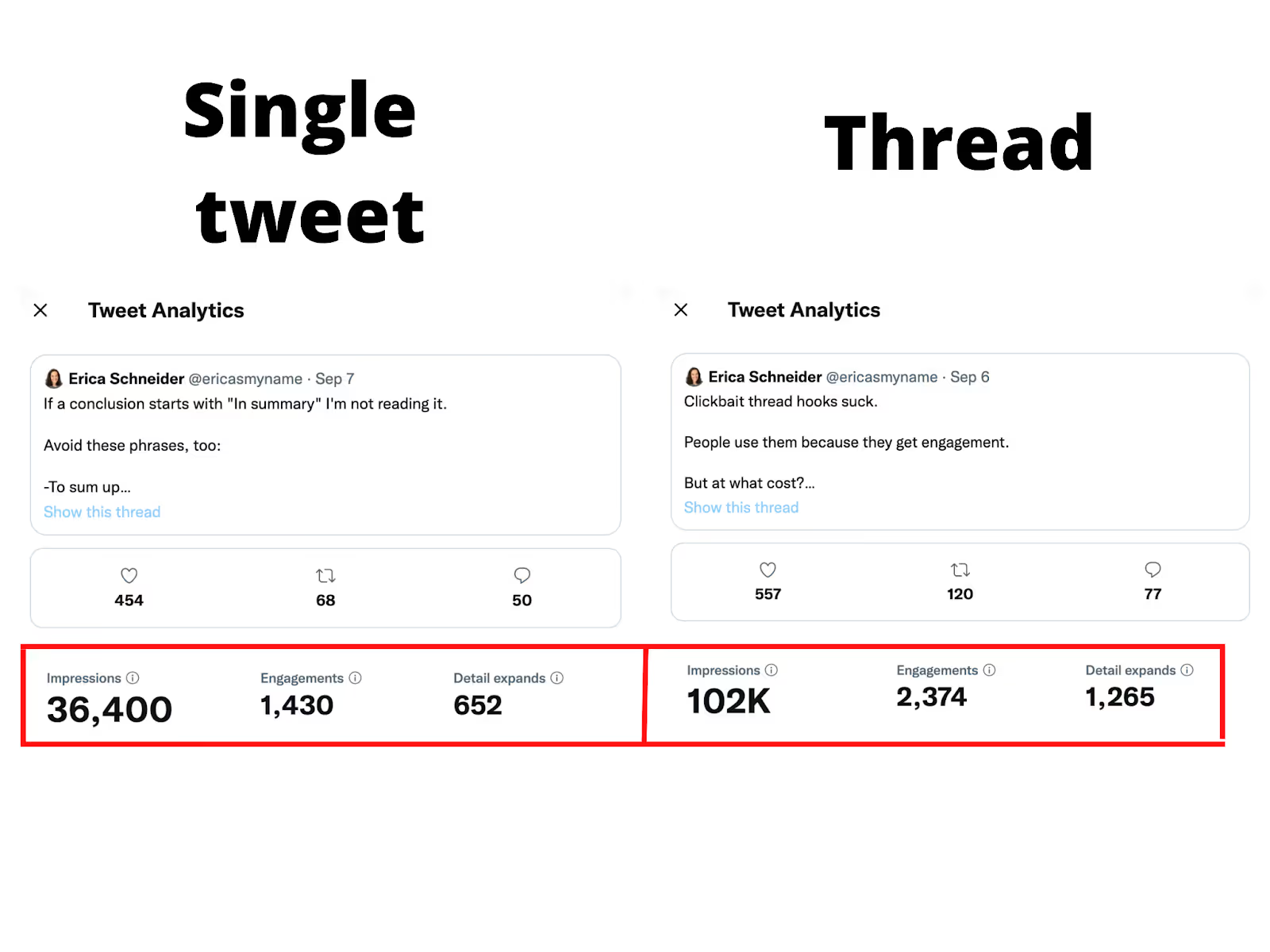
These were posted one day apart, which means I was reaching a similar audience.
While the thread only got 100 more likes, it received ~65,000 more impressions, was shared ~2x more times, and got ~2x more engagement.
Threads generally perform better because they’re educational in nature and help people solve problems. Whether you’re teaching people how to do something or telling a story of success or failure, your audience is learning as they read and taking notes on how to apply the tips to their own circumstances.
Because of this, your audience will likely be more engaged and keen to retweet and share with their network. Twitter rewards engagement (i.e. comments and retweets), meaning reach compounds.
Think of threads like long-form articles for Twitter, written with a blend of copywriting and content writing styles.
Let’s return to the thread I mentioned earlier that linked to our Quality Content Marketing Matters article at the end and break down why it was successful.
Here are the analytics:
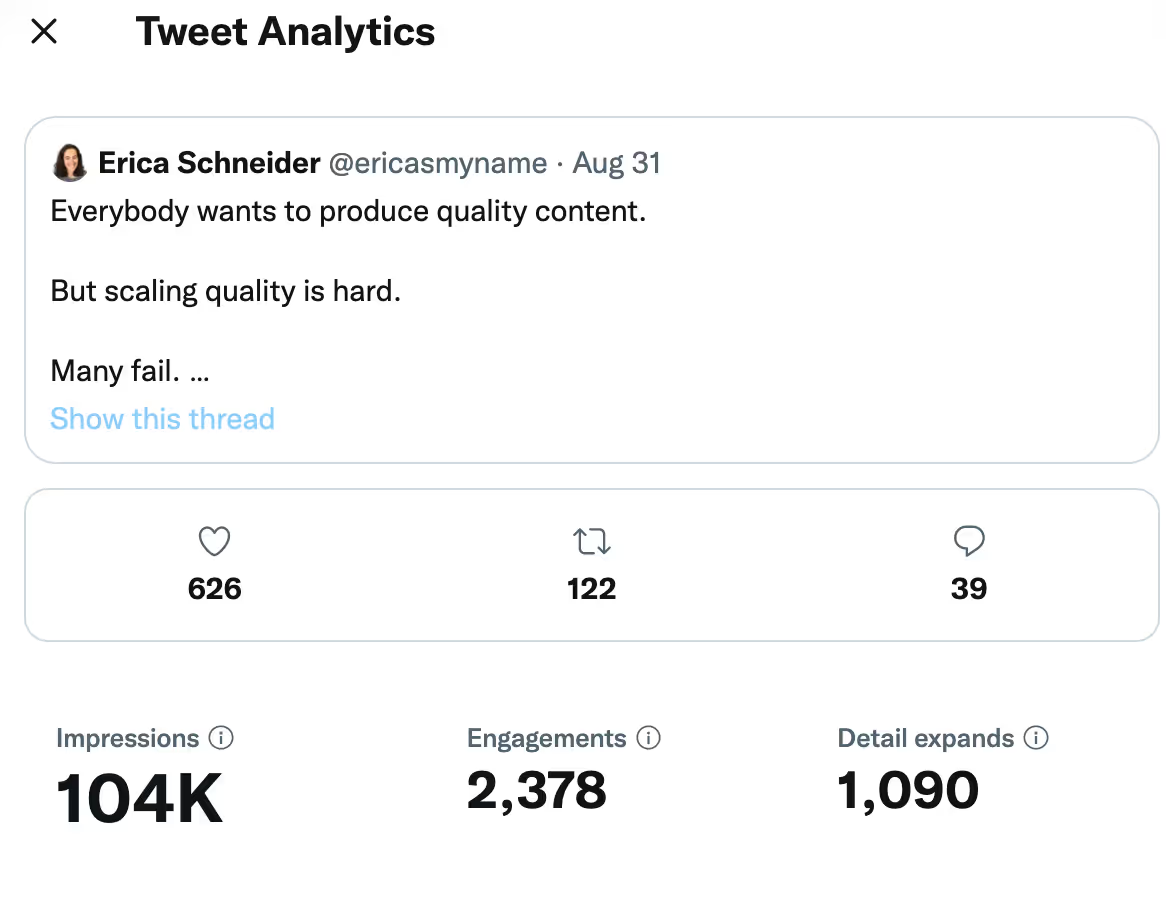
Over 100k impressions and 2k+ engagements is a great result and led directly to that spike in pageviews and time on page referenced above.
I repromoted the same article a few days later in a single tweet with a link and it got 100+ likes but generated nearly 100K fewer impressions than the thread:

The thread drove more engagement, and more readers to my article, generated several leads, and expanded my personal (and subsequently Grizzle’s) brand awareness.
Use single tweets to bolster engagement and show your personality
As for single tweet formats, quick tips, pieces of expertise, or questions to your audience can drum up tons of engagement even if the reach isn’t always as impressive.
For example, this single tweet asking a question about writing and editing sitting vs. standing got ~14k impressions and generated 67 comments:
And this tweet listing my article writing process (that ended with a question to inspire engagement) drummed up over 1,000 likes and 60+ comments:
We recommend replying to most comments because it shows your audience that you’re a real person and not some unreachable entity.
This is key for both personal and business brands: when you engage and respond, you personalize the experience and build deeper connections. The deeper your connections, the more loyal your audience will be.
Critically, they’ll also feel more motivated to learn about the business you run or represent and consider becoming a customer. Meaningful connections through personal interactions build trust, and Twitter is a touchpoint along the customer journey (both before and after an initial purchase).
The more valued people feel, the more likely they are to add you to the consideration set and feel motivated to explore a purchase. As long as you’re delivering value, consistently publishing tweets and threads will generate awareness, leads, and new business.
As for a posting cadence, we recommend the following:
- 2x threads a week to teach and bolster engagement
- At least 2x single tweets a day to remain consistent and please the algorithm (which rewards daily activity)
Note that if you do miss a day or two you’ll be fine. Quality wins over quantity, and we’ve not seen notable drops in engagement because of it.
How to write valuable Twitter posts that build compounding credibility
Twitter content isn’t the same as blog articles, emails, landing pages, or ebooks. It’s also not the same as other social platforms like LinkedIn or Instagram.
You only have 280 characters to work with, so it’s uniquely concise and people scroll and skim at lightning paces.
Let’s look at how to craft engaging threads first.
The most valuable threads capture and hold attention
A great thread starts with a great hook. People want to know:
- Why they should bother reading
- How it will help them solve a problem
- What they will learn
If you don't answer these questions, they won't care or feel motivated to click into it and read.
A great way to capture attention is to poke at a pain point, add credibility via quantifiable proof (numbers perform well), get specific with outcomes, and end with a cliffhanger:
- Poking at the pain lights up emotions and gives readers something to relate to, e.g. “Most people get this wrong” or “I was struggling and wish I had a playbook to follow”.
- Adding credibility acts as social proof and gives people a reason to care or trust what you’re saying, e.g. “I’ve edited 3M+ words” or “We’ve spent 7 years building systems that have netted $5,000,000 revenue”.
- Getting specific with outcomes allows readers to picture what they can accomplish themselves by reading, e.g. “ensure your new employee stays at your organization” or “3x conversions in 90 days”.
- Leaving a cliffhanger encourages people to click to find out what’s next. This is especially key if your thread is a listicle. For example, if the crux is “8 ways to X”, don’t include what those are in the hook—make the reader click more to see more.
A bad hook makes it all about you and doesn’t leave anything up to the imagination.
Here are a few examples of strong hook formats:
1. [Opinionated state of play]. [Data]. [Poke at pain]. What to do? [Opinionated solution]. Here's how:
2. As a/an [personalized descriptor] I [pain point] with [trend]. So, I did [descriptor of event] to learn [outcome]. Here are X takeaways:
3. Hot take. [Thought-provoking opinion on trend]. I've [take on future of trend]:
4. [State of play]. But [pain point]. Why (and what to do instead):
5. [Opinion]. Stance on [bad take]. I’ve spent [social proof + timeframe] to achieve [outcome]. The playbook:
These hooks are intriguing, specific, and open a loop that makes you curious about what’s inside.
Once you capture people’s attention, you need to keep it and make the juice worth the squeeze.
You want readers to:
- Easily understand your points
- Experience zero friction
- Stay interested throughout
To do that:
- Share unique insights
- Add the "why" and "how"
- Get creative
- Pay attention to structure
Strong content marketing principles apply to thread writing. The best threads set context, add examples, include prescriptive tips, tell a great story, give the reader instructions on how to do something themselves, and leave them with an action item (e.g. click this link, follow me, and/or retweet to share).
On Twitter, white space is critical—especially when using a listicle format that has dedicated headers. Still, even bold, opinionated, and storytelling content benefits from white space on Twitter.
Generally, this format works best:
- Header: Set the stage
- Subheader: Answer “the why”
- Body: Supplement your argument and answer “how”
- Takeaway: Empower them to follow your advice and give them a reason why it will help them help themselves.
Here’s how this format looks with white space separators:
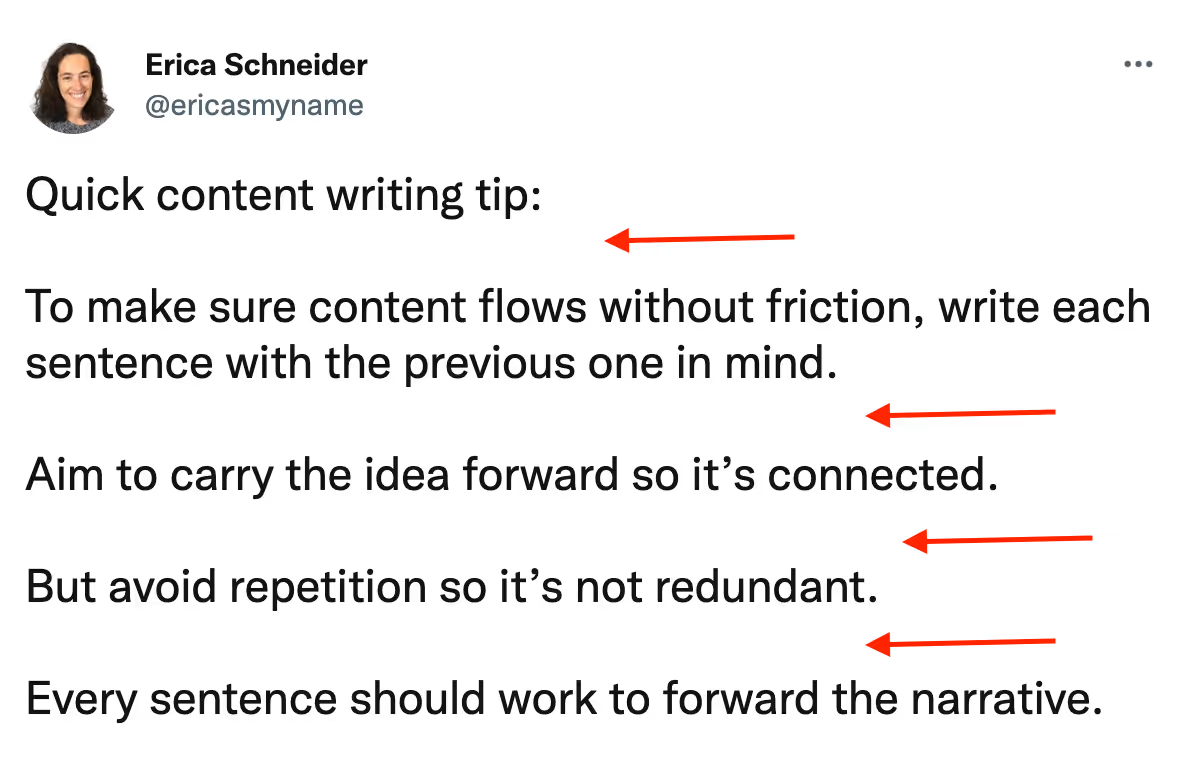
Here’s a meta example of how you could use this format to explain why this advice will help people write stronger Tweets:
- Header: “Answer intent right away”
- Subheader: “This way, the reader understands why what they're about to read matters.”
- Body: “Include data points or personal anecdotes so the reader can picture themselves doing what you’re describing.”
- Takeaway: “Small tweaks like this make a big impact on flow and drive engagement.”
And here’s a simplified version of how we could format a tweet when giving the advice “break up long walls of text”:
- Header: “Break up long walls of text”
- Subheader: “White space helps skimmers and makes content easier to digest & navigate.”
- Body: “Try to limit paragraphs to 2-3 sentences max.”
- Takeaway: “The reading experience matters as much as the words on the page.”
Add your CTA to the final tweet in the thread. Here’s what my thread CTA looked like when I promoted the Quality Content Marketing article referenced above:
This only worked because it was tacked onto original content, formatted for Twitter, and referenced themes discussed in the article.
Here’s the hook I used:
Nothing was copy/pasted. The best-performing repurposed content on Twitter doesn’t feel repurposed—it feels tailored to the unique Twitter experience.
Here’s an example of a body tweet from this thread where I explain what editorial goals are:
Here’s how we talk about editorial goals in the article itself:
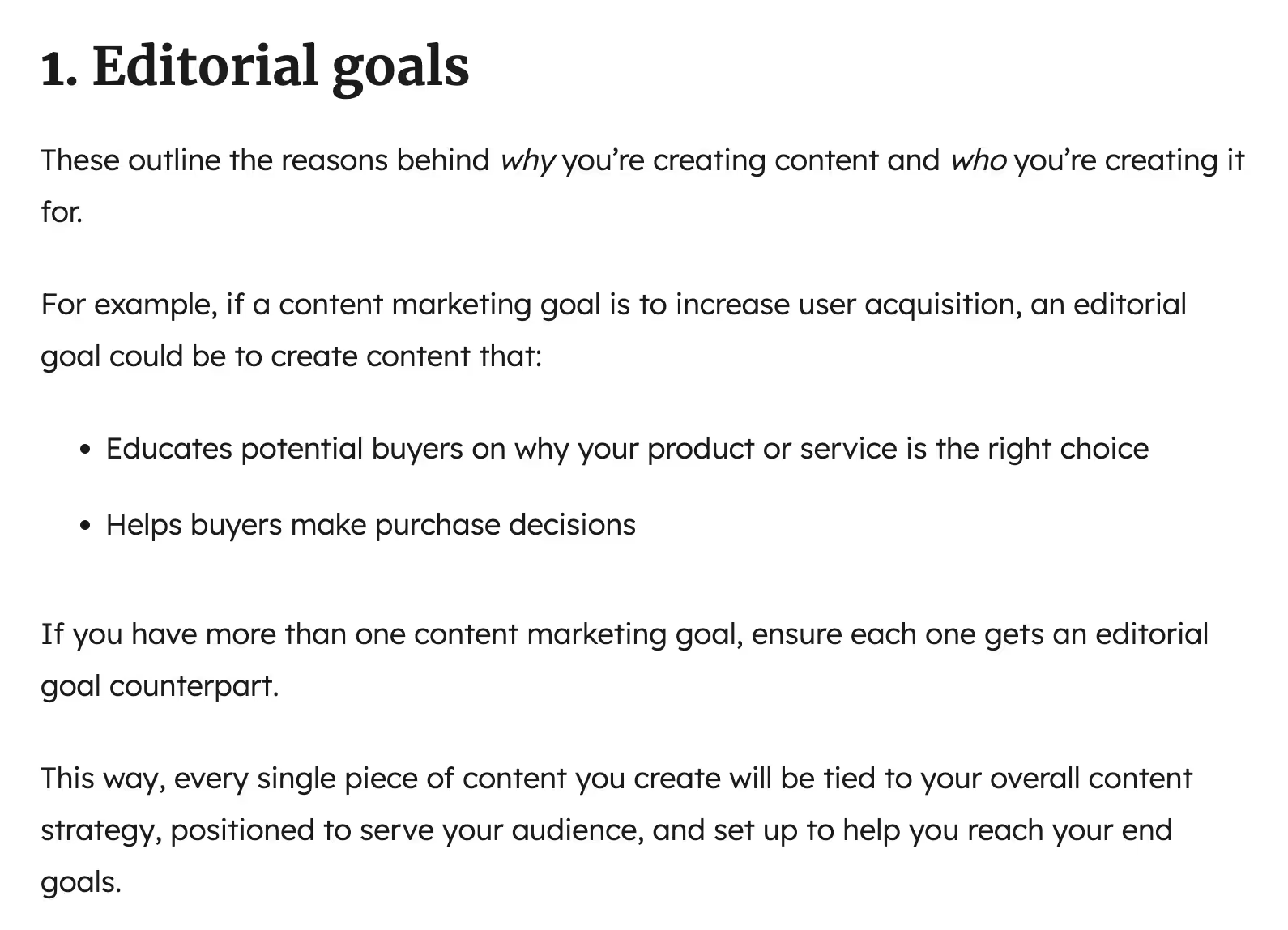
Notice how the examples I picked are completely different. In the article, our target audience is marketers that would benefit from seeing what a relevant content goal looks like.
On Twitter, my audience is a mix of content marketers, writers, and editors looking to improve their written communication skills.
I tailored each example to the audience at hand and structured the content to the format at play. It’s not repurposed; it's reimagined.
Interestingly, I chose to include a second hook in this thread:
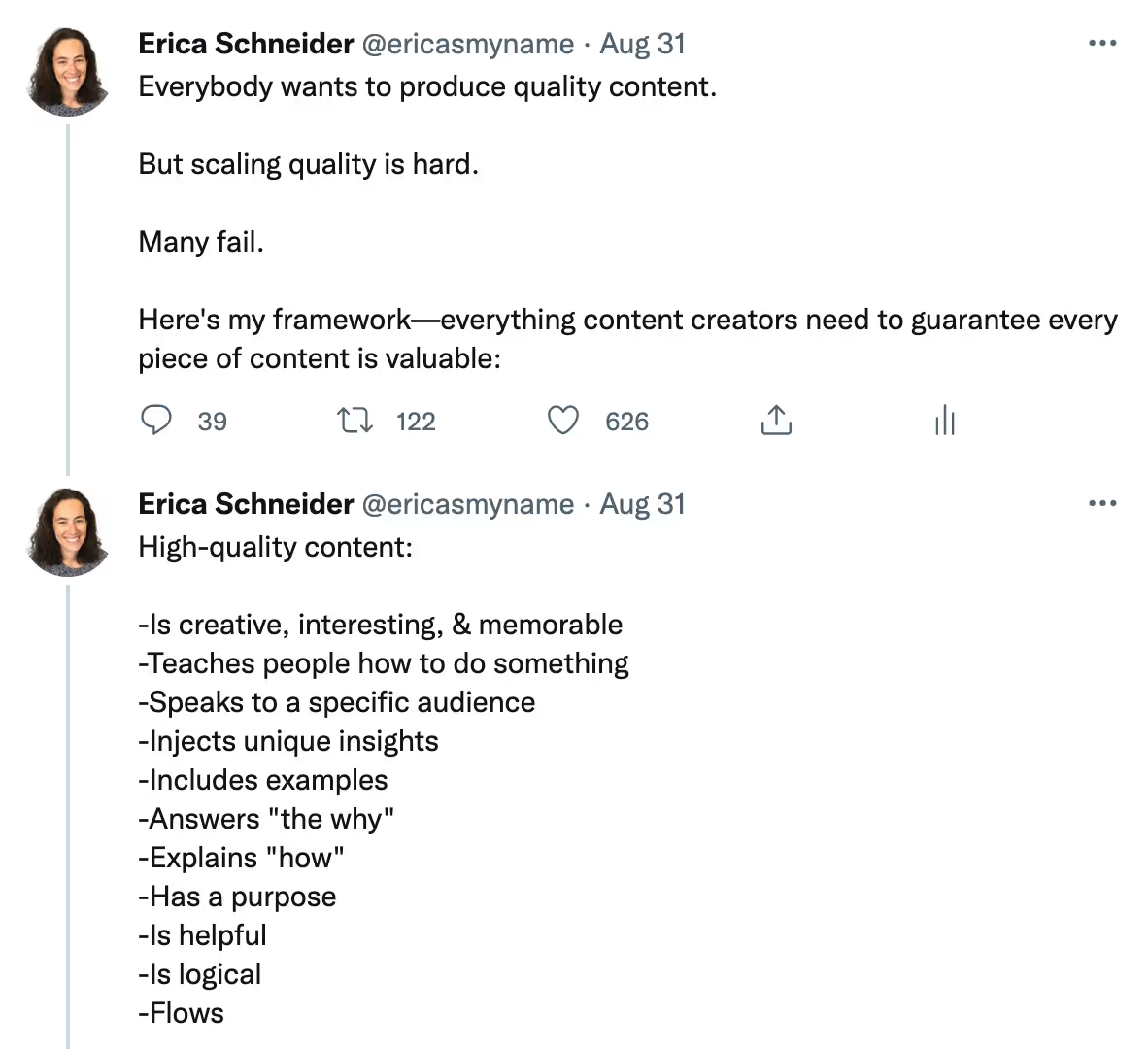
And it got 3x more likes than every other body tweet:
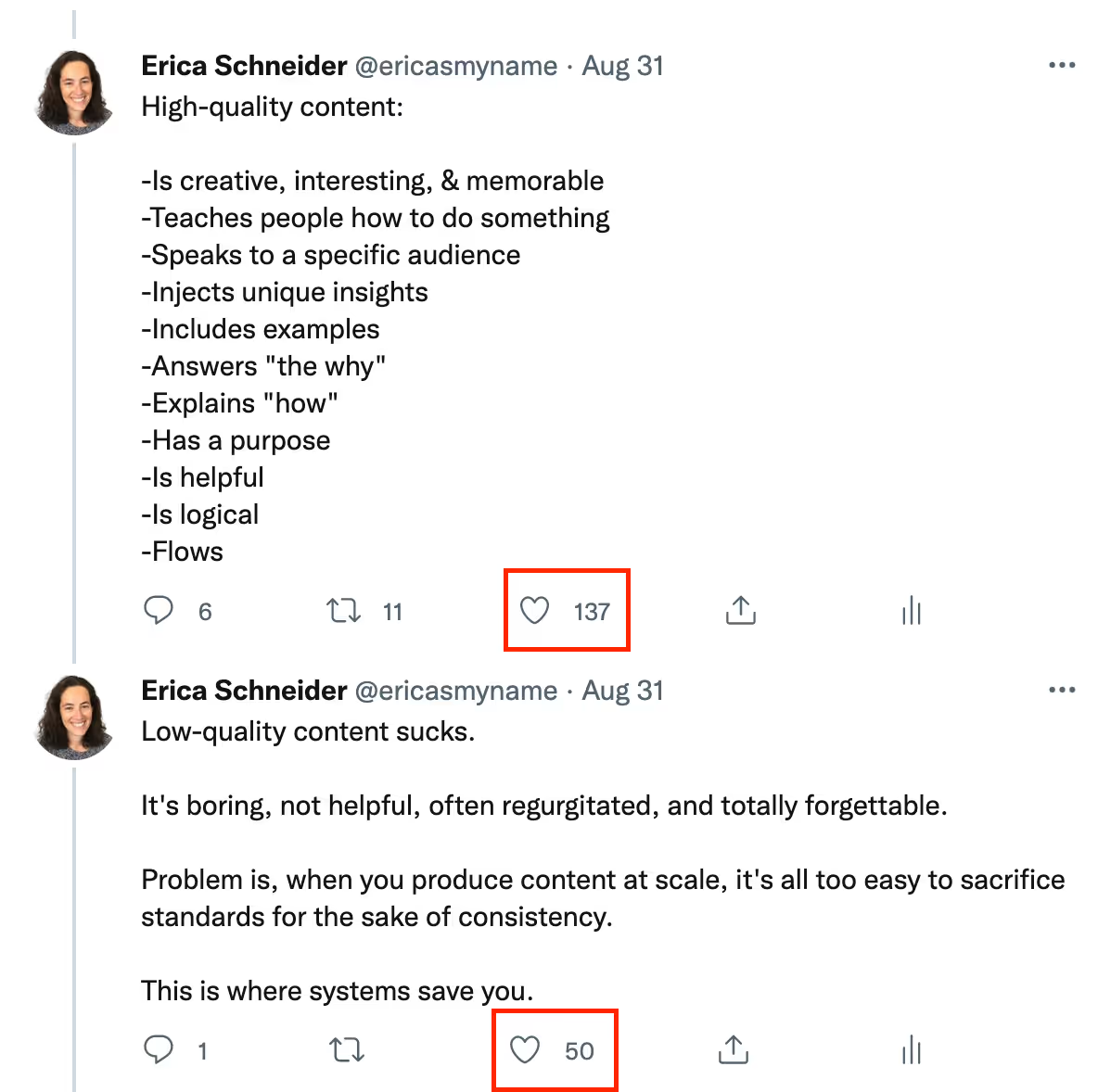
That’s because frontloading value, credibility, and getting ahead of objections works well on Twitter.
In my first hook, I argue that quality content is important but I don’t explain why. To get ahead of objections and prove my point, I used the second tweet to prove:
- I know what I’m talking about
- Here are all the reasons why quality matters
- I’m about to back this up with specifics so keep reading
If the reader wasn’t entirely hooked after reading tweet 1, they certainly are after tweet 2.
This second hook is also a perfect single tweet. Here’s why.
How to write single tweets that drive engagement
The reason why the second hook above performed so well is because it teaches and is uniquely structured for the platform.
Notice how the sentence length cascades from long to short as you read from top to bottom. This is visually engrossing and works to capture attention.
But not every tweet needs to be so obviously structured for the platform.
This quick tip performed well because it poked at a common pain point (everybody wants to make it big, fast), gave advice backed by years of experience, and spoke truth to unrealistic expectations:
Humorous responses to industry trends or new data are also a great way to start a conversation and let your personality shine through:
What B2B marketer hasn’t seen that infographic by now? It’s relatable and makes you want to run to leave a comment.
In general, single tweets give you a chance to demonstrate your personality. They also challenge you to share valuable advice in a short format—which is excellent practice for cutting fluff and redundancy from your writing.
There’s no “perfect” format for single tweets, nor should there be. As long as they’re tailored towards your target audience, you can get creative, share opinions, ask engaging questions, and have a little fun:
The more relatable and resonating, the bigger chance you’ll strengthen existing connections and attract new followers (that may turn into customers one day).
Ignore Twitter and leave relationships on the table
Since joining Twitter we’ve attracted and converted more leads at Grizzle in a shorter period of time than ever before.
All through organic posts and zero targeted outreach.
Posting daily and providing value has shown potential clients that we know how to create quality content.
If you’re sleeping on Twitter or annoyed by how clickbaity and regurgitated content there can feel, you’re ignoring its massive potential. When you mute the noise and focus on your personal and business growth, you build strong relationships that lead to new business opportunities.
Of course, if the idea of doing it yourself is too painful or you don’t have time, you can also work with experts to write social content for you.


In this article, you’ll learn how to strategically choose content topics that align with all of your business goals; whether that be lead generation, acquisition or retention.
We’ll share content ideation methods used at Grizzle, as well as those used by content marketers at companies like Databox, ConversionXL and Braze.
1. Tapping into sales and customer success teams
Does your marketing team work in a silo, away from sales and customer success teams? You could be missing out on an array of content ideation opportunities to support prospects across the entire buyer journey.
Below are some tips to help you collaborate with sales and customer success teams:
Supporting your sales teams and generate leads
Lead generation is, of course, a key sales metric. And most sales teams would be grateful for content that answers common queries they hear from leads on a daily basis.
This will enable them to spend less time answering repetitive questions, and more time closing deals!
Here’s how to generate a pool of content ideas that help support your sales team and generate leads at the same time:
Interview sales managers and SDRs
Interview sales reps and managers to understand the sales cycle, their biggest goals and common pain-points or questions they hear from prospects. You can get rich, honest insights by interviewing sales members.
Pro tip: Record and transcribe these interviews and repurpose quotes in future pieces of content. This will help you collect deep, qualitative insights you can refer to when expanding your buyer personas, while positioning your salespeople as experts at the same time.
Here are some questions you can ask sales reps to elicit insights for your content ideation process:
- What are some common challenges prospects bring up again and again?
- Which part of our product/service makes prospects light up?
- Which content would you find most helpful to provide prospects?
- What are the main sales metrics you need to meet?
- What are the common queries you get from prospects?
- What are common sales objections you get across the sales journey?
- Are you happy with current sales materials?
- Can you explain the internal sales process? E.g from first point of contact to closing
- Which sales questions do you struggle to answer the most?
- Which sales materials do you most regularly send leads?
Audit and optimise your sales material
Ask your sales teams to send you the content they use on a regular basis. This can include:
- Any white papers, case studies etc. they regularly send to prospects
- Email outreach templates
- Template responses used for FAQs
Add these to a spreadsheet and note at which stage of the sales cycle materials are used, the traffic to these pages (if relevant), and quality of the content.
This exercise should help you notice obvious gaps and content that needs refreshing. For example, case study pages may get high traffic, but be thin in value and show low “time spent on page”. Refreshing case studies may be a priority area.
Sit in on sales calls (or request recordings)
Sitting in on sales calls will let you grasp objections from the perspective of a potential customer. You may pick up blind spots that weren’t picked up by speaking to the sales team alone.
As Emily Byford, B2B Content Marketer, says:
“Listen to your customers, listen to your sales team. If possible, get your sales team to record their calls, and make a habit of listening to a couple a week. This will help you understand what matters most to your potential customers – the problems they’re *really* looking to solve. What are the questions they ask most often? Use this to prioritise the content you’re planning.”
Once you’ve captured all this information from the sales team and your audits, present a shortlist of topics to the team about which you’ll be prioritizing for the next quarter.
Supporting customer success teams to boost retention (and prevent churn)
Customer success teams want to delight customers and prevent churn. Content can help support customers during this journey.
Below, similar to the section above, is an approach to help you generate a pool of content ideas for your customer success team.
Interview members of the customer success team
Just like you did with sales, fresh insights can be yielded from customer success teams. They speak with customers on a daily basis, and they can bring a different perspective than sales teams.
Some example questions include:
- What do clients love about our product/service?
- What are the common woes (both product and non-product related) that customers talk about?
- What are the customer success team’s goals and success metrics?
- What does the customer onboarding process look like?
- What is the big problem our customers are looking to solve by using our product?
- What are the most common reasons customers churn?
- What are the most frequently asked questions from clients?
- What content would be most helpful to send new customers?
- Best customer success stories?
Compile an audit of current customer success materials
Request to be sent all the current customer success materials in use and create a spreadsheet listing all of these.
Sit in on an onboarding call and a customer check-in call
Listening in on customer calls will help you empathise with customers and uncover content topics that you may not have thought of by talking to internal teams alone.
Agree on topics that will empower customer success
Once you’ve captured all this information, present a shortlist of topics to the customer success team about which you’ll be prioritizing.
I spoke with Todd Grennan, Managing Editor at Braze, who explained how he uses a similar process of interviewing different department representatives to plan each quarter’s topics:
“We operate on a quarterly schedule, aligned with the rest of the business. A month before the end of the previous quarter, my team starts having 1:1 meetings with representatives of other departments in the organisation. We basically sit down with them for half an hour each and talk through what their focus is for the next 3 months, what their business concerns are, what they’re seeing in the market etc.
Often, one of the biggest signals regarding whether there’s a topic we ought to take on is when we hear from disparate departments that a particular topic is a major topic of focus for them. This is usually a sign that this is a topic worth diving into that hasn’t caught on our radar yet.
Usually we take the raw material from these interviews and take that in concert with any demand generation information we have for the quarter. We don’t want to have tunnel vision when it comes to serving internal needs but we also want to make sure that any insights various teams have seen in the market are cared about, particularly if they have relevance for our audience.”
2. Finding SEO-driven topics to increase organic traffic
Below are some tactics to help your content rank on Google; an SEO-first approach to content ideation.
Chris Newton, Inbound Marketing Manager at Klaviyo, explains what we mean by an ‘SEO-first’ approach to support users looking for answers through search engines:
“Content ideation at Klaviyo used to follow an “SEO-second approach” but I’m establishing an SEO-first approach. People would often come to me with a blog post and say ‘can you optimise this for SEO’ after the fact. I find those don’t always tend to perform as well as posts where we identified the topic we want to write about first and then write the post specifically around a certain keyword that we’re trying to optimise for. I call that the SEO-first approach.
I think that as the year goes on, we’re going to be taking more of an SEO-first approach to content ideation.”
How to discover keywords for SEO-first content
When it comes to uncovering SEO-friendly topics, it’s important to begin with some keyword research.
Start by listing keywords you think your target audience would be searching for.
If you’re not sure where to start, have a look at blogs of your competitors. Input their URLs into a tool like Ahrefs, Ubersuggest, or SEMRush and you’ll see which keywords these posts rank for, as Automate.io’s Sr. Content Marketer, Archita Sharma suggests:
Use a tool like Ahrefs to check out your competitor’s keywords and get an understanding of what worked well for them! A simple lookup in Ahrefs’ Content Explorer would show you which keywords, which links are already ranking and how competitive these keywords are. Target these hot keywords and set up your content pipeline accordingly.
Next, punch your chosen keywords to an SEO tool like Ahrefs, which will show you will show you keyword ideas and similar keywords, allowing you to build upon your initial keyword list:

You can even use Google and look at the ‘searches related to’ terms that come up:

Make a note of the average monthly search volume for each keyword, along with the difficulty:
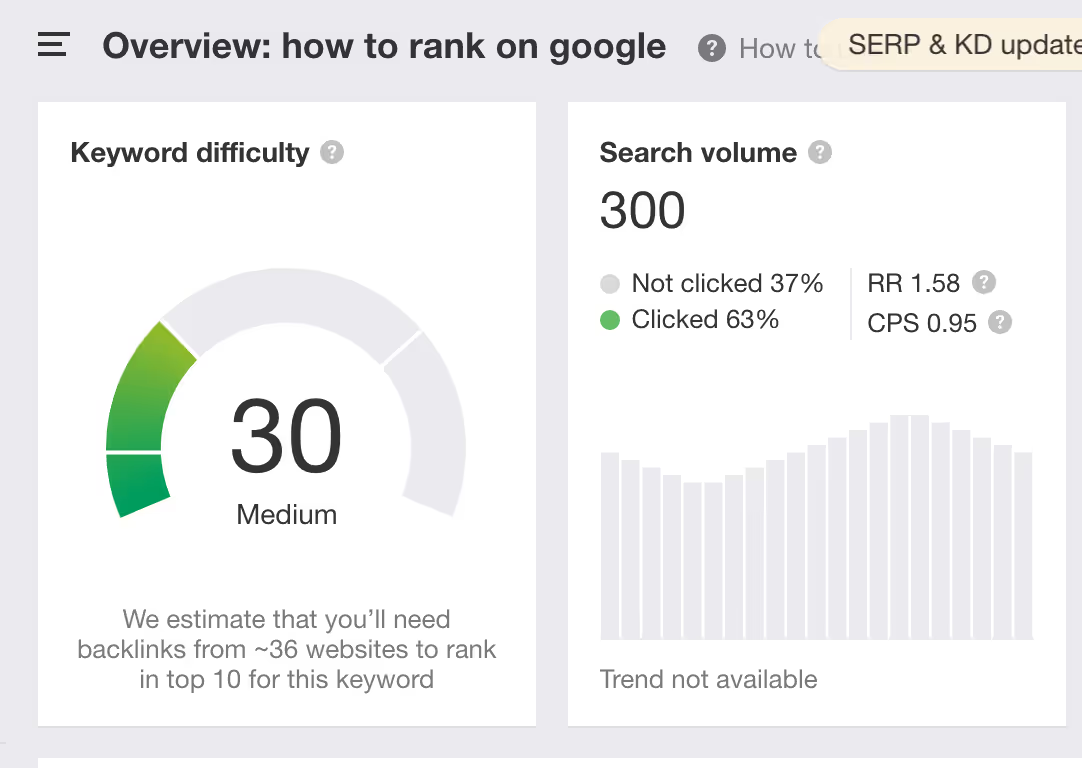
Next, use a tool or a simple incognito search to see which content is ranking on page one of Google’s SERPs:
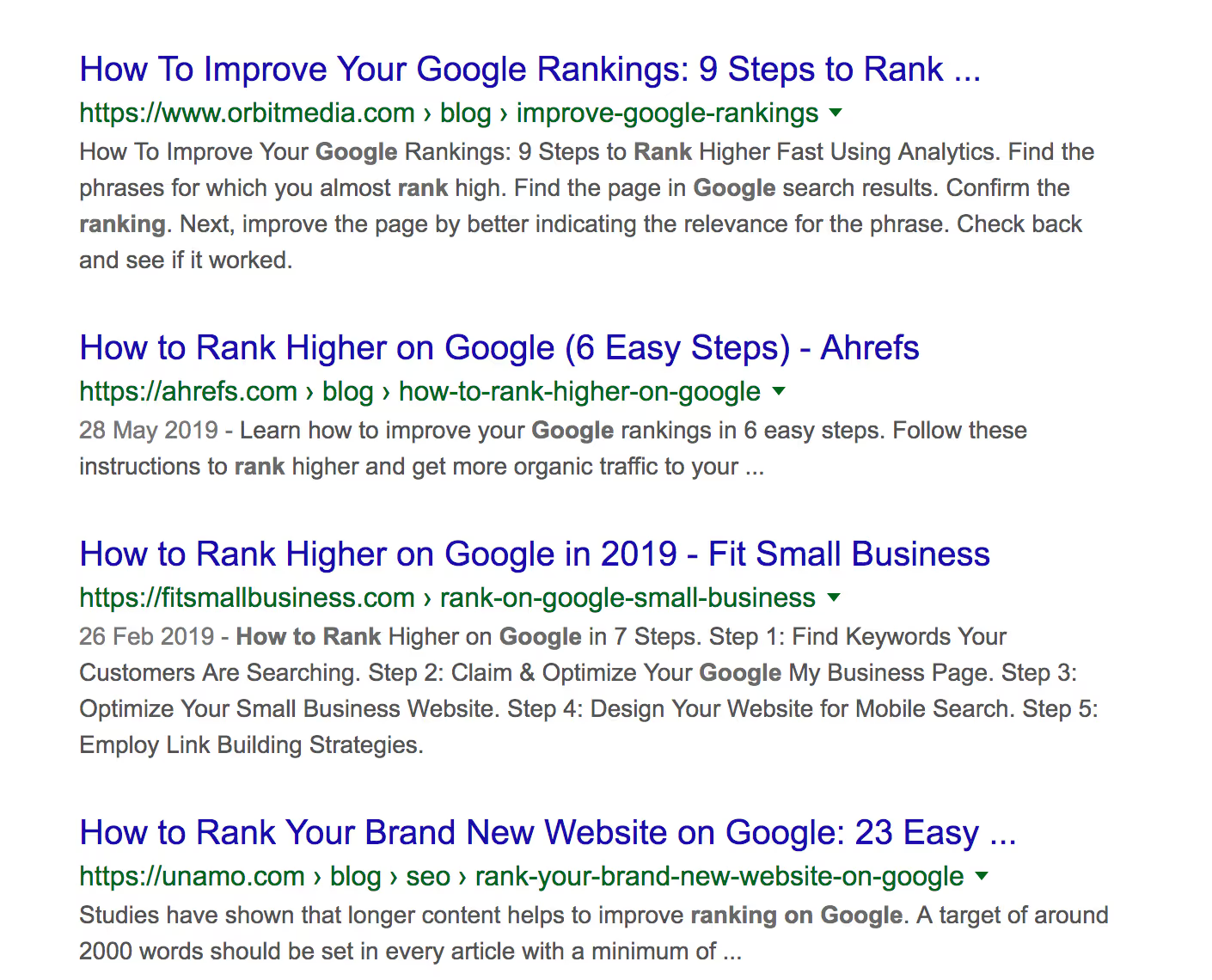
Note down the content titles, assumed search intent per result (are the topics mainly step-by-step articles? News articles?) and the quality of the top 5 SERP results.
A tool like Clearscope will automatically give you this information to help you see areas to outshine the competitor content. Check which other keywords the top domain rank for: Input the domains for the top 5 results into a tool like SEMRush, Ahrefs or Ubersuggest.
Once you’ve gathered all this information, utilize this data to choose SEO-first topic opportunities. You may choose a buffet of topics. Perhaps a couple of 10x pieces to outshine the competition when it comes to high traffic, high competition topics.
You could also sweep up a bunch niche topics that you’ve identified as having low traffic, low competition.
Focus on niche content hubs to rank a new blog
It can be difficult for newer blogs to compete with content from authoritative sites when it comes to organic search.
Derek Gleason, Content Lead at ConversionXL, explains the ‘hub-and-spoke’ strategy that newer sites can utilize to create content that ranks in Google:
For newer sites, content ideation is pretty simple: Pick a topic that’s:
1. Relevant to your company or product
2.For which you can claim authority
3. For which there’s search volume
Then, cover the core topic and its tangents—a hub-and-spoke strategy, essentially.
For example, in my previous work at an agency, a client managed several pediatric urgent care centers. While anything relevant to healthcare could qualify as a potential topic, we wanted them to narrow the focus to their deepest expertise.
Ultimately, it made the most sense for them to answer the question, “Should I take my child to urgent care or the ER?”. We identified about a dozen posts on topics like “When is a fever dangerous?” and “Can you get stitches at urgent care?”
Google rewarded the narrow focus of our mini-hub, and – despite being a small site with unremarkable domain authority – they rank highly on Page 1 for several “Your Money or Your Life” queries that receive added scrutiny from Google.
When users come to any page, we want them to:
1) Know – know what the page is about
2) Feel – feel that the page gives them the right solution
3) Commit – commit to one single action
In terms of the ideation stage, Chris Old from IG suggests using KFC to get a ‘bucket’ of actionable ideas in the following way:
- KNOW – Leverage the expertise of subject-matter authorities in your business. Ask them to post-it note all the key things your company offers.
- FEEL – Once they’ve done that, expand on all those key concepts with anything you could write about on those topics. Udemy is another good resource for expanding on topics – check their table of contents for courses on given subjects. Or do it the old-fashioned way – have a look down Waterstones for books on the subject and see how they structure the content.
- KNOW/FEEL – Once you have all the ideas, categorise them into content clusters and run them through a keyword research tool to see where demand is. That means the keywords you’ve considered, any similar keywords you find, plus keywords the current ranking content is showing up for.
- KNOW/FEEL – Re-categorise your clusters based on demand. You should have one ‘blockbuster article’ or page for each topic, with off-shoot shorter articles expanding on it where there is demand. Have a super-interesting idea with no search volume? Add it to the hub article.
- COMMIT – For each topic cluster, what is the one thing you want users to do? Expand on that for every page within the cluster – what’s the one action you want them to commit to? This should be the first consideration when briefing the content.
- KNOW/FEEL/COMMIT – Now you have everything in place, it’s time to brief the content. That means the usual stuff – H1, H2s, title tag, keywords, Schema markup etc. But we don’t want to lose site of our KFC. Start with the ‘commit’, as above, then also brief in what you want users to ‘feel’ and ‘know’ from each page.
This approach ensures both Google and users see clearly organised content and a sound internal linking structure for each content cluster.
Including the ‘commit’ ensures you give users what they want at the endgame, and coax them into taking that action. And the ‘feel’ ensures they are comfortable to so and more engaged with the page. That, in turn is good for engagement metrics Google may be measuring, while also boosting semantic relevance around the topic.
The only pitfall to avoid: do not create too many off-shoot articles if there is limited demand or overlap between the content. You don’t want Google’s robots to be confused about which pages to rank for what keywords.
Steps to hub and spoke topic ideation:
Here’s a step-by-step approach to help your new website rank well in Google:
- Select a main keyword that will act as your main hub topic for your target audience . Using Derek’s example above, this could be the keyword “should i take my child to urgent care or the ER?”. This will be your hub topic that spoke topics will branch out from.
- Choose niche keyword topics that supplement the main hub topic. For example, spoke topics that relate to the initial query of “should i take my child to urgent care or the ER” could be “when is a fever dangerous?” and “can you get stitches at urgent care?”. These “spoke” topics expand on the hub topics. They can be separate posts that are also internally linked to from the hub post.
- Connect the hub and spoke topics with a URL hierarchy. Ensure there’s a logical URL hierarchy such as blog/urgent-care for the main hub topic and then blog/urgent-care/fever, blog/urgent-care/stitches for the spoke topics to increase your chances of ranking.
Huge content backlog? Create a comprehensive content inventory
On the other end of the spectrum, if you have a blog with a huge backlog of posts, the content ideation process should begin with a comprehensive audit of all your content.
Derek goes on to explain the process he uses at CXL:
“When I started at CXL a year ago, the content ideation process was quite complex. We had over 600 posts that we’d published over seven years. We had already covered the most relevant topics, often more than once (leading to “keyword cannibalization” issues). To succeed here, I started by building a comprehensive inventory of all content—a taxonomy that grouped posts into categories and subcategories.
The taxonomy has made it much quicker to help authors identify a topic that’s new to the blog and, ideally, covers an obvious content gap. For example, we recently published a post on how to identify SaaS metrics; we’ve written posts for SaaS companies many times before (and written about analytics dozens of times, too), but we’d never dedicated a post exclusively to SaaS metrics. I doubt we would’ve spotted that opportunity so quickly without an on-demand catalog of our existing content).
Admittedly, we’re very focused on organic search—it accounts for the lion’s share of our traffic. The content ideation process is different if you’re angling for social shares or links (although high-ranking content earns many “passive” links by ranking at the top of page 1. The takeaway is that your distribution strategy should inform your content ideation, not the other way around. You might have an incredible idea for a post, but if it requires a paid social media budget that you don’t have or an army of outreach specialists that you haven’t employed to get visibility, it will fail”
– Derek Gleason, Content Lead at ConversionXL
3. Product-Driven Content that Attracts Buyers
For many marketers, converting readers into leads and customers is a core content goal.
Which is why creating challenge-driven content, based on the needs and pains of your buyer persona, can be a great source for content ideas.
These are simple topics that dive into customer pain points that your product or solution solves.
Here’s a step-by-step approach to product-driven content:
Step 1: Identify which landing pages you want to drive traffic to
If you’re unsure which landing pages to prioritize, start off with an audit of your current product pages.
Gathering this data will give you an informed decision regarding which product pages to prioritise and let you see whether your new content has had the impact you hoped for down the line.
Product page data you could gather:
- Current traffic for each product page:
- “Previous page path” for current product pages via Google Analytics: Which pieces of content are already driving readers to your product pages?
- Conversion rate for current product pages: If you’ve setup Goals in Google Analytics or a have CRM like HubSpot, you’ll be able to see the conversion rate of each product page (whether that be free trial sign-ups, demo requests, or purchases).
Use this data to shortlist the product pages that need more traffic. For example, if there’s a highly converting product page with low traffic, you may want to prioritize content topic ideas that link to that page.
Step 2: Identify which pain points are solved by your product
Next, have a deeper look at the product pages you’ve identified. Note which pains are solved by the solution described on each product page:

Choose content topics about the specific pain points you’ve identified. Add a CTA to the connected product page that illustrates how you solution solves that pain point.
For example if your product page explains how your app relieves the manual effort of exporting spreadsheets, choose content topics like “tips to stop spend hours manually processing spreadsheet data”. Your solution solves this pain point so it would be natural to include a CTA to the matching landing page. Ensure you blogging efforts work with product pages.
4. Generating Product Demand with Top-of-Funnel Topics
Let’s look at choosing content topics to drive top of funnel engagement and traffic. Top of funnel content refers to posts that address problems experienced by your target audience.
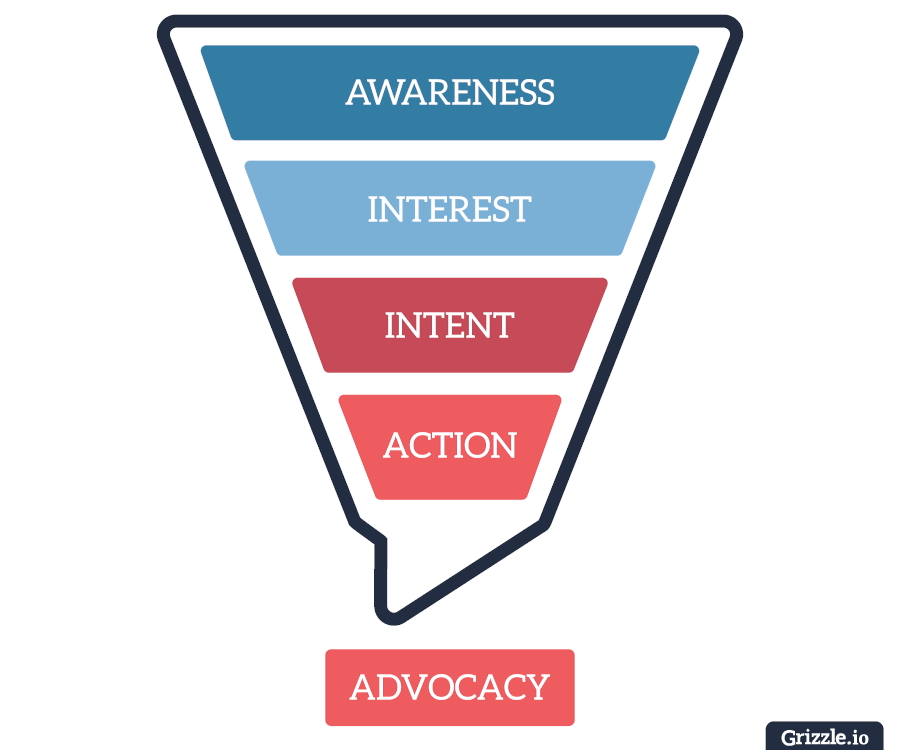
Interview your target audience
Interview your target audience about their challenges to collate a buffet of top-of-funnel content ideas. You’ll uncover nuanced topics that are difficult to pick up through online research alone.
The most recent posts (including this one!) on Grizzle’s blog have come into fruition from this interview method:
- Contact a bunch of people belonging to your target audience that you’d love to interview
- Organise 30-minute calls with 3-5 of them
- During the interviews, ask about their goals, biggest challenges and approaches to problems. Ask lots of follow-up questions to get to the nitty-gritty!
- Make a shortlist of commonly mentioned pain points from your interviewees. You should begin to notice a pattern of nuanced pain points and topics that have emerged
Target audience interviews give you the added benefits of developing long-term relationships with your sector, a deeper understanding of your audience, and quotes you can inject into blog posts (or even a podcast) too.
Crowdsource ideas from your target audience
Databox have a super-organised way of collating ideas from their target audience, as their CEO, Pete Caputa explained to me:
“We collect 100s of content ideas from our writers and readers every month. For most of our content, we are sourcing contributions from experts. We do this by asking 25-50 experts one question, then weaving the best answers together into a long guide on the subject. At the same time, we ask them, “What articles would you like us to write next?” We also invite our freelance writers to pitch us ideas. We review the suggestions and pick the best 5-6 each week”
– Pete Caputa, CEO at Databox
[[component]]
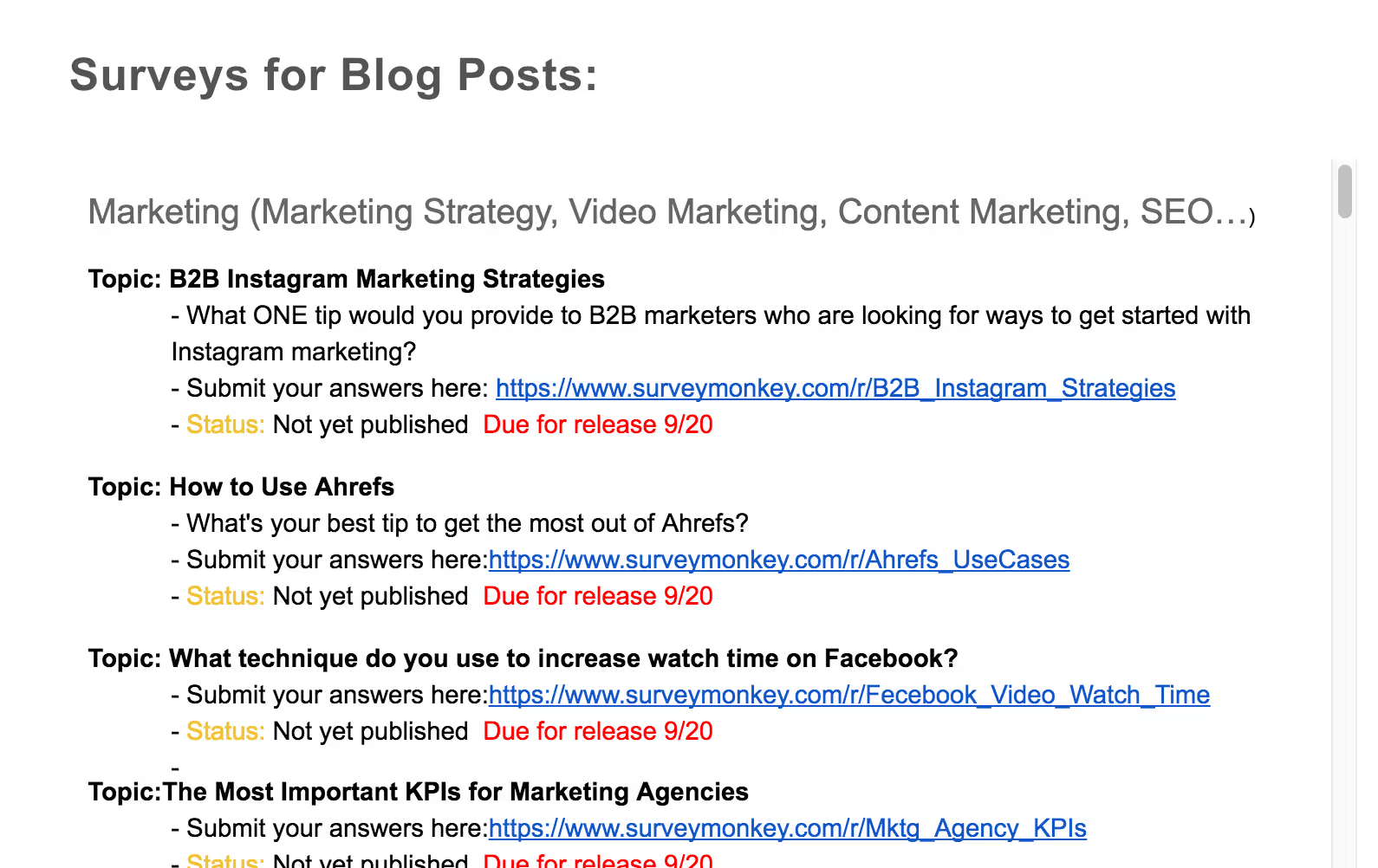
Refresh old content ideas
Sometimes you don’t need to reinvent the wheel when it comes to great content ideas! If you’ve got a backlog of old content, refreshing old posts can do wonders, as Chris from Klaviyo explains:
“I’m a huge fan of going through old posts and re-optimising them with new data and new insights for a new audience. We have a ton of posts going back from 2015, 2016, 2017, and, with just a few optimisations and edits, we can give them new legs. That’s a big goal of our managing editor.”
– Chris Newton, Inbound Marketing Manager at Klaviyo
Identify sharable topics using BuzzSumo
Buzzsumo can help you identify topics that thrive on popular social channels like Reddit, Twitter, Facebook (Quora isn’t currently included).
Let’s say you want to write about topics around the general theme of “social media marketing”. You can run that search term and see the most socially shared posts via Buzzsumo’s ‘content analyzer’ tool.:
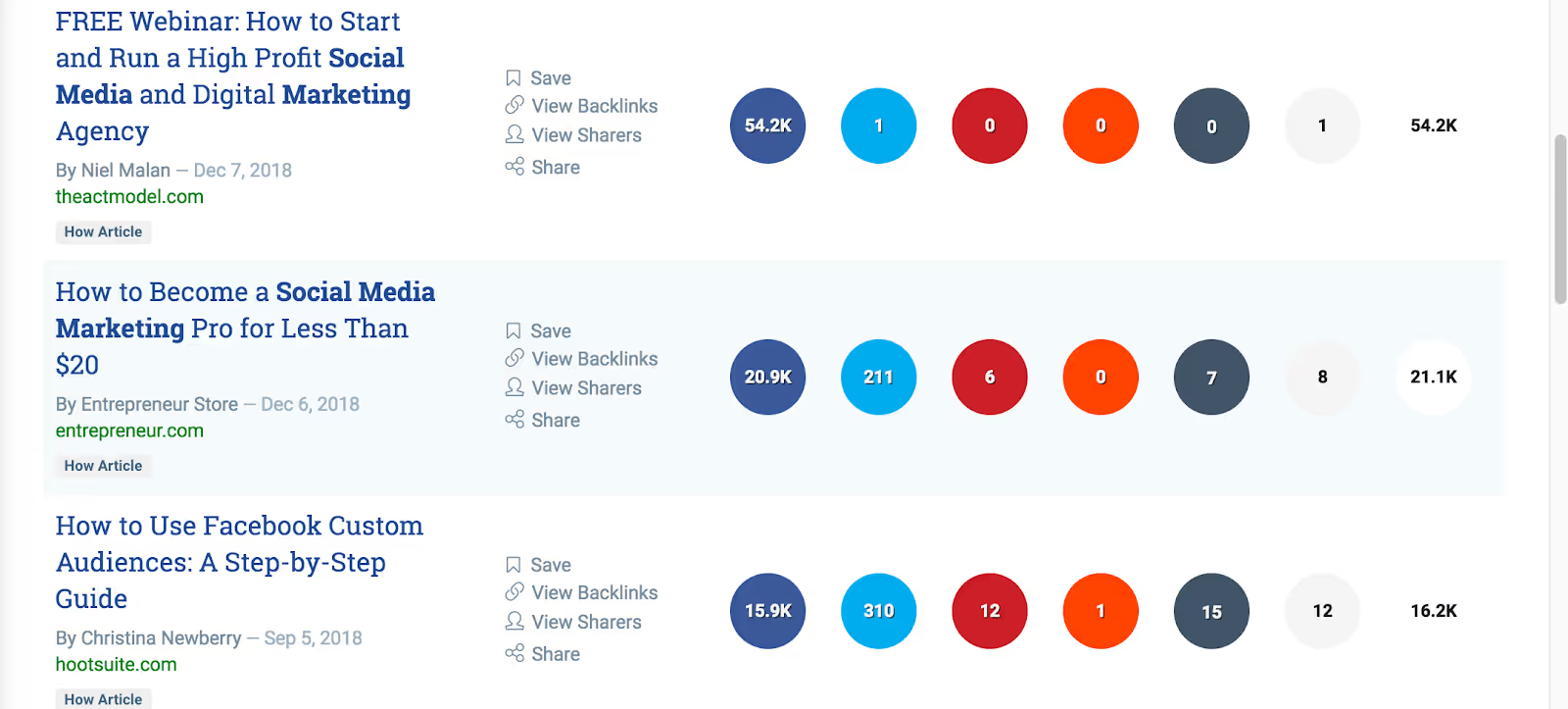
You can identify from this list which topics tend to be more widely shared than others.
You can take that a step further and click ‘view sharers’ for each post:
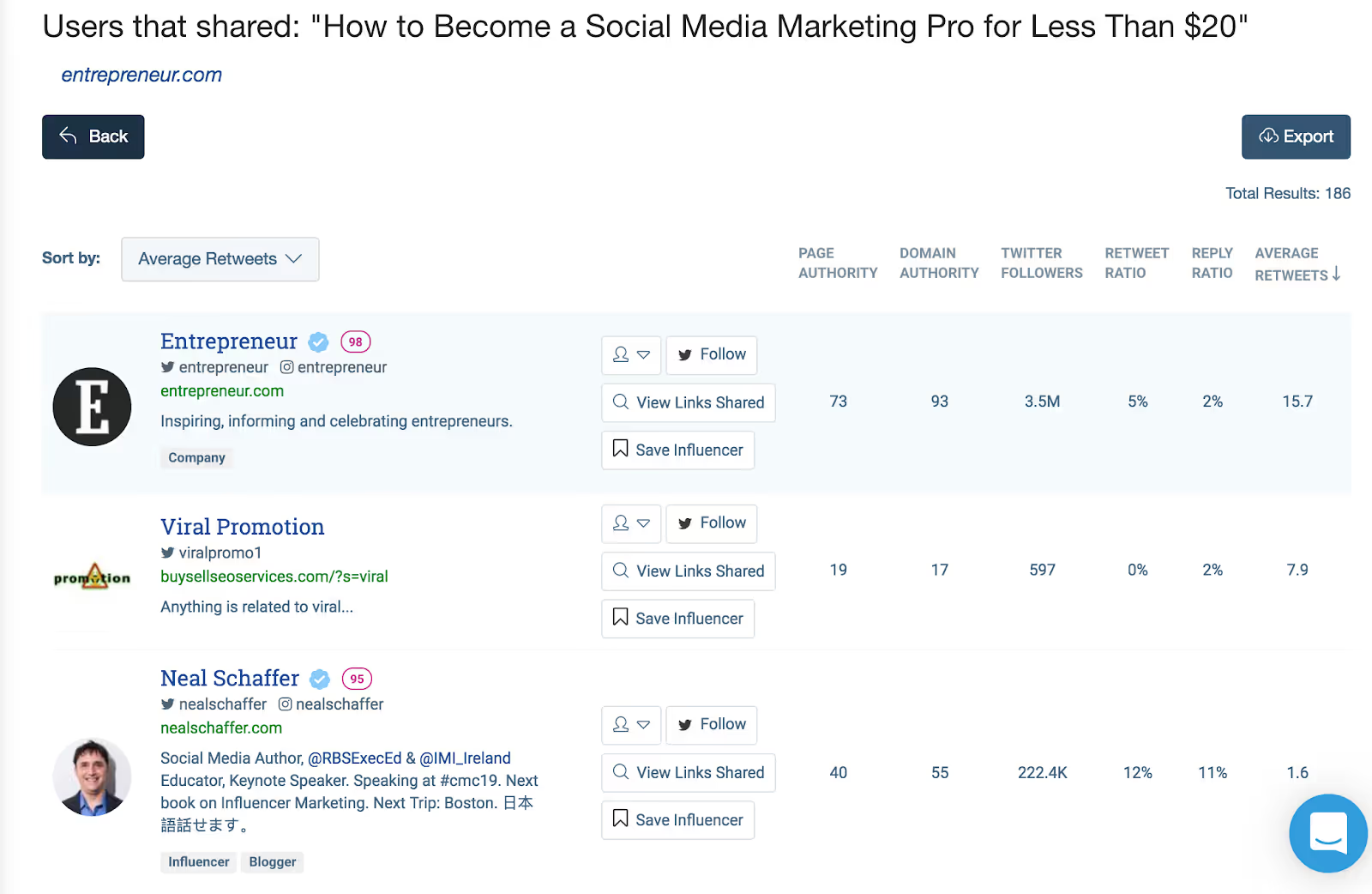
Not only will you identify influencers for certain topics (who you can contact to share your own posts) but you can also look at other content shared by those influencers for further topic ideas. Read more on connecting with B2B influencers here.
Conclusion
As covered, there is no one-size-fits-all approach to content ideation. It’s important to get clear about your goals before choosing a framework for topic ideas.
Here’s a recap of which content ideation frameworks you can use depending on your goal:
Organic traffic goals: SEO-first ideas using search tools and keyword research should be the base of your content ideation. Hub & spoke approaches are ideal for new blogs.
Conversion goals: Run an audit of your product pages and then choose content topics around pain points that your product solves
Target audience engagement goals: in-depth interviews with your target audience will help you identify nuanced pain points and patterns
Social sharing goals: Use a social sharing tool like Buzzsumo to identify which topics are frequently shared across different social media channels
Supporting your sales and customer success teams (lead generation and retention goals): Interview your sales & customer success teams and run audits of current materials.


SaaS and B2B brands must be more discerning with their content and SEO priorities and choose a strategy that builds authority, generates traffic, and drives revenue.
Competing with powerhouse players becomes a non-issue when you narrow your focus to specific, relevant topics. Casting too wide of a net right away won’t help you form a cohesive narrative, and authority will take longer to build.
To accelerate growth and generate quality search traffic, you need to tell a unified story with your content, one chapter at a time.
The best way to do this is with topical authority. It fuels perceived knowledge, establishes credibility, and positions you as an expert worth paying attention to.
Topical authority is critical for accelerating organic growth
When you build authority around a topic with little competition that aligns closely with your value proposition, you emerge as a voice of authority.
Once you’ve built trust, momentum takes over and people begin to pay attention to everything you publish.
By the time you become a go-to resource on a topic, your audience will acknowledge you as an expert in that space.
Topical authority goes beyond perceived value and trust with people—it also signals to Google that your content is important.
That’s because Google algorithmically prioritizes E-A-T (expertise, authority, trust).
EAT plays a key role in how Google determines search quality. It looks at the creator behind the content and how authoritative and trustworthy that author or brand is.
Google understands that people want complete answers to their questions, from credible and non-scammy sources, so that they can have a satisfying search experience.
Topical authority, therefore, is a strategic play to cater to both algorithmic and psychological preferences. For startups, it’s a far better goal to aim for than domain authority (DA) or domain rating (DR).
If you consistently prove your value, your audience and Google alike will consider you a trustworthy source worth holding in high regard. This has two key ripple effects:
- If your content is useful, helpful, and interesting, people will decide it’s worth reading and Google will decide it’s worth ranking.
- If you consistently produce relevant content on a topic, people will decide it’s credible and Google will decide it has a high level of expertise, authoritativeness, and trustworthiness (and continue to rank it).
As such, topic clusters are the preeminent vehicle to demonstrate knowledge and expertise, accelerate search visibility, and enter the consideration set with your ICP—even in competitive markets.
We followed this strategy with an asynchronous communication SaaS client. Here’s an example of what happens when we publish competitive and commercially-relevant articles on meeting-related topics:

Compare this to another article in the broader “remote working” space:

The meeting-related article ranked on page one within the month. Conversely, the broader remote working article fluctuated between positions 42 and 21 from August until April before stabilizing between positions 9 and 11.
Could we have improved the performance of the broader article? Yes, but that’s not where our priorities lay.
Our goal is to generate relevant traffic and turn SEO into a revenue generating channel, which can only be done by building topical authority in a space aligned with our client’s value proposition. And it works—the blog is responsible for ~33% of new user sign-ups.
Relevant content amplifies the impact of your resources
When you focus on one topic cluster at a time, results compound across all content assets.
For example, say you offer candidate tracking software for hiring managers. You may wish to focus on creating content around the topic cluster “talent acquisition”. This effort will compound the more you publish content within this topic (as demonstrated in the example above).
If you were to produce 12 articles on various HR-related topics, on the other hand, you’d merely dip your toe in each pool, slowing down the speed at which you build topical authority.
Critically, topical authority also helps you gain more quality backlinks. If your brand becomes an industry authority known for sharing quality information, people are more likely to link to your content (more on why and how to do this later).
This is how sites with low DA or DR can rank amongst established players—they’ve reassured Google that the content will meet and exceed search intent.
How to build compounding topical authority using the Hub & Spoke model
The hub & spoke model is how you generate and distribute content around a topic cluster. The hub covers the baseline topic (usually a cluster of high-volume or competitive keywords), while the spokes cover specific topics nested below it (often lower-volume and long tail in nature).
When you strategically organize the relationship between your content, you create structure and cohesion.
To get it right, you’ll need to:
- Conduct keyword research and organize them into clusters
- Meticulously map out how these keyword clusters relate to each other
- Identify the purpose of each article (the traditional funnel is a good model for this)

The hub serves as a “home base” while acting as a long-term traffic play. It may take longer to rank, but your chances multiply by covering other areas of the topic.
With keywords in hand, you can get to work.
1. Prioritize topics that align with your solution
Start with your audience’s biggest jobs-to-be-done (JTBD). Provide relevant, helpful, and intriguing content that:
- Presents new and better ways of doing things
- Positions your brand an an authority
- Promotes your solution as the best choice to solve their problems
When you produce comprehensive and topically relevant content, you’ll develop brand equity that drives leads, users, and advocates.
Returning to our candidate tracking software example, we chose the hypothetical “talent acquisition” topic cluster because HR (and even “hiring”) has lots of search opportunities but it’s too broad. You could write about onboarding, company culture, relationship management, etc.—all of which are broad themes of their own.
When it comes down to it, “talent acquisition” would be the primary JTBD for this audience. Candidate tracking software helps buyers improve their talent acquisition workflows and experience.
A “talent acquisition” hub, may cover topics like:
- Candidate experiences
- Interviewing candidates
- Job descriptions
- Talent acquisition workflows
- Applicant tracking systems
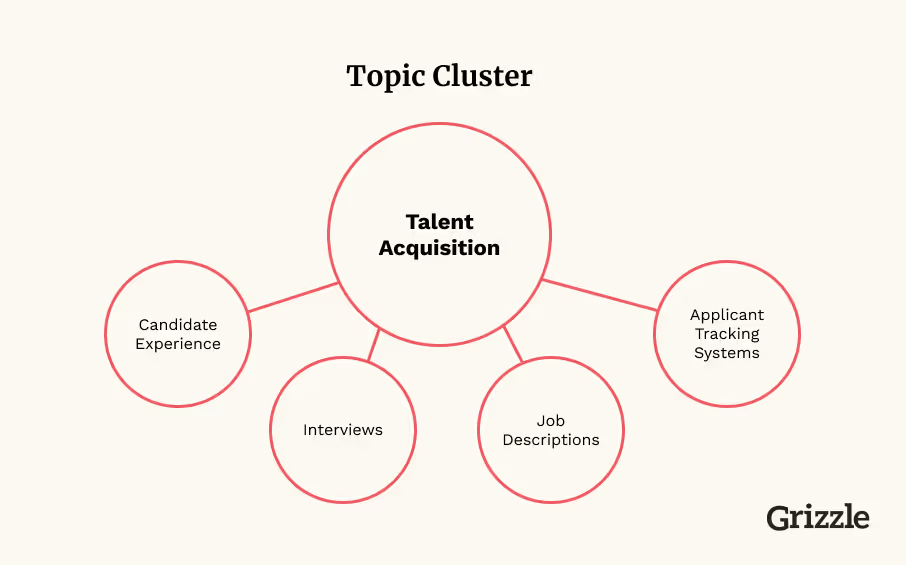
These subtopics align with their product because it directly relates to improving hiring workflows. It also gives them an opportunity to plug their product by showcasing exactly how to use it to build efficiency into the acquisition and interviewing process.
In all, the reader is taken through a helpful journey that motivates them to take action. That could be to read another topic in the cluster, subscribe to a newsletter, or even sign up for a free account (if you’re growing a product-led brand). Topics lower down the funnel might offer demos, consultations, or free trials.
2. Map your topic clusters
By this point, you’ll have various topics that tie to your customer’s goals and pain points. Next, identify which topics belong together in their respective cluster and which will act as the hub.
For example, if you’ve identified various topics around VAT, we can verify that VAT is the hub while specific topics and long-tail keywords like “How much is VAT?” are the spokes.
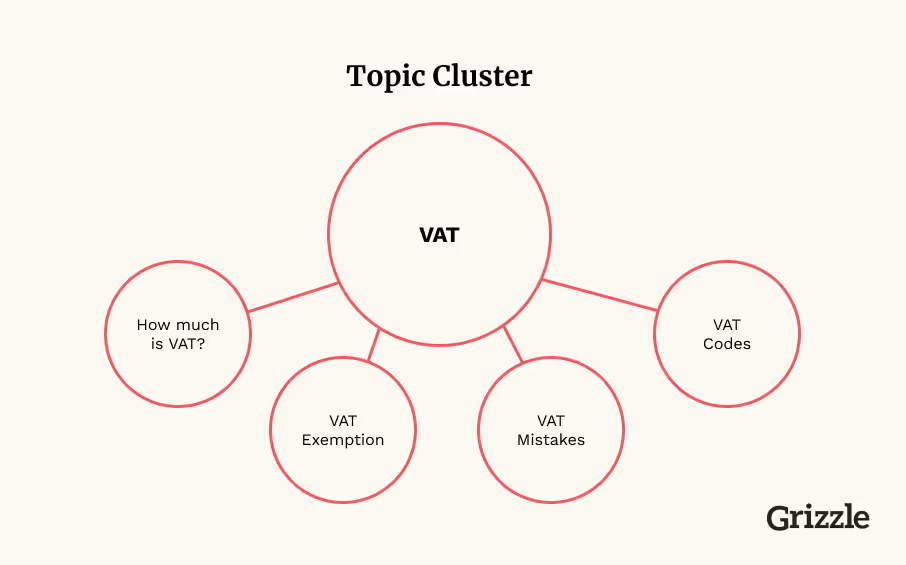
Use keyword clusters to group topics together. This is where queries are “batched” based on search intent and patterns in the SERPs. Tools like Keyword Insights can make this process easier.
For example, if we search for “omnichannel marketing” and “omnichannel marketing examples,” we get the similar results:
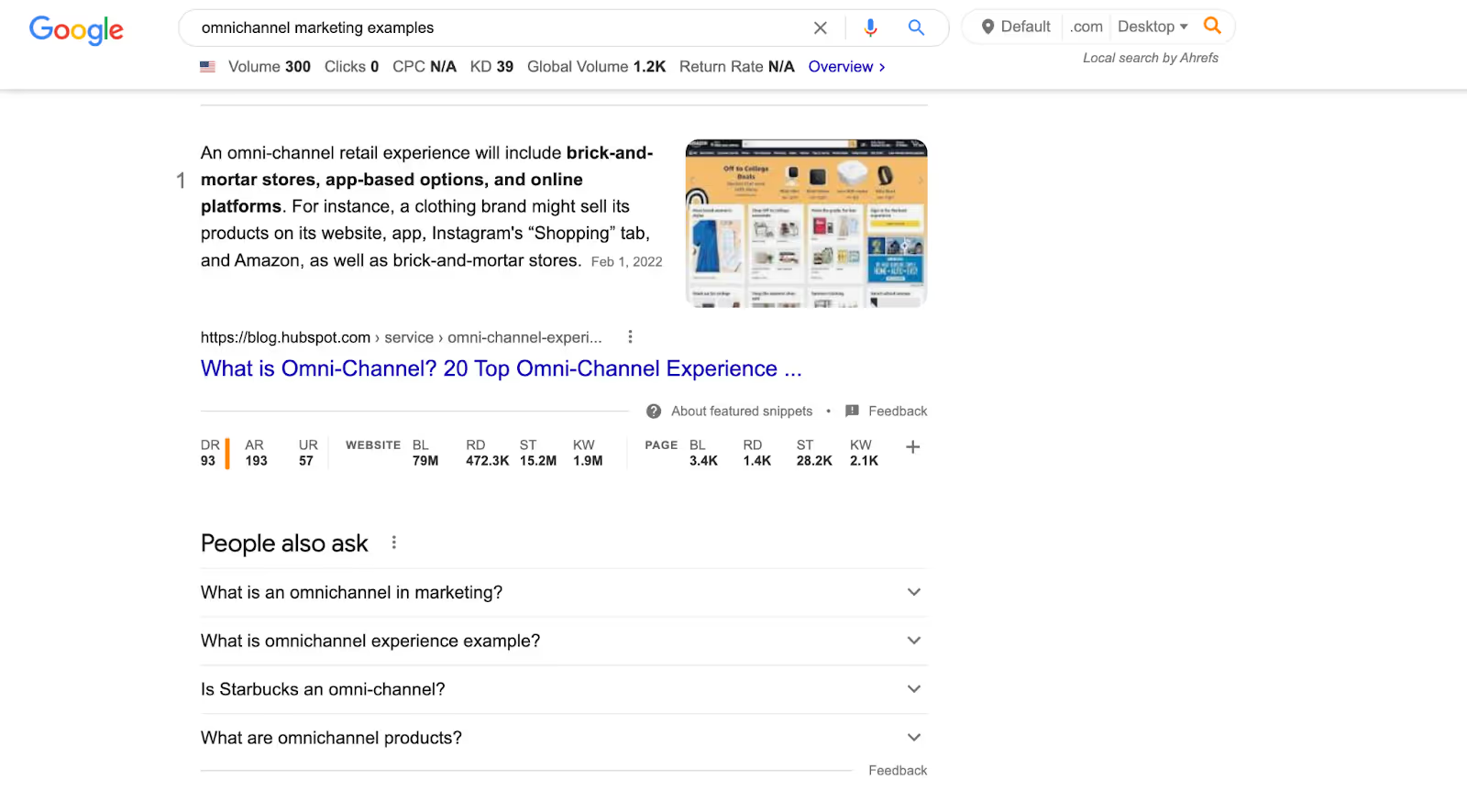
This model will also inform your internal linking strategy. This helps Google determine the relationship between your content and also provides a more helpful (and seamless) experience for readers. It’s also critical for maximizing the impact of your link building, which we’ll cover shortly.
Done right, an article will answer questions fully, but if readers want to learn more, they can click on strategically placed internal links to do a deeper dive.
Within an “Ultimate guide to VAT,” for example, readers can learn more about “How to calculate VAT” by clicking on an internal link or a more prominent “read more” design component.
This removes the need to head back to the SERPs—everything they need is presented to them from a single result.
3. Create content that caters to every stage of the funnel
Your hub & spoke content should touch on every stage of the buyer journey, from awareness to decision.
For example, within the “talent acquisition” hub for our SaaS candidate tracking startup, here’s how we could position spokes throughout the journey:
- Top of funnel: “What is talent acquisition?”
- Middle of funnel: “Best applicant tracking software”
- Bottom of funnel: “Breezy HR alternatives”
The topics move from problem-aware (I need help attracting and recruiting top talent) to solution-aware (I need a tool that helps me manage candidates and improve the hiring experience) to product-aware (evaluating several tools from their consideration set).
We advise creating a balanced content portfolio and steady production cadence across the entire funnel. This will allow you to gain traction on more competitive terms, take advantage of quick-and-easy wins, and generate users and revenue from those middle and bottom of funnel topics.
4. Focus on quality over quantity to signal trust
Bad content ruins a good strategy. You’ll never drive leads and revenue if you can’t provide your audience with helpful, memorable, and unique experiences.
Quality content is critically important—perhaps now more than ever before. According to Semrush’s State of Content Marketing 2022 Global Report, 61% of respondents reported that “making content more authentic” helped their content rank organically.
And Google’s helpful content update also makes it crystal clear that content made for humans, not search engines (and not simply for the means of ranking) will outperform the rest.
Quality content isn’t possible without strong editorial standards, rock-solid workflows, and a team of A-players. Learn how to build the foundation necessary to scale content production.
The trend towards choosing relevancy over top positions in the SERPs is a decade plus in the making.
In 2007, an eye-tracking experiment revealed that people trusted Google’s rank results more than their rational judgment. If it was in position one, it was assumed relevant and click-worthy.
Fast forward ten years: researchers replicated the experiment and discovered people now prioritize relevance over positioning. Eye-tracking results show that positioning still influences consideration, but ultimately people make decisions based on how relevant the content is for the problem they’re looking to solve.
The takeaway is clear as day: a content strategy that prioritizes both what Google and humans want is key to accelerating organic growth.
5. Generate backlinks to accelerate visibility and build credibility
While quality content is critical for generating links, it’s just one piece of the puzzle. You must develop ideas around topics that editors, journalists, and other content marketers want to link to. Data-driven, reactive, or thought leadership content are the best ways to do this for SaaS brands.
When your hub-and-spoke strategy and digital PR campaigns join forces, you can quickly increase your domain authority and pass it on to the rest of your topic cluster:

Here, the data-driven article is what attracts the most links. Intelligent internal linking is used to pass on page authority to the rest of the content hub.
For example, for our candidate applicant tracking example we could run a survey of HR leaders and generate insights like:
- How much time they spend on applicant tracking
- How many stages are in their hiring pipeline
- How much time they spend interviewing applicants
This data can then be packaged up in a report and delivered to journalists as part of a digital PR campaign.
[[component]]
Topical authority is the gift that keeps on giving
Once you build topical authority for your first cluster, your hard work will trickle down to its successors.
The more credible you become, the more likely Google will rank and people will want to click on, share, and link to all of your assets.
This collective vote of confidence will help you ride the wave to increased traffic, leads, and revenue. It all starts by understanding the JTBD of your audience and marrying those insights with keyword clusters to build relevant topic clusters.


So much content created for buying committees completely misses the mark.
It’s overloaded with fluff—a symptom of marketers putting word counts and search rankings before readers and outcomes.
Instead of being genuinely useful or persuasive, content is flooded with generic and unsubstantiated claims. While intended to build trust, strategic content dwells in the theoretical with little or no original value.
It’s why the C-suite have become skeptical and distrusting of most B2B content. Much of it lacks the insight and credibility to warrant their attention.
To them, you’re just another marketer promoting messages they’ve seen a hundred times.
So, how do you cut through the noise to inspire action from your ideal customers?
SCQA: the framework that helps you break through the noise
You need to connect with senior audiences rapidly, paint a picture of the promised land, and guide them there with minimal friction.
Enter SCQA.
SCQA is a simple messaging framework for creating content that stands out, speaks directly to senior executives’ needs and interests, and gets them excited about your solution.
Its four elements create a logical story flow to keep readers engaged to the last word:
- Situation. Your audience’s present reality. Something happening in the world that impacts their objectives, whether they realize it or not. It could be a long-term problem or a recent change in circumstances, but it’s top-of-mind and affects your buyer’s priorities.
- Complication. Why your audience should care about the situation, if they don’t already. What is it about that present reality that’s stopping them from achieving their goals? What should they fear and why do they need a solution? Cold, hard facts help your arguments hit home. Owned or third-party data adds credibility.
- Question. A direct question or statement that bridges the gloomy complication to the bright, sunny promised land of your solution. It’s a change of direction that excites the reader. It gets them thinking, “I need to keep reading.”
- Answer. The core of your message. Your answer acts as the solution that addresses the question. In content marketing, it’s sharing a new strategic way of thinking that will lead readers to make a decision—perhaps even to move forward in their buying journey.
SCQA’s origins are in business consulting. Barbara Minto, then at McKinsey, popularized the framework in her book The Pyramid Principle as a way to ensure consultancy reports resonate with their audiences—the same senior executives you need to reach.
By meeting readers where they currently are and addressing specific pain points, you produce content that truly connects with their priorities.
And we know SCQA works because it helped Grizzle secure its first clients.
We used it to structure a one-page website selling guest blogging services back in 2016, promoted it via an outreach campaign, and converted 4% of prospects into sales deals within two months.
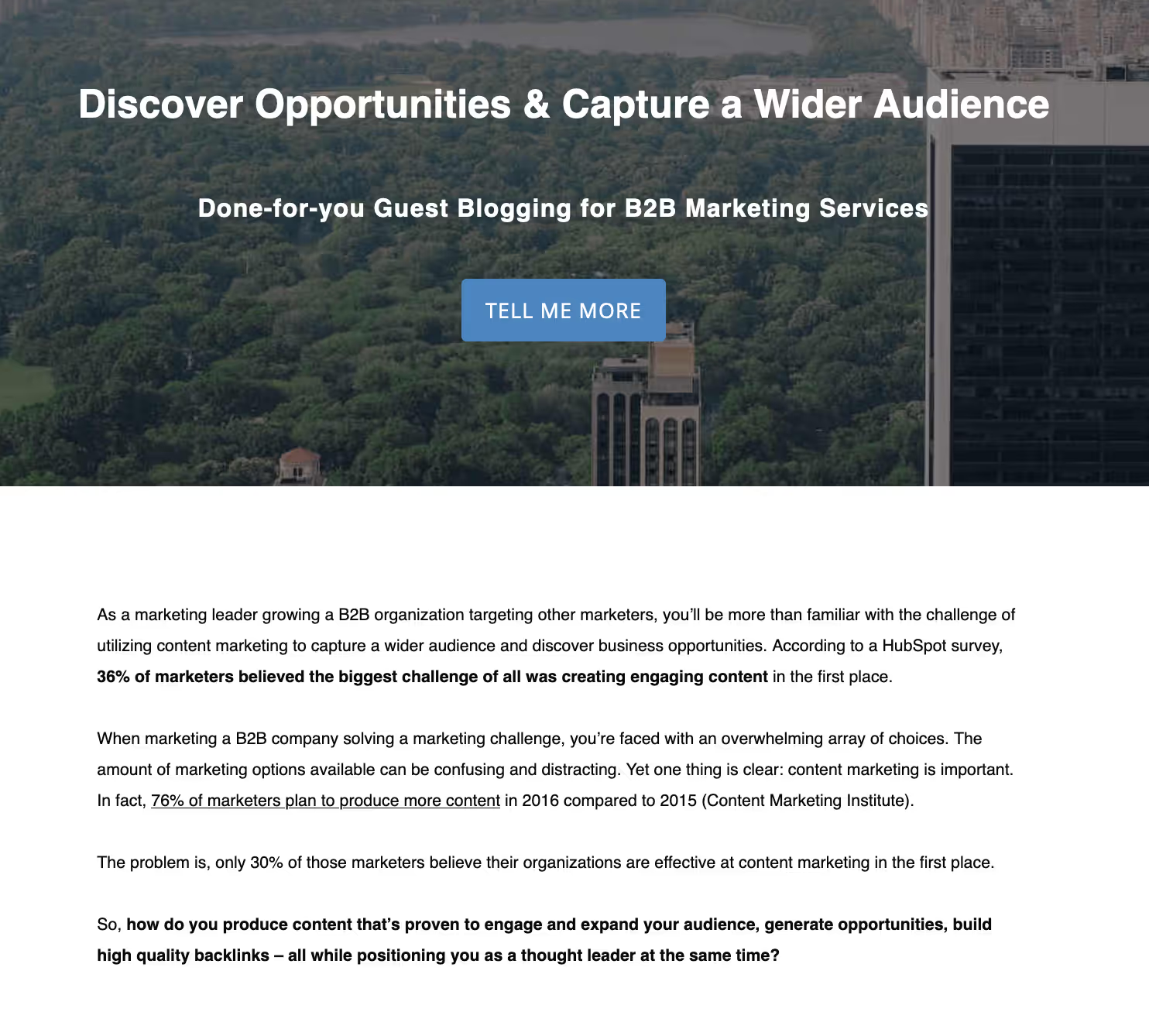
Admittedly, this landing page broke every copywriting rule in the book. But that didn’t matter. The framework did the heavy lifting, communicating everything our audience needed to know in a logical and captivating way.
The point? However you’re trying to reach the C-suite—be it through landing pages, blog articles, or email outreach—SCQA is effective.
Here’s what each step involves:
Further reading: Learn how we helped this c-suite marketing company get featured in leading publications and generate six figure sales opportunities using SCQA and digital PR.
1. Situation: Meet your reader on their playing field
Set the stage by showing you understand your audience’s current reality.
Lead with a statement your reader agrees with to demonstrate that you understand them. Gain trust by immediately positioning yourself as a peer.
Just make sure what you say is specific. Avoid basic platitudes and overtly obvious facts that any marketer could come up with—otherwise, you’ll just blend in.

A Forrester survey found industry peers to be B2B buyers’ most trusted source of information. Salespeople were the least trusted group. Another solid argument against beginning relationships with self-promotion.
We're not always able to position ourselves as peers. For many marketers and brands, it's tough to escape the perception of "vendor." But laying common ground early in your messaging makes you relatable and trustworthy.
For example, our content production landing page leads with this situation:
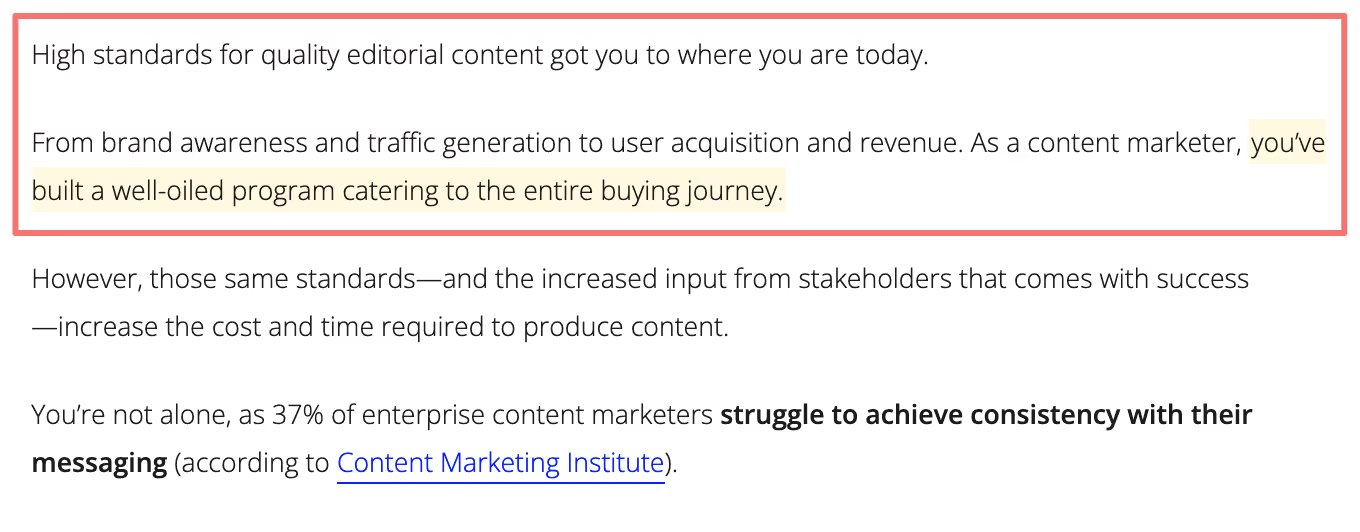
It’s simple but the message is clear: “We understand you, your industry, and the problems you face.”
The narrower your audience, the more precise your situation can be.
Reactive content can be great for this—prodding a new issue that’s affecting your ICP right now.
Like this Optimizely landing page that targets users of Google Optimize (the sunsetted A/B testing tool) who’ve been left without their go-to platform:

Optimizely knows its audience relies on experimentation programs and worries about falling behind. By highlighting that situation before presenting the solution, it got the reader nodding along. It established common ground, making them more open to hearing what it had to say next.
Other times, you can fall on your readers’ side of a polarizing argument to build a connection. Like we did in this blog post on backlink acquisition:

Even today, the number of spam link outreach emails we receive suggests that not everyone agrees with this statement. But we know our target audience does. As long as those people are on our side and interested in reading the rest of this article, that’s all that matters.
2. Complication: Introduce an unknown pain point
Now explain how the situation stops your reader from reaching their goals.
They might have an idea already. Even if so, spark that “oh shit” moment by presenting the consequences. Make them need a new way of thinking or working. Build a barrier.
For example, when Google changes its ranking algorithm (a seemingly regular “situation” in marketing right now), most marketers know they must adapt to protect search performance.
We won’t spark any emotion or urgency by dwelling on what the reader already knows.
So instead, what are the ramifications of not acting?
The complication isn’t just that search performance drops. It’s that marketers lose website traffic. Which affects revenue, lead generation, and even brand awareness.
Revenue is what marketers are measured against by their bosses. Tying their situation to that ultimate consequence makes them realize they need a solution, fast.
Here’s the complication we presented in our link acquisition article:
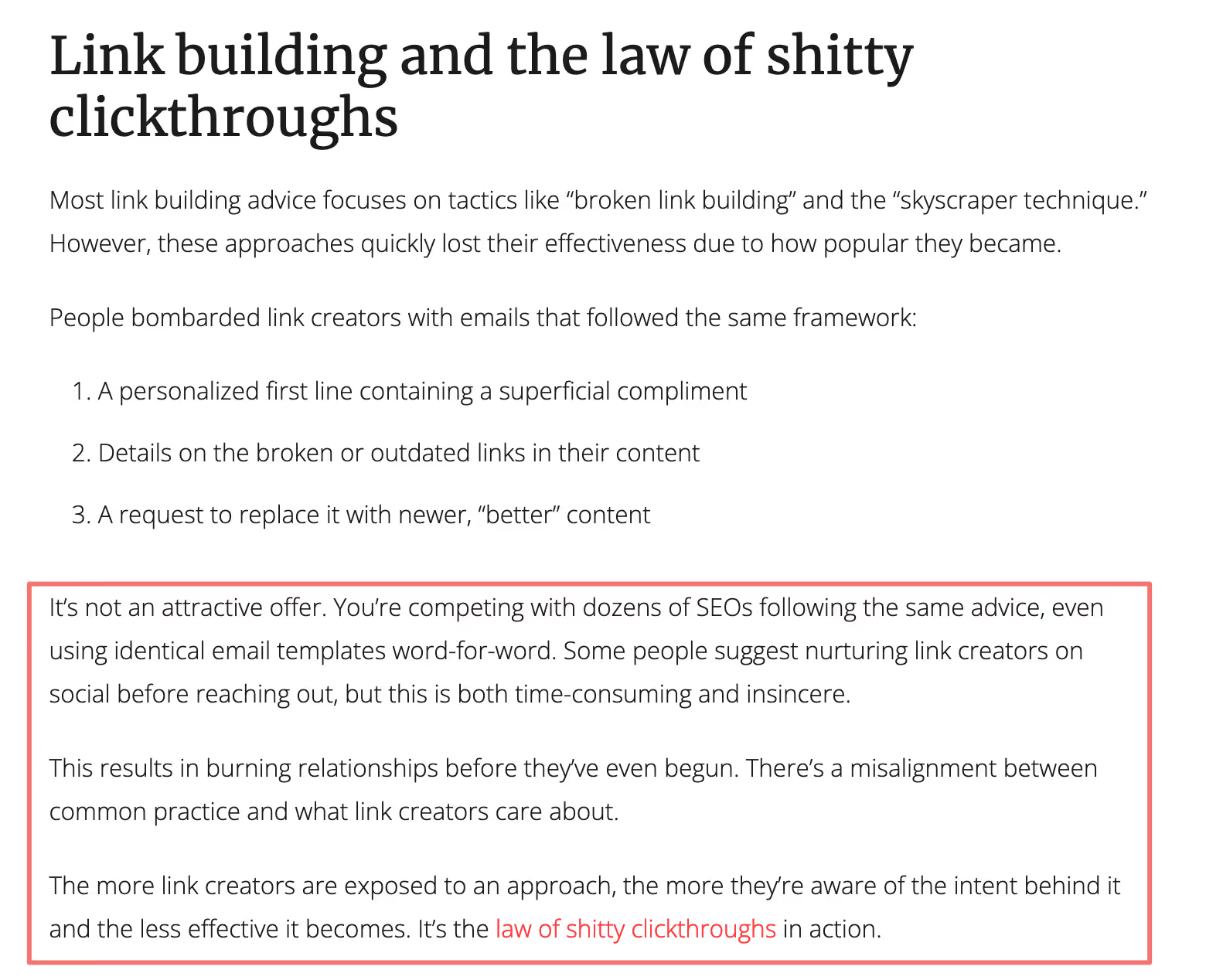
We show marketers how their situation—the waning effectiveness of spammy link building—is damaging: following outdated advice on the topic is “time-consuming” and results in damaged relationships.
This is why our readers should care, and why they need a new approach. Our approach.
3. Question: Spark intrigue and build a bridge
Enough woe. It’s time to offer your audience a ticket to the promised land.
By planting a desirable outcome in readers’ minds, you’ll keep content flowing smoothly and logically while shifting the tone to one of positivity and results.
You’re setting the stage for your content’s answer: the core value you’re offering.
Here’s the question element from our landing page. In this instance, we use two direct and precise questions to encourage prospects to continue reading:
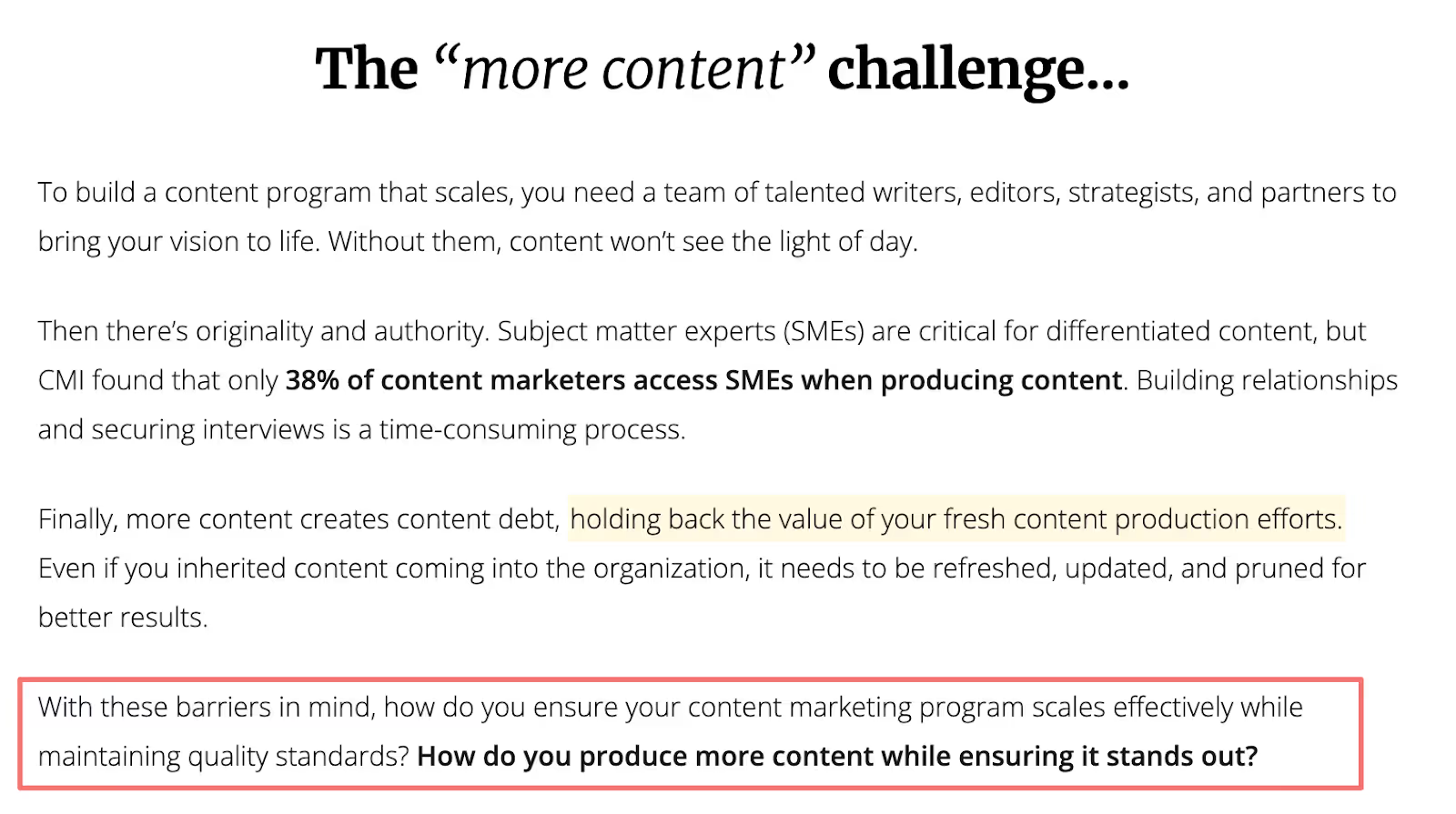
It’s only two lines. But they offer a bridge to the promised land, signaling the value to come. Which in this case is Grizzle’s content production methodology.
This bridge isn’t always a literal question. Statements can be just as effective at re-hooking readers and earning their attention.
As a content and SEO agency supporting SaaS companies, we often serve and educate senior audiences with strategic topics.
It involves highlighting the complication of a situation the reader already knows, then transitioning to a step-by-step workflow or piece of advice (i.e., our answer) by explaining what’s in store.
Like in Pipedrive’s guide to CRM implementation:
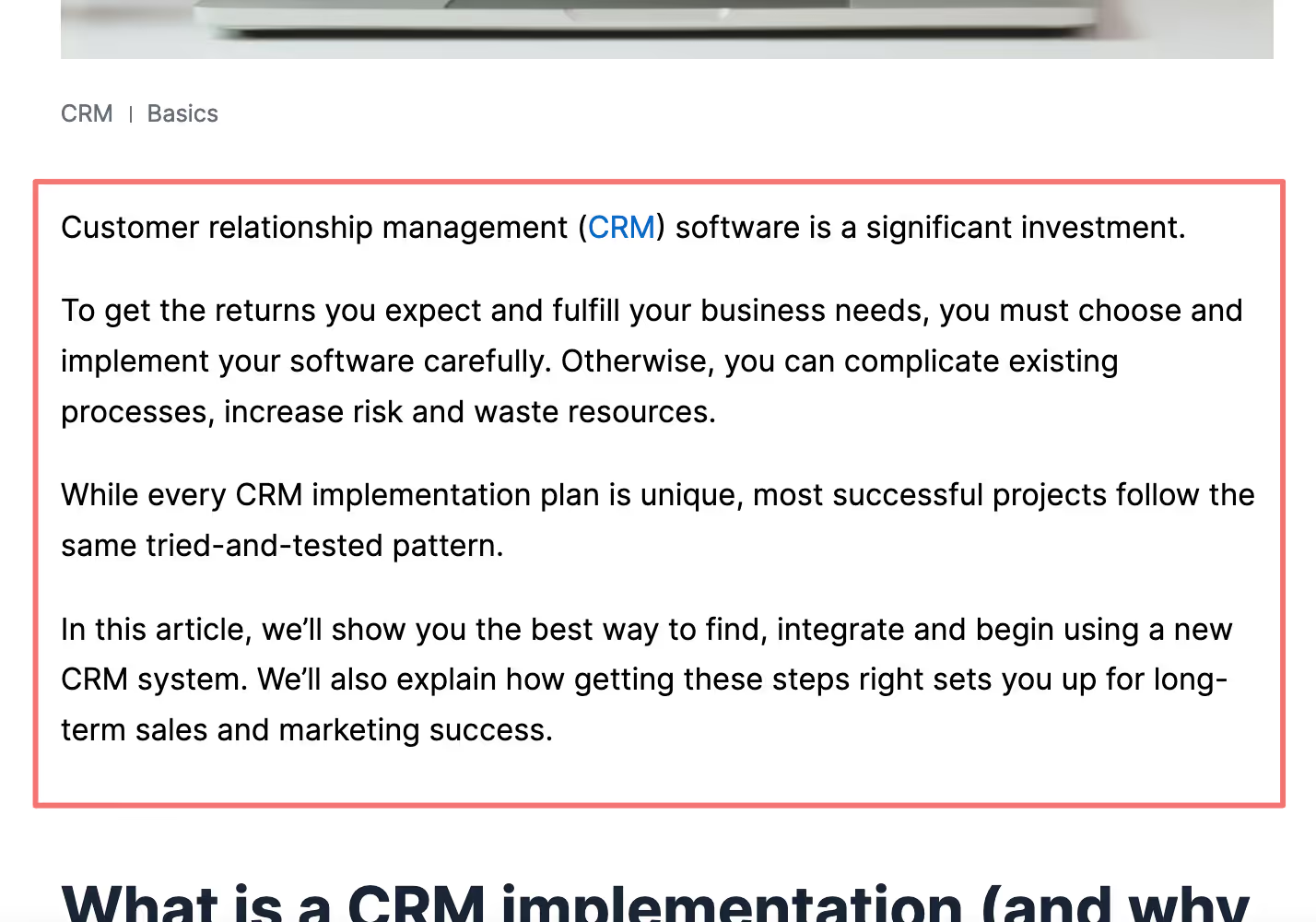
The reader knows they need to implement a CRM. That’s why they’re looking for guidance on the topic. The complication is that reckless CRM implementations “complicate existing processes, increase risk and waste resources.”
So, how does Pipedrive carry the reader from that concerned state to a solution without losing the flow?
By previewing the answer with a statement: “In this article, we’ll show you the best way to…”
Now their senior audience knows what to expect. They can decide if the content is worth their limited time. Pipedrive ensures this by providing relevant, actionable advice on CRM implementation.
4. Answer: Pave the way forward
Now you’ve set the stage and made a promise. The rest of your content must provide the solutions or insights that address your complication: the better world you’re promising.
In content marketing, “answer” always means value. And value takes various forms, often depending on the type of content you’re creating.
In a promotional landing page or cold email, your answer is likely the outcome or solution your product or service offers. The next step or action will be to sign up for a trial, demo, or even make a purchase.
Our content production methodology, for example, is the first part of our answer to the questions we asked earlier: “how do you ensure your content marketing program scales effectively while maintaining quality standards? How do you produce more content while ensuring it stands out?”
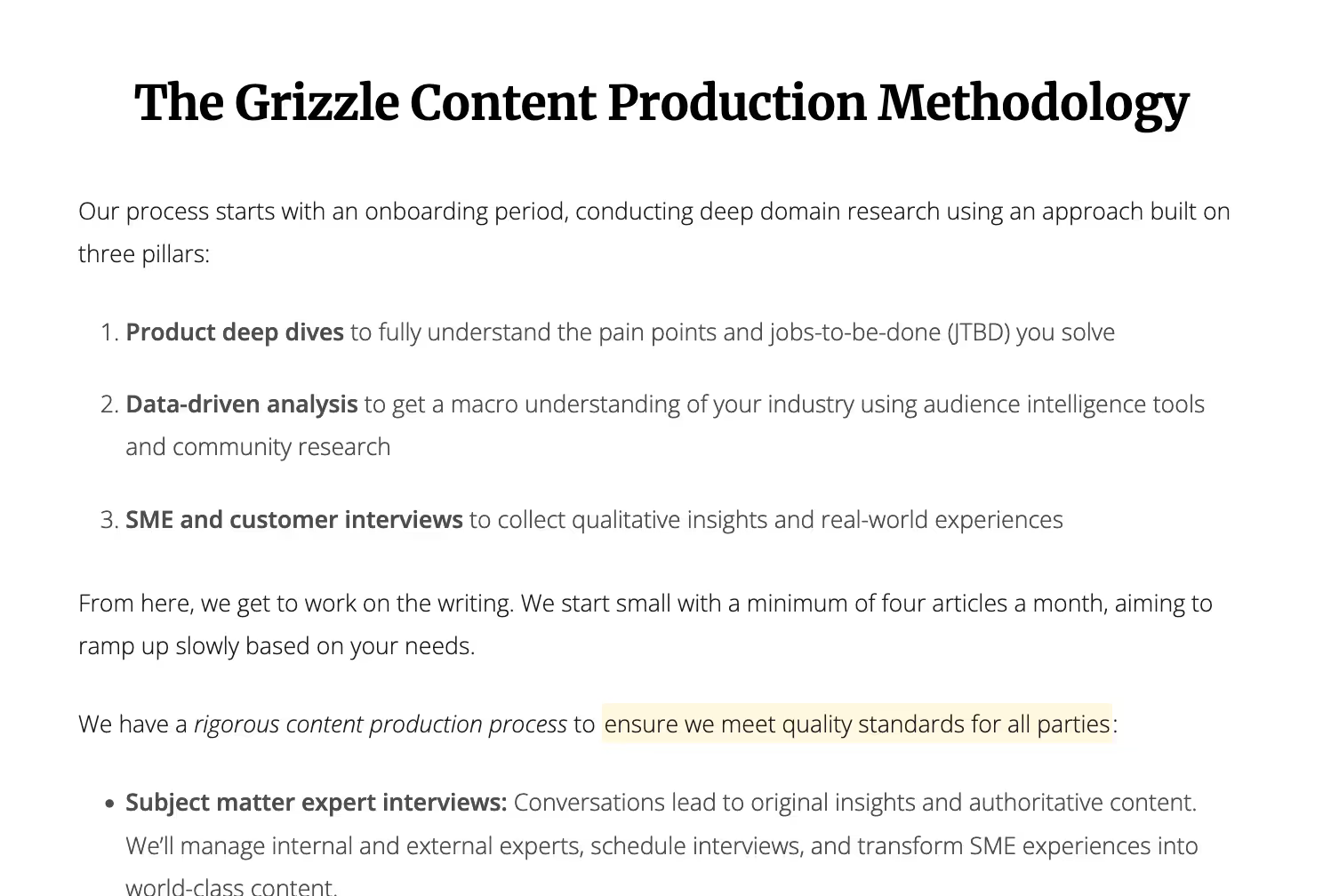
Then we help the reader move closer to a buying decision with a simple call-to-action:

In Pipedrive’s CRM implementation article, the content is designed to perform well by being immediately useful to decision-makers. Namely CIOs, and marketing and sales leaders.
Instead of a product or methodology, the article answers the question with straightforward, prescriptive guidance that helps the reader optimize their CRM and achieve their objectives.
Once again, the answer = value to the reader.
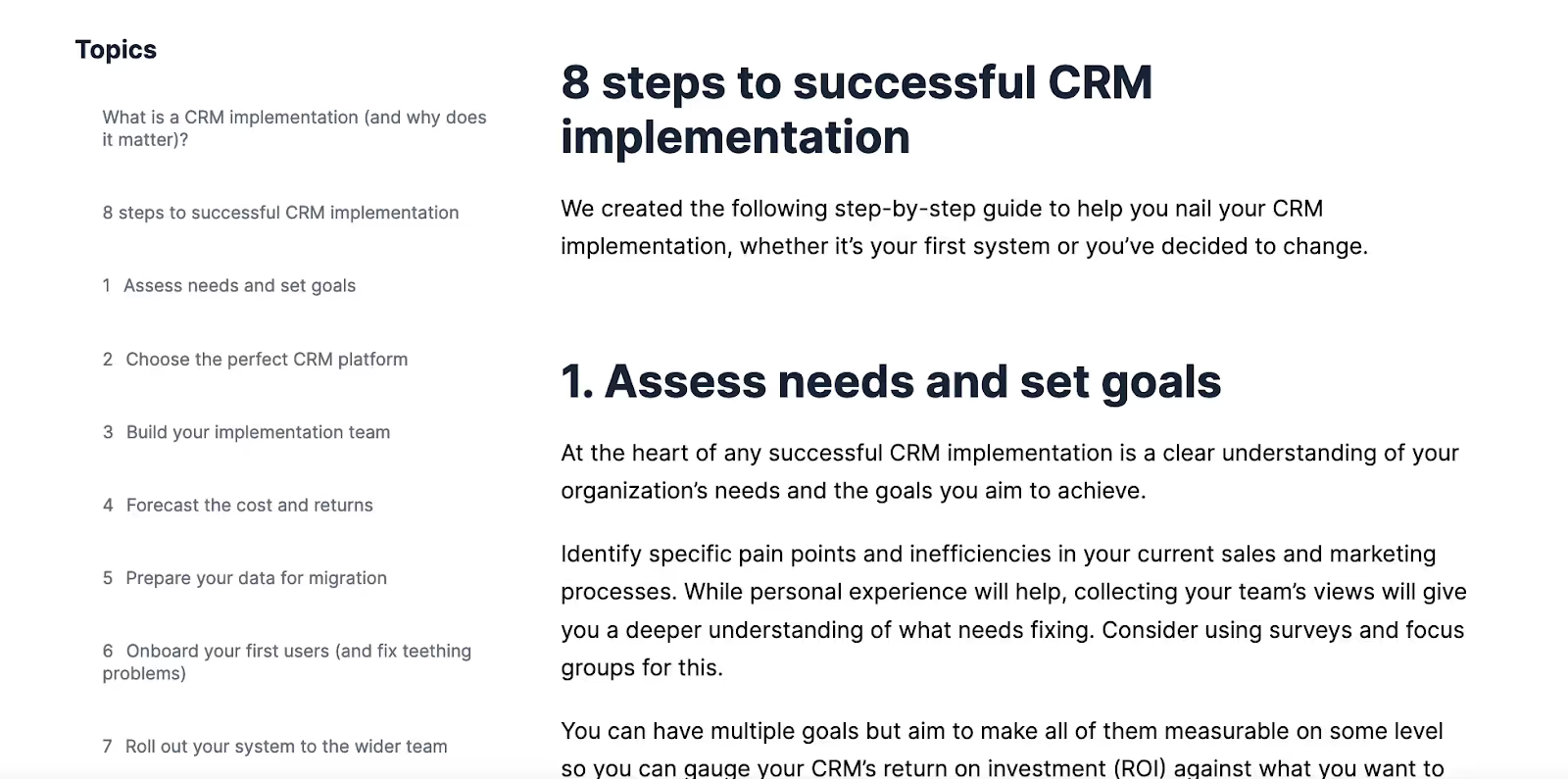
There’s growing demand among senior decision-makers for non-promotional information. In a 2023 Demand Gen Report survey, 71% of B2B buyers said they use content to guide their purchase decisions but 51% said the assets they found were too “sales-driven.”
Meanwhile, blog posts, webinars, and long-form content were the top three preferred content formats among respondents.
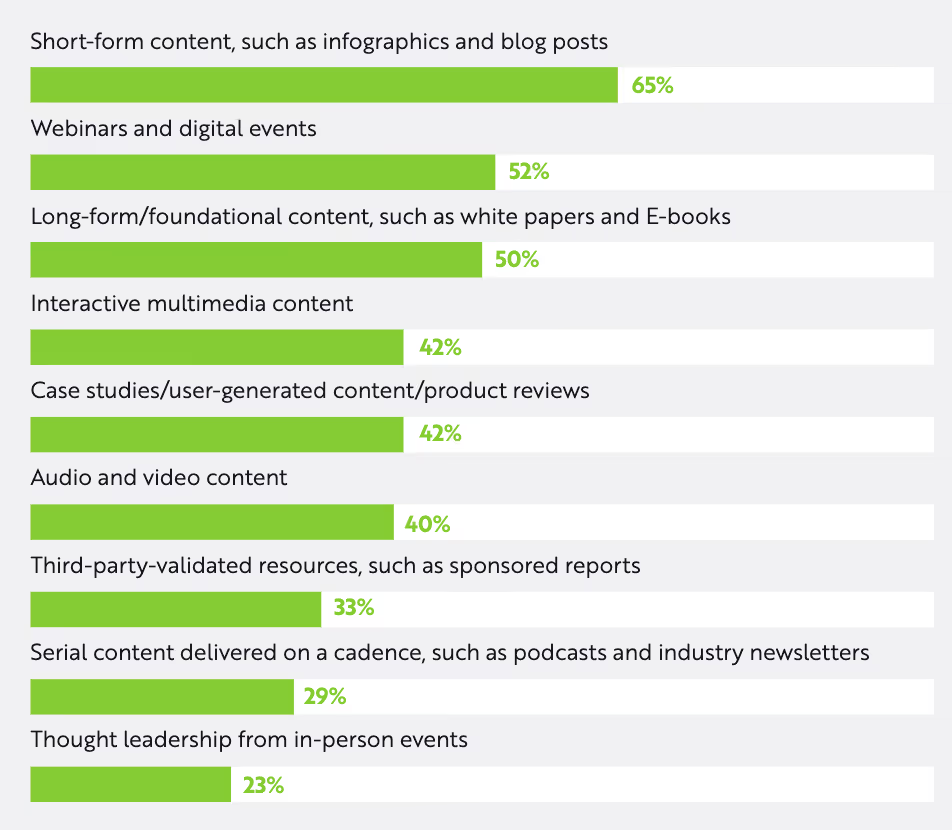
Even then, not all respondents consider “helpful” is genuinely valuable to its target audience.
To stand out, you need to cut through heaps of useless, repetitive content that decision-makers are actively avoiding. That means bolstering your “SCQA” answers with value they can’t get elsewhere.
The best ways to do this?
- Demonstrating the first-hand experience C-suite executives crave when they seek advice
- Backing up opinions with reliable first- and third-party data
- Weaving expert views and experiences into your content
Think success stories with tangible results and unique insights drawn from industry research. Or in our case, anecdotes about launching guest blogging services with single-page websites in 2016.
[[component]]
Guide senior execs to the promised land
We intentionally used the SCQA framework when writing this article. The fact you’re still reading (or skimmed this far down) is a testament to its power.
Here’s what SCQA looks like when applied to this article:
- The situation is that B2B marketers must engage senior decision-makers to influence buying decisions.
- The complication is that most content looks the same and offers little value, so your target audience won’t pay attention.
- The question is “How do you cut through the noise to inspire action from your ideal customers?”
- The answer is SCQA.
If senior decision-makers form any part of your target market, think carefully about how you interact with them. Whatever the context.
Structure your messaging in a way that forces executives to care what you have to say. You’ll soon start attracting your ideal customers, gaining their trust, and closing more deals.


It’s about helping users achieve their goals and creating trust-building customer experiences.
In this article, you’ll see why you should feature your product in your content. You’ll learn the step-by-step processes to create product-led content in a tactful way that not only generates users, but activates and retains them.
What makes product-led content so valuable?
Product-led content embeds your tools and solutions within the context of your blog posts, webinars, value-driven guides, podcasts, and more. It educates your audience by showing how they can solve their problems (both with and without your product).
For example, product experience platform Appcues created a blog post on in-app messaging:
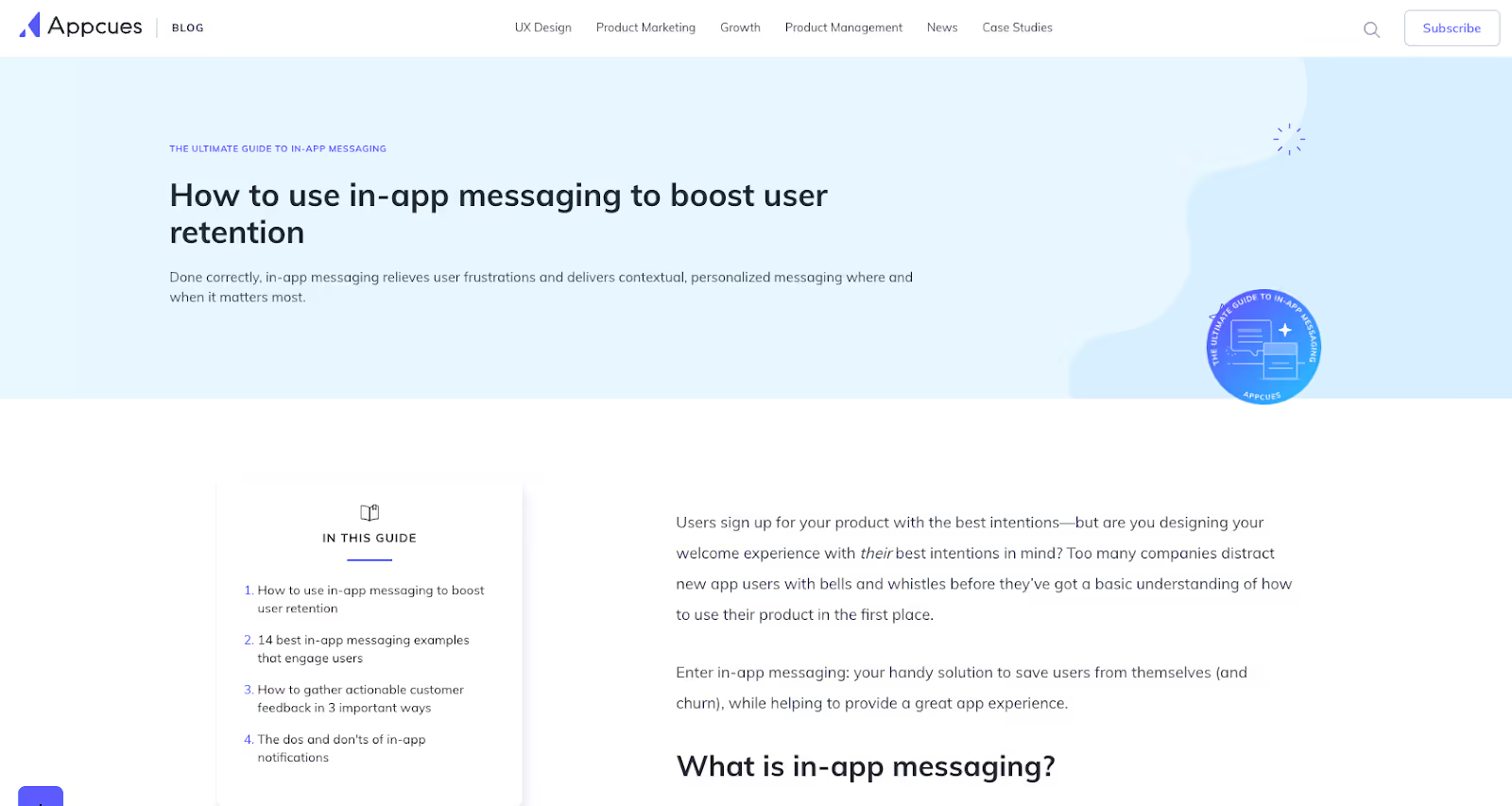
Within the first section of the article, Appcues teaches readers about the importance of tooltips during the onboarding process.
Not only that, it shows them what good tooltips look like:
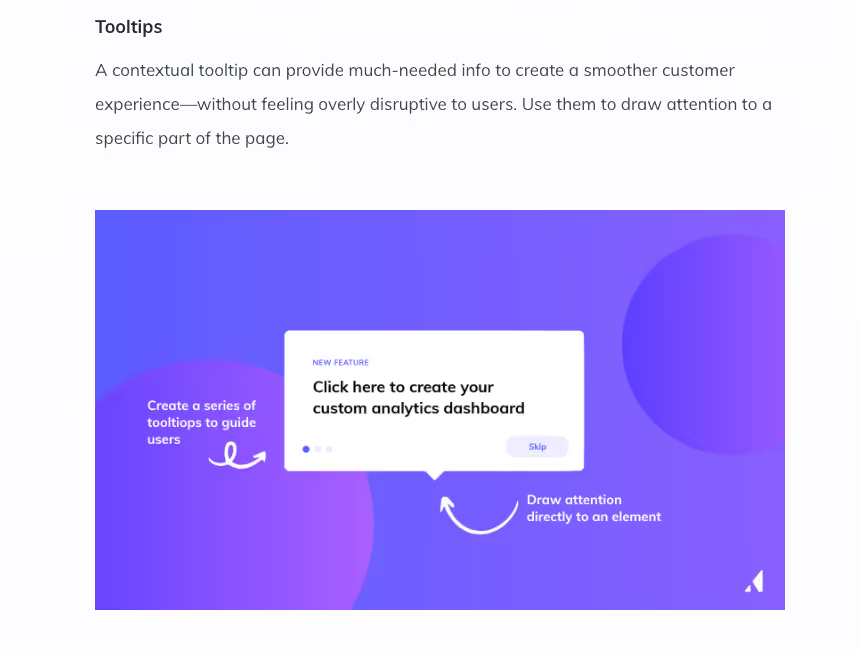
And how users can create them seamlessly using Appcues:
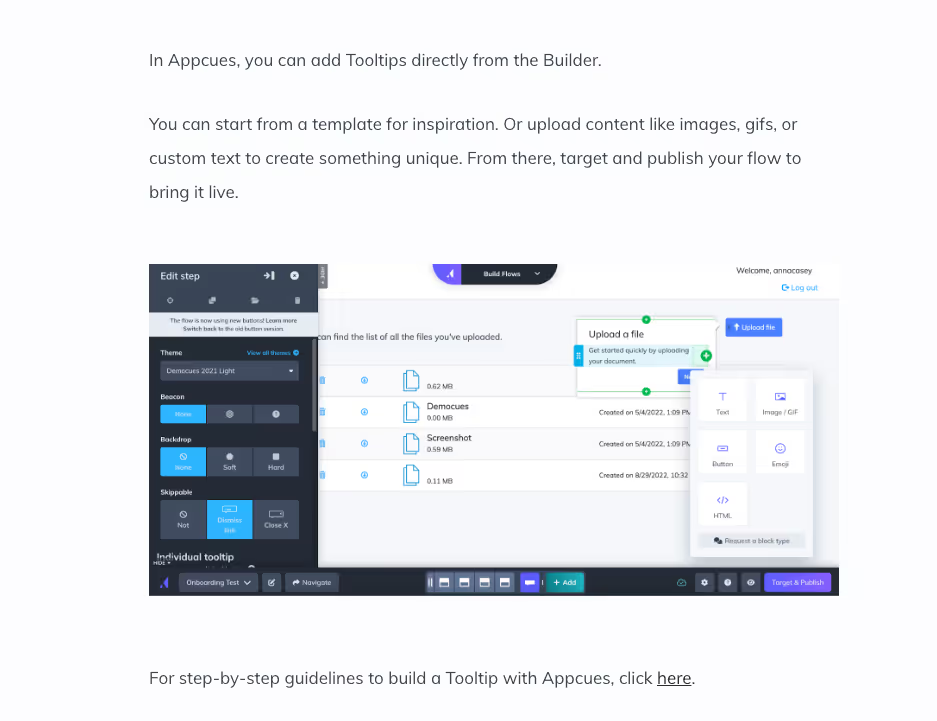
Done well, product-led content builds trust and authority—enough to help B2B companies increase sign-ups, trial-to-paid conversions, demos, and lead generation.
Here’s how:
Put your users and customers first
Great product-led content is inherently buyer-centric.
It’s about solving customer problems in precise terms using real tools, techniques, examples, and workflows.
When you help people achieve their goals with practical value over theory, you build trust.
It’s proof you’re out to serve your audience, not just take their money.
This speeds up buying decisions for new users and enhances the customer experience (CX) for existing ones. Sales, loyalty, and advocacy improve as a result.
Demand Gen Report found that 71% of B2B buyers consumed multiple content assets to inform their decision-making process. But half say that content should be more objective and less “salesy.”
In other words, your customers want more helpful content.
For example, SmileBack’s product-led content empowers users to get maximum value from its customer feedback platform.
As a result, it converts plenty of trial users to paid subscribers.
Imagine a customer data platform creates two blog posts for new customers:
- 👎 One provides a vague argument for why consumer data matters for retail brands (without connecting the dots with actual use cases)
- 🤩 The other includes a step-by-step guide and examples of how their company’s product can help retail brands improve marketing segmentation using a “single source of truth”
Its product-led content shows readers how to achieve their goals by mapping out a process.
Seeing the tool’s capabilities in action builds readers’ confidence in your ability to deliver results.
Those “sign up” CTA buttons become much more appealing as a result.
Focus on pain points and jobs-to-be-done (JTBD) to build brand affinity
The same proportion (71%) of B2B buyers who are influenced by content also share it with their buying committees.
But they won’t just share anything.
They need to appear helpful and knowledgeable to peers and colleagues in order to maintain their professional relationships. Users and buyers alike favor practical content over theory-based posts that repeat tired or unsubstantiated ideas.
Semrush is one of marketing’s best at solving readers’ problems with actionable, product-featuring content. And its strategy generates plenty of organic traffic and backlinks.
For example, this article on “SEO Basics for beginners” offers plenty of actionable advice for startups, small business owners, and marketers:
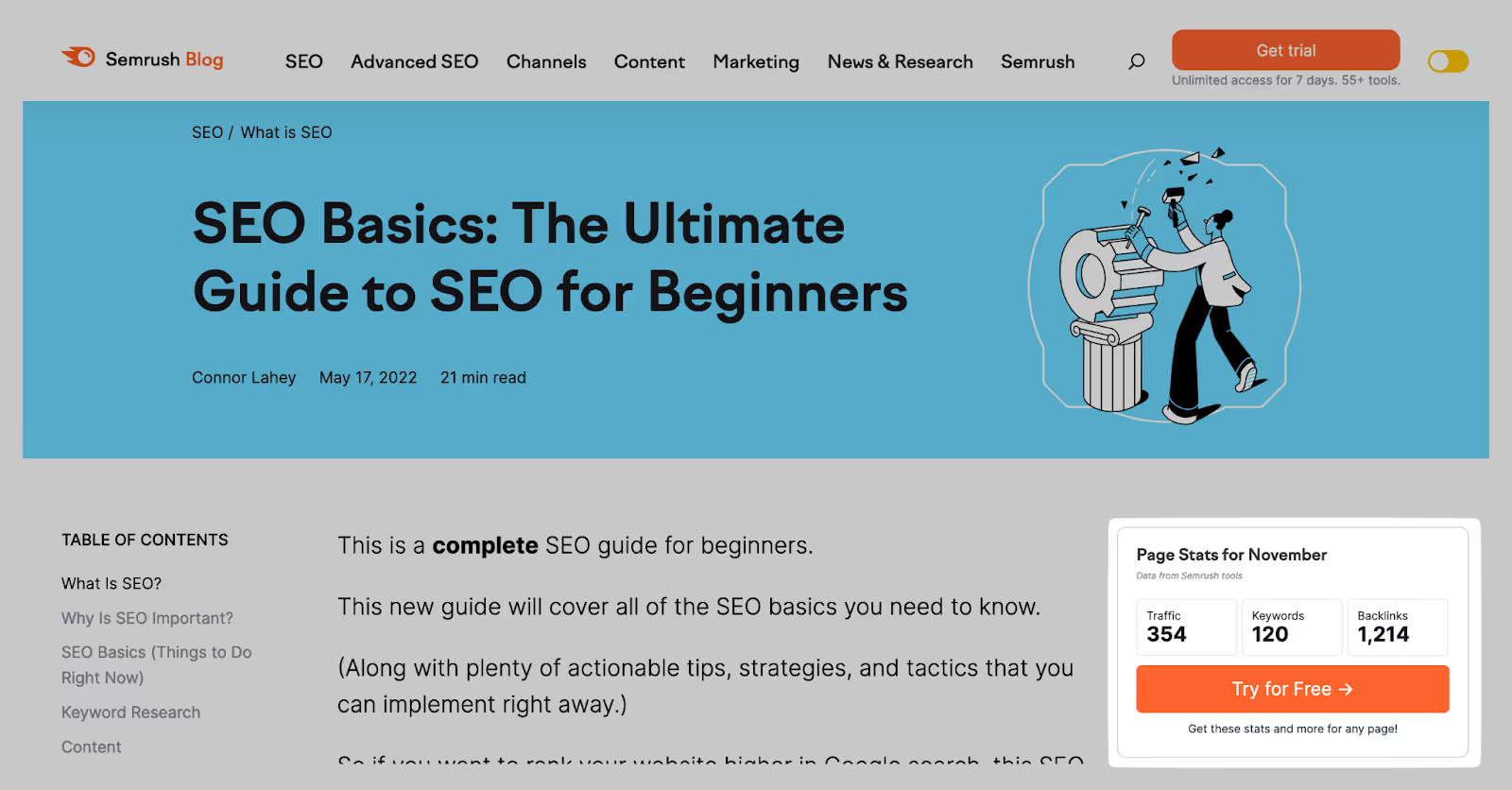
But it also showcases how readers can solve problems and achieve JTBD—something its audience wants to achieve:
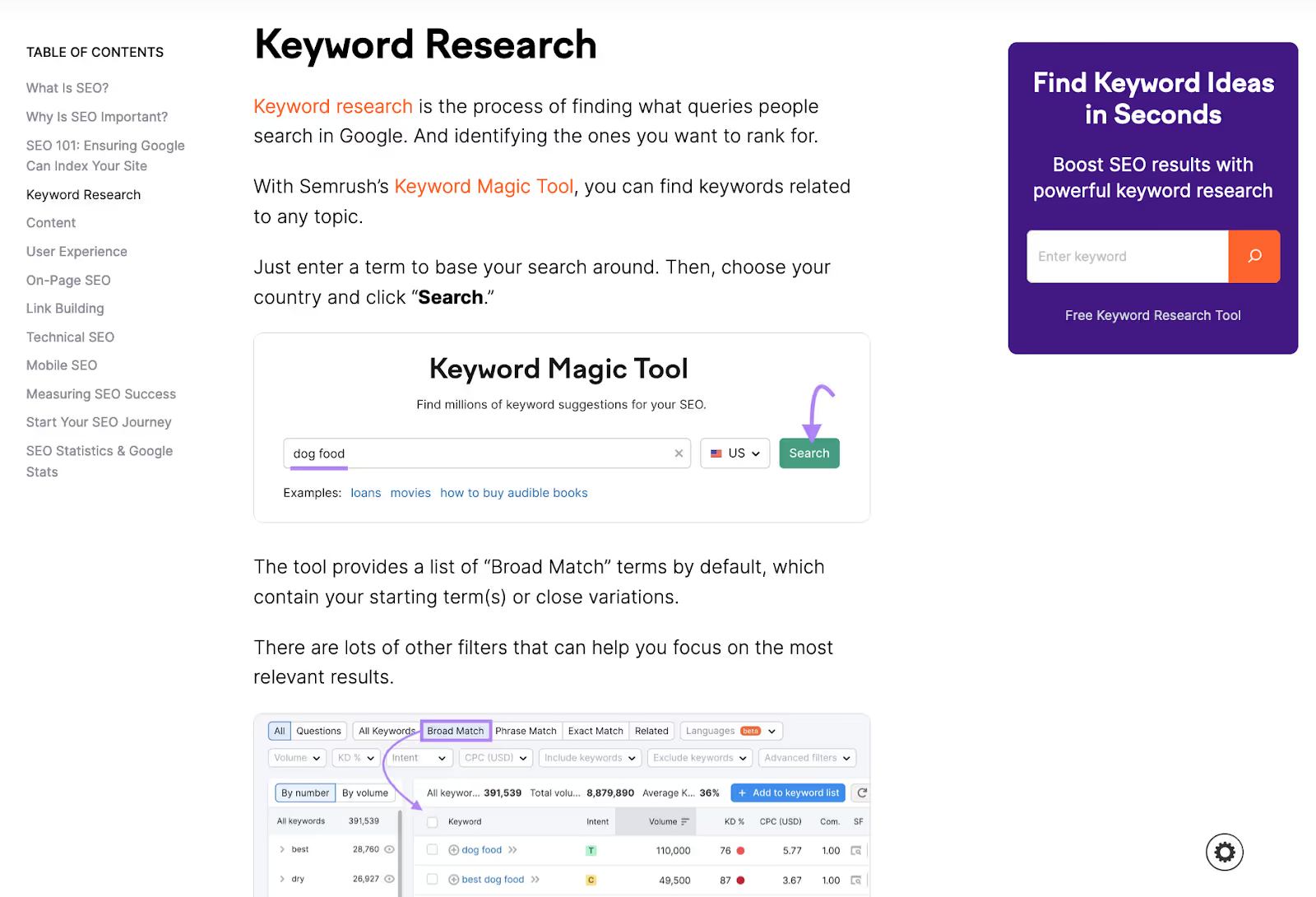
Every new visitor Semrush acquires through its product-led content strategy is another opportunity for someone to discover the brand.
Using your product to illustrate and demonstrate points like this reduces your content’s ‘time-to-value.’
Time-to-value is the rate at which readers get their first revelation, learning, or nugget of value from your content.
And the more immediately useful your content is, the more likely people are to read and share it. Which increases engagement signals and improves SEO performance as a result.
That’s partially why the SCQA content framework (SCQA meaning “situation, complication, question, and answer”) is so effective.
Done right, SCQA positions your brand as an authority or knowledgeable peer.
Imagine a conversation between two colleagues:
🤩 “Hey, you know that problem we have? I found a simple way to solve it—it’s all here in this blog post.”
It’s much more likely than:
🤔 “Hey, you know that problem we have? I’m closer to solving it after reading the theories in this blog post.”
“Sharing” doesn’t just mean one-to-one recommendations.
Other creators are hungry for high-value content to share with their audiences to be genuinely helpful or to reinforce their ideas. This is how you generate backlinks organically.
Deliver more delightful customer experiences
Product-led content fills key knowledge gaps at every stage of the user journey.
This is the process customers and buyers (including trial users) go through as they get value from your product.
And people satisfied by great experiences spend more, for longer.
Qualtrics found that customers who rated a brand experience five stars are more than twice as likely to purchase from the company than those who rated it one or two stars.
Product marketing contributes to higher activation, reduced time-to-value, and an increase in free-to-paid users by:
- Showing leads and freemium users what to expect. This avoids overpromising or causing confusion down the line when users get hands-on with your product. They'll know how to best leverage relevant features from day one.
- Enabling faster, more confident onboarding. First-time users who see product features in action will feel comfortable using them when they sign up. Having context for key features and workflows results in better ROI and faster payback periods.
- Empowering effective ongoing usage. When customers understand product best practices, they'll adopt more of your features over time. This leads to better experiences and outcomes, preventing customers from underutilizing key features—the difference between just scratching your platform’s surface and realizing its full potential.
- Providing helpful support content. Some users will turn to knowledge-base documentation and guides before contacting support. This self-service approach is faster and prevents overburdening your teams with avoidable issues.
Take this article on customer satisfaction surveys from SmileBack:

The article covers how managed service providers (MSPs) can grow revenue by measuring customer sentiment at various project stages.
But it goes well beyond theory, showing how readers can progress with SmileBack’s software:

SmileBack isn’t overtly selling its product here. It’s simply helping prospects and users achieve better ROI, making them more likely to sign up for a trial, become a paid user, or renew their subscription.
How to create product-led content that acquires and retains users
Crafting effective product-led content is a balancing act.
Overly promotional copy pushes readers away. But without specific examples and workflows, your blog posts, webinars, and podcasts get lost in the noise.
Here are six principles for crafting product-led content that generates users and improves customer retention.
1. Tie products and features to specific problems
People don’t care about your product unless it can help them overcome a problem or reach their goals.
That’s as true in content marketing as it is more broadly in business.
Which is why great product-led content addresses specific customer pain points and JTBD.
For example, Semrush knows its local business audience uses the Google My Business platform and wants to be more visible online.
It combined those to create a guide on How to Add Keywords to a Google My Business Profile:

The bulk of this blog post is about Google’s platform. But within the section on finding keywords that drive traffic, it offers step-by-step instructions on how to use its Keyword Magic Tool::
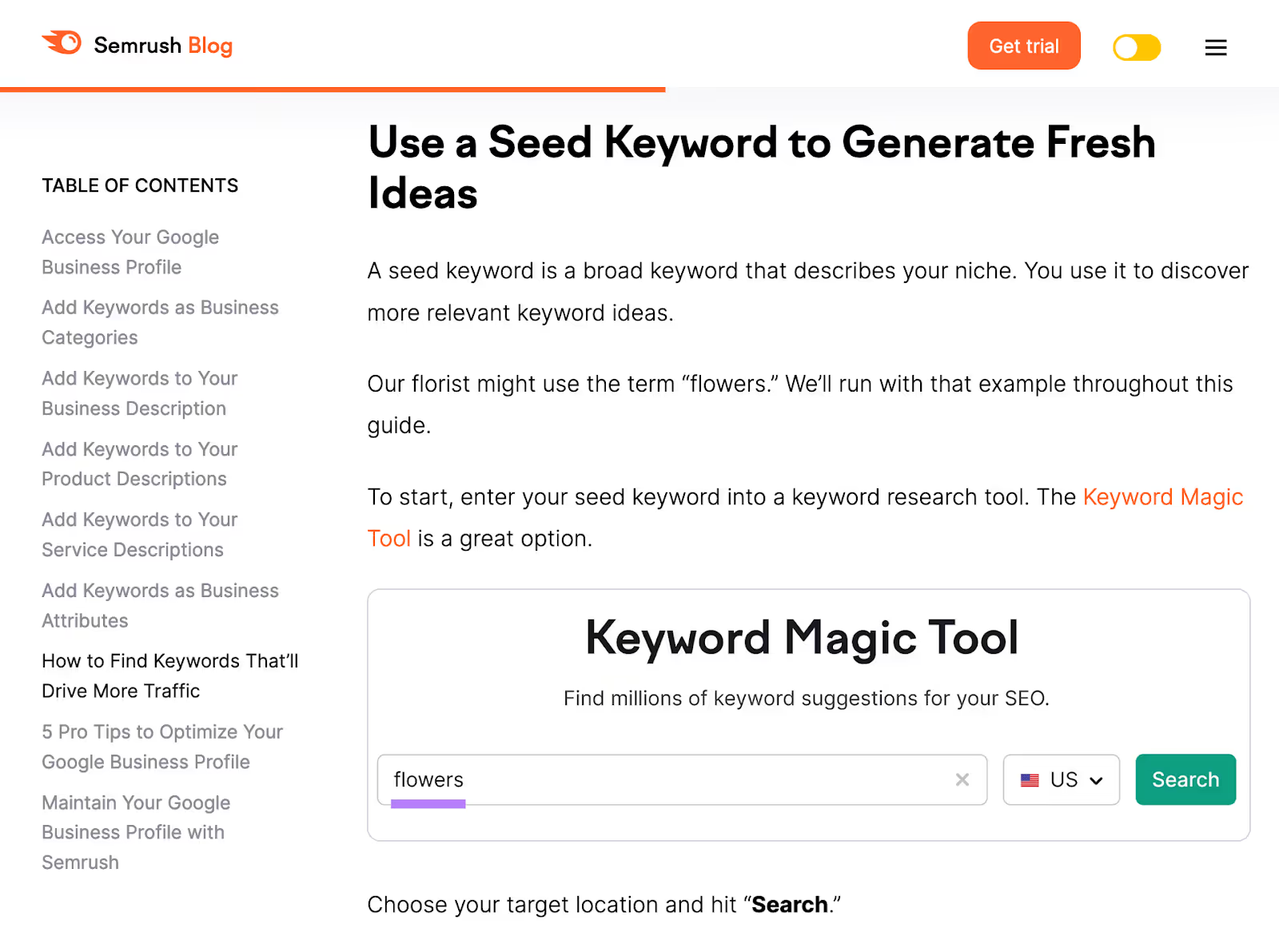
Semrush’s keyword research tool fully warrants its place in the article because it helps readers overcome a particular challenge: identifying keywords that drive local traffic.
Now, you could force products into loosely relevant content. But that’s how many marketers come across too “salesy” and lose readers’ interest.
You must know your target audience in intricate detail to build content ideas around specific needs.
Here are three simple ways to better understand your ICP’s problems:
- Customer interviews. Continually reach out to existing users and prospects to keep your understanding fresh. Ask open-ended questions to uncover challenges, goals, and pain points related to the problem your product solves.
- Support ticket analysis. Monitor trends and common questions in your customer service interactions. These clues indicate knowledge gaps and use cases to cover in your content.
- Product usage metrics. Analyze where customers are getting stuck while onboarding and using your product. Pay attention to in-app guides opened, questions asked, and features ignored. Then create product-led content that addresses those friction points.
Revisit these techniques often to learn how customers’ needs and behaviors change over time.
For example, here’s a support request from Pipedrive where the user asks for help importing data:
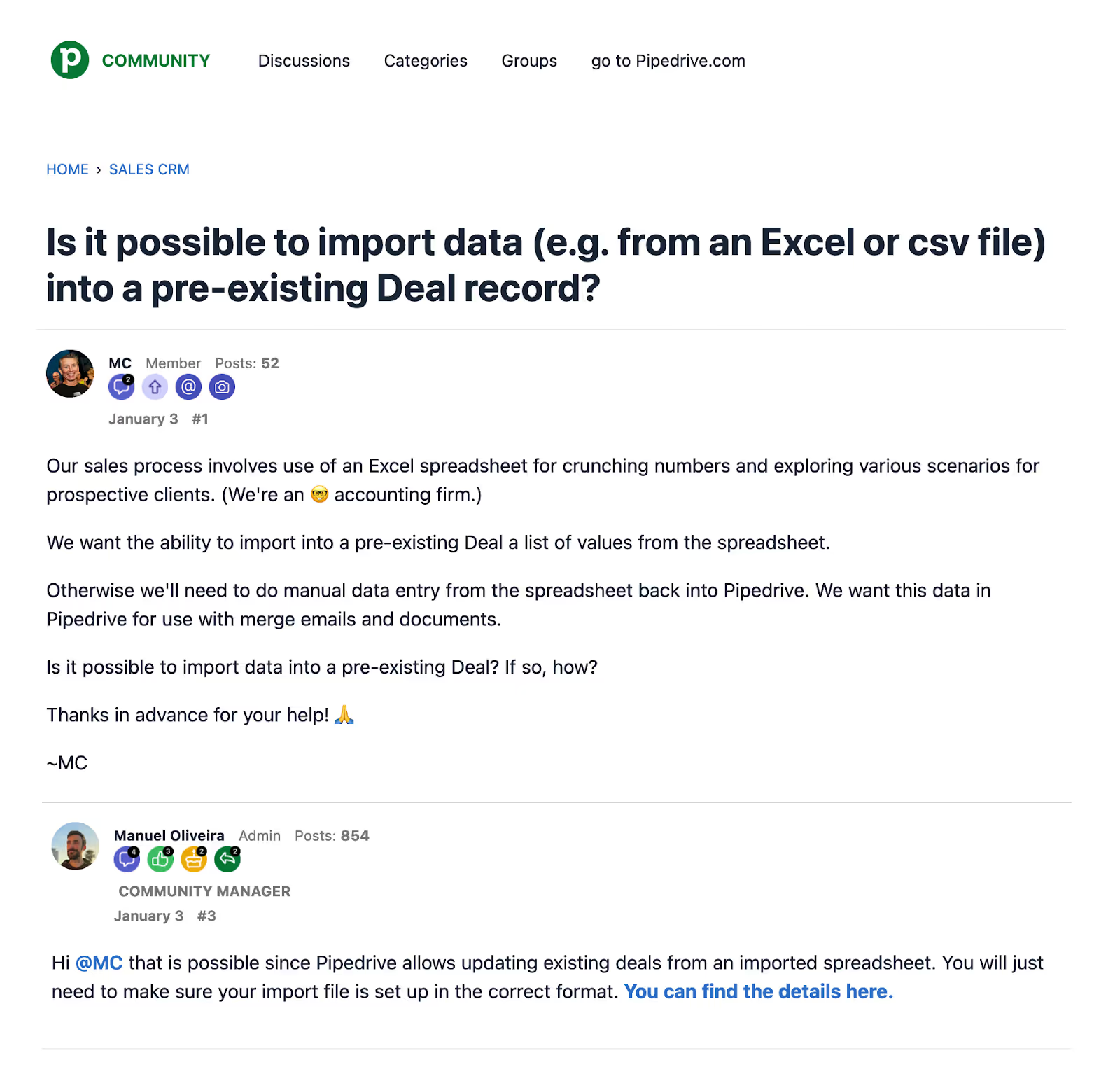
If this query proved common, Pipedrive could bake the answer into a product-led guide on importing data (to complement the knowledge base it links to).
By proactively addressing users’ pain points, Pipedrive helps its audience to help themselves. And ultimately delivers a better user experience.
2. Recruit an internal product champion
Alone, customer insights aren’t enough.
As a marketer, you must become an expert in the product you’re writing about.
This ensures you can:
- Spot the best opportunities to promote relevant features
- Write or talk about your product accurately and authentically
Connect with product managers and owners, developers, implementation specialists, and customer success teams.
These people live and breathe your product’s features and can provide essential context on customer journeys. They may even have case studies and testimonials to offer.
Their insights show how your product works and where users get the most value. And, more importantly, which challenges to address first in your content marketing strategy.
[[component]]
Moreover, it’ll help you become more visible in search engines (according to Google’s guidelines).
Be open about experts’ involvement. It’ll lend credibility to your content.
Just like Ahrefs does in this article on location landing pages:
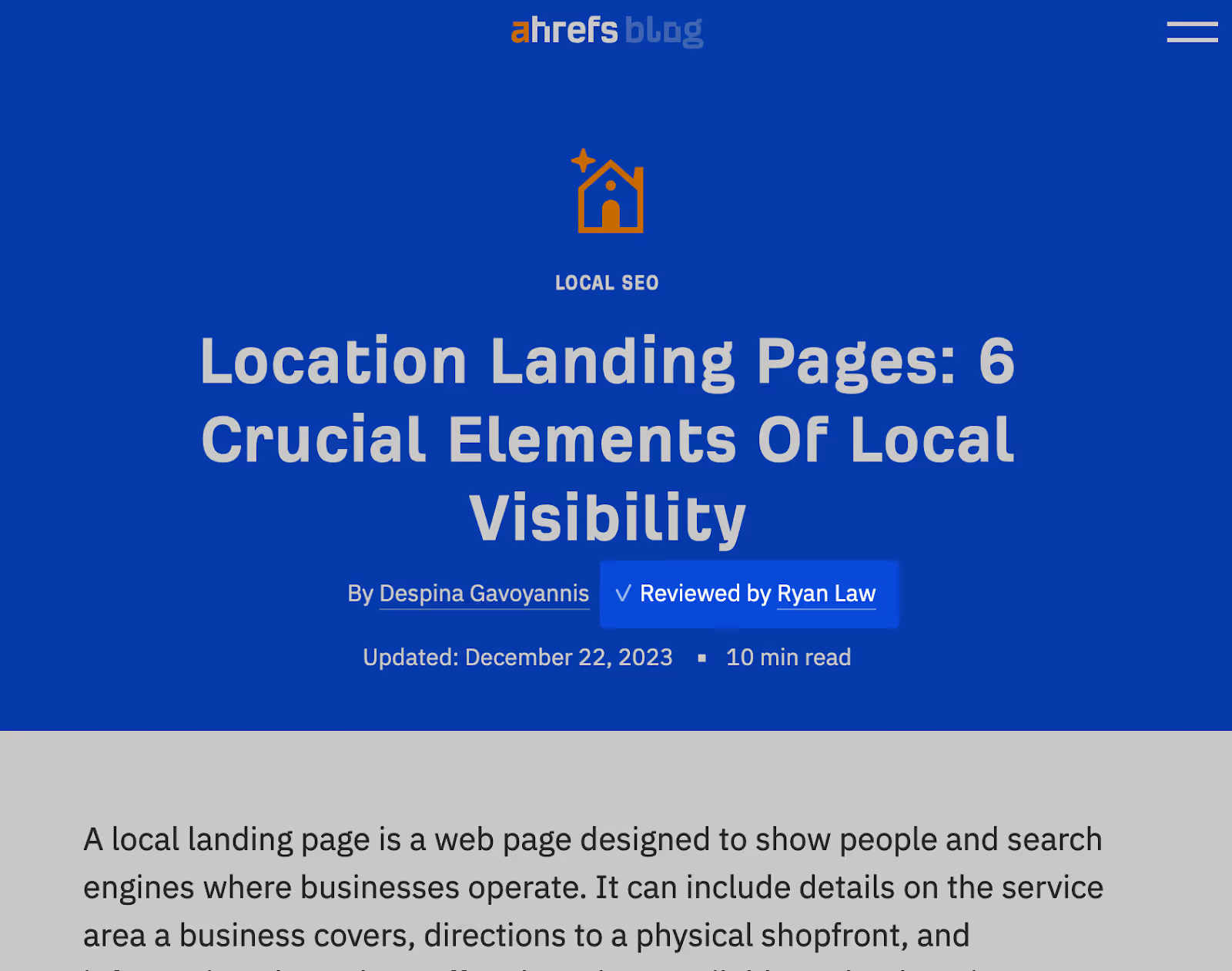
Here, Ryan Law is Ahrefs’ Director of Content Marketing—a bona fide subject matter expert. Advertising his contribution adds authenticity to an already strong blog post.
Connect with your chosen product champion through structured meetings and less formal communication.
Join product meetings to keep up with developments, soak up first-hand product knowledge, and ask questions to hone your understanding.
The best insights won’t always be forthcoming. Tease out expert knowledge with questions like:
- What feedback have you received from customers, and how have we adapted our product based on that feedback?
- Are there common misconceptions about our solution that we should address in our content?
- Which features do you feel are underused or underappreciated, and how can we help users get more value from them?
Then pick a convenient communication channel, be it email, Slack, or similar, to use ad-hoc throughout the content creation process.
Invite product experts to contribute to briefs, outlines, and drafts to ensure product mentions are warranted and accurate in every piece of content.
3. Make your product the centerpiece of your SEO strategy
SEO is one of the most effective ways to get your product in front of your audience and impact revenue.
Many B2B buying journeys begin on search engines. As long as your content ranks for relevant queries on Google, you’ll generate high-converting traffic.
The crux of SEO content is targeting topics people search for, but not all keywords will lend themselves well to celebrating your product.
Question-based queries offer an easy way in as they typically indicate a desire to learn. Think terms with modifiers like “why,” “what,” and “how.” Most tie to a JTBD.
When you find topics and keyword clusters related to customer pain points, offer a DIY approach alongside your solution.
For example, ClickUp’s piece on bespoke calendars gives searchers who want to learn “how to make a calendar in Excel” a clear step-by-step solution:
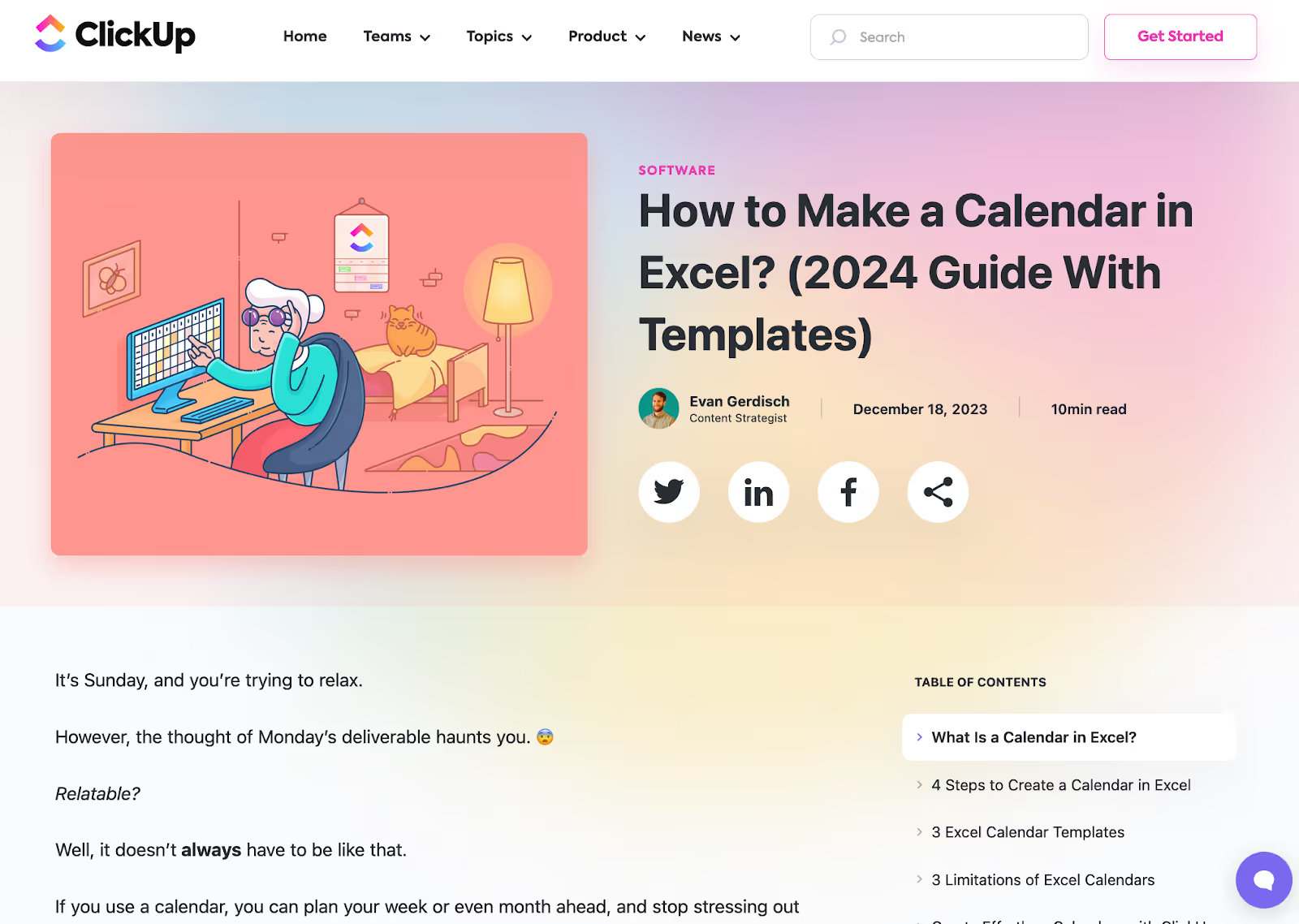
Later, it highlights Excel’s shortcomings before offering its own product as an “effortless” alternative:
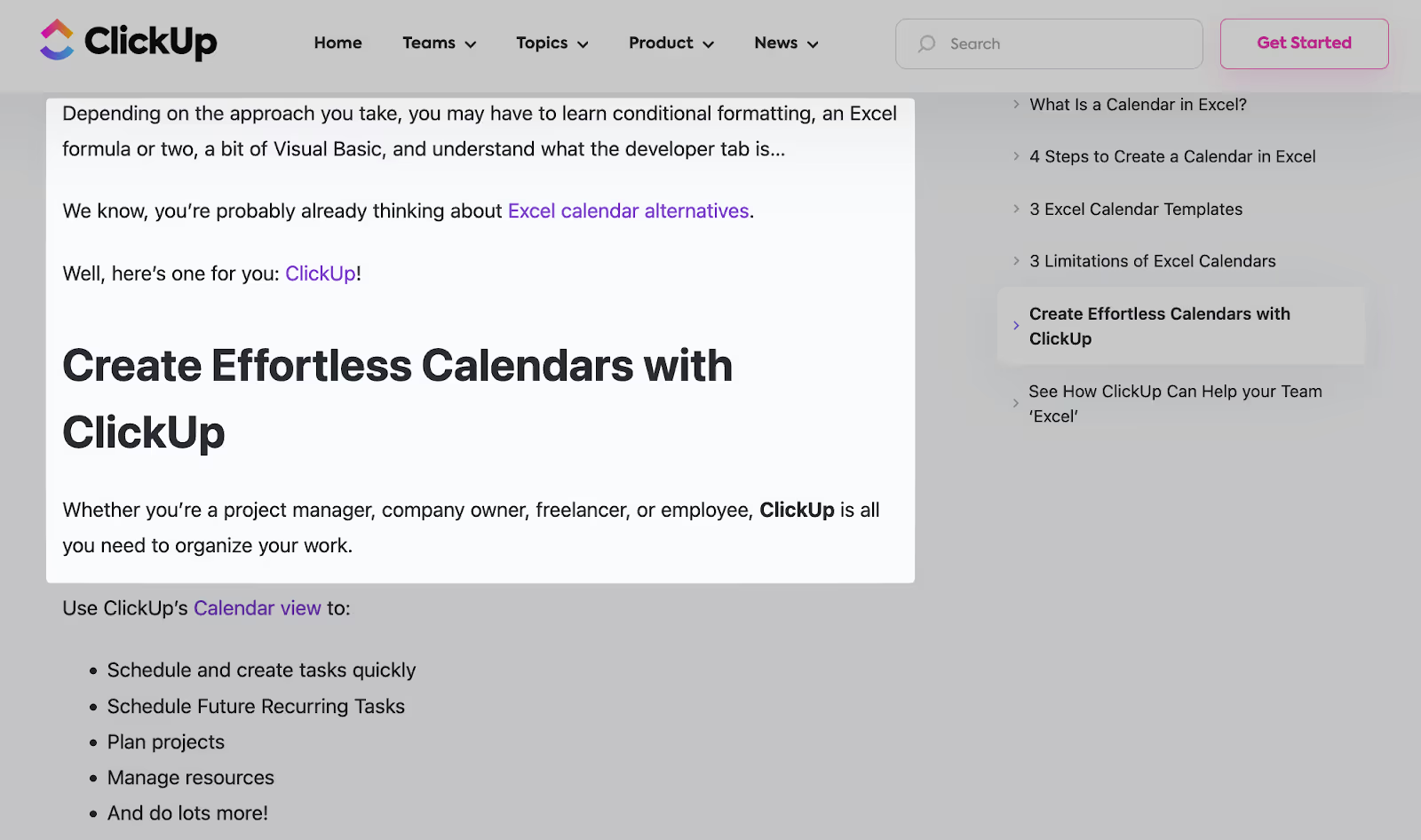
Ultimately, searchers get a clear answer to their original query and Clickup promotes its product in a natural way.
It benefits the brand, reader, and search algorithms.
Pitching a DIY method as the “hard” option to your solution’s “easy” will make your content more accessible and valuable to a broader audience. And therefore more appealing to Google.
4. Put value before your product
The “led” aspect of product-led content is—ironically—misleading.
Meeting your audience’s needs and delivering disproportionate amounts of value must always come first.
For example, the value of ClickUp’s “how-to” guide for building calendars is in solving a common problem: organizing projects, events, and tasks in a cost-efficient way.
ClickUp’s product plugs a gap in that journey but it isn’t the primary focus.
A product may be more prominent if it’s critical to solving a highly specific problem. Like in this SmileBack blog post, which focuses on the software’s Microsoft Teams integration:
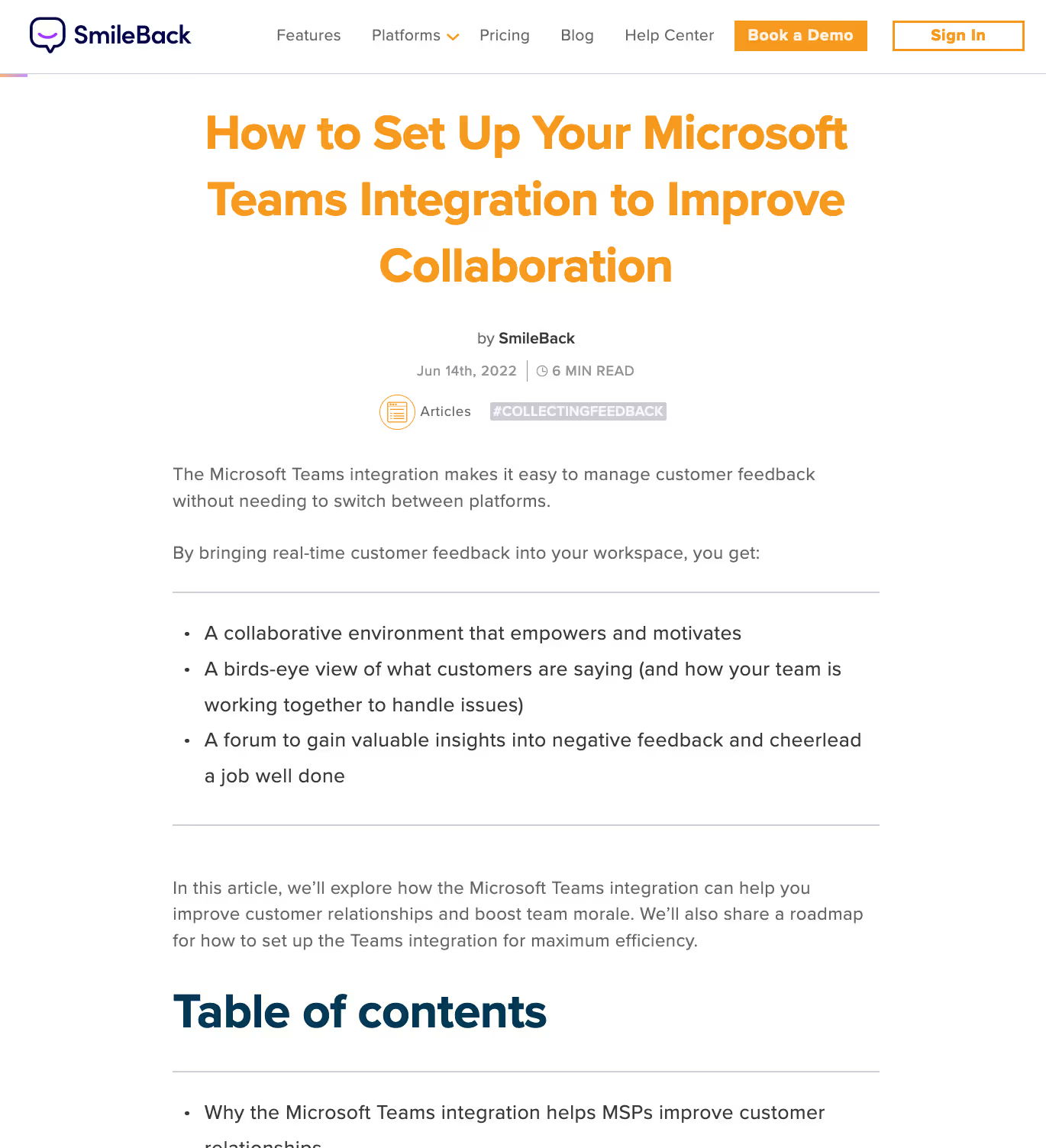
It’s much more specific than “how to collect customer feedback,” and its audience is narrower, but the content is still value-first. It exists to help SmileBack subscribers who use Microsoft Teams improve collaboration by joining the tools together.
When planning content ideas or looking for ways to weave products into existing content, consider where each piece would fall on the following scale:
Most of the best examples of product-led content fall into these categories. As for where, it depends on the context.
For instance, ClickUp’s templates aren’t essential for building a business calendar but are highly relevant and helpful.
This would fit within the second category as it’s top-of-funnel content that solves a common problem.
However, SmileBack’s Microsoft Teams integration is the only way to connect SmileBack with Microsoft Teams. It’s critical to solving that highly specific problem for existing or prospective users, so it’s bottom of funnel (BOFU) content in category three.
5. Convert in-market audiences with bottom of funnel (BOFU) content
Product-led content isn’t just for problem-solving and JTBD.
It can also convert high-intent search traffic.
These are in-market buyers researching products and categories capable of solving their day-to-day challenges.
It means the best BOFU product-led content, in all its forms, is search-friendly.
There are many BOFU content formats capable of building awareness and generating sign-ups. Including:
- Product and feature landing pages detailing key benefits and value propositions
- Comparison pages, ideal for buyers pondering two (or more) specific solutions
- Listicles that let searchers compare top-performing products, features and other solutions efficiently
For example, Pipedrive has a landing page comparing its features with a direct competitor, HubSpot.
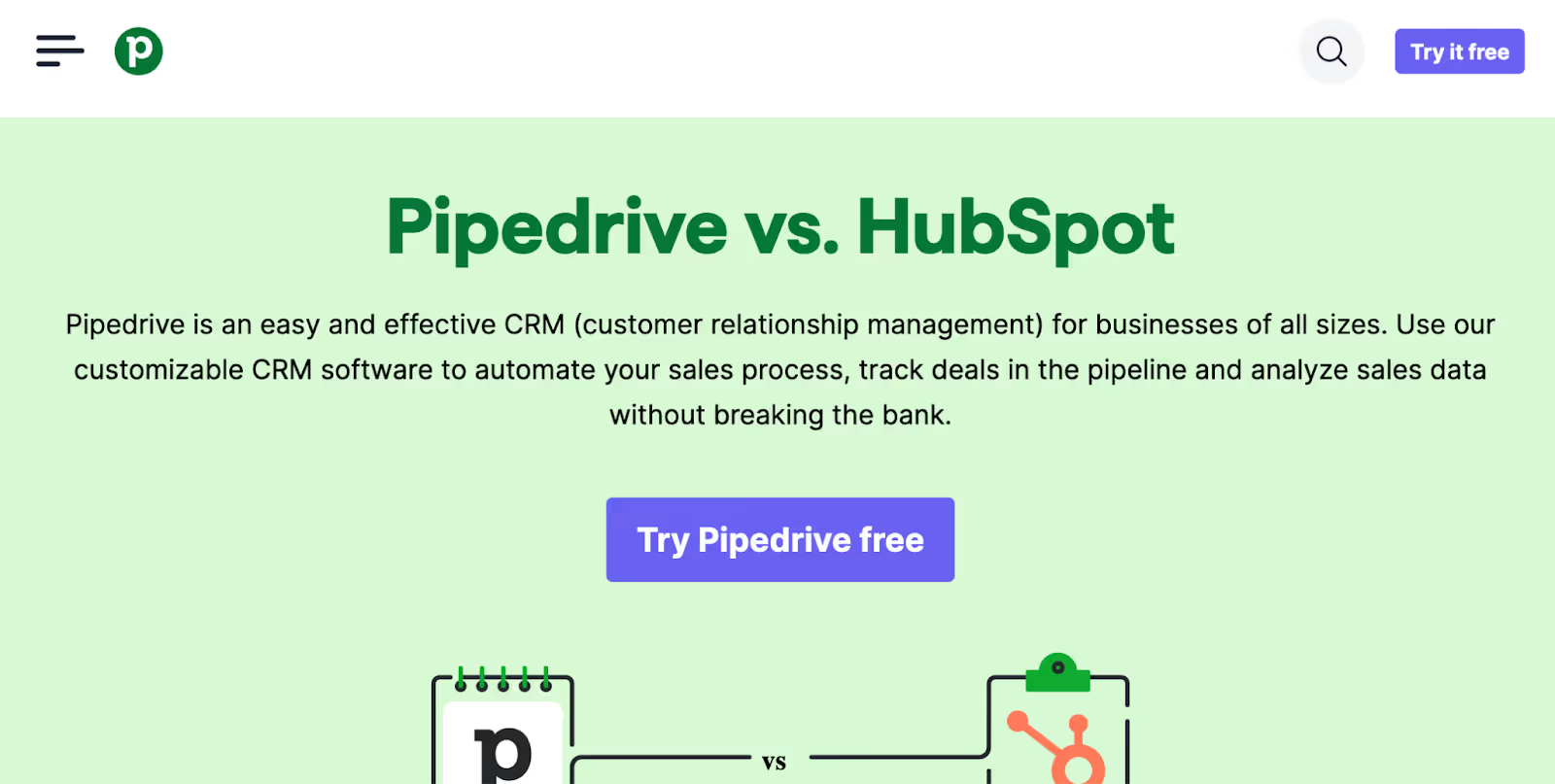
This landing page, which prominently features an “at a glance” comparison table, ranks top in the SERPs for “Pipedrive vs. HubSpot”.
It’s a term that in-market buyers who still have both tools in mind will undoubtedly search to help with their research process.
HubSpot knows this helps conversions. Hence its entry at #2:

Google’s “People also ask” section gives more clues into your audience’s mindset:
- “Is HubSpot or Pipedrive better?” = They’ve narrowed their search to two tools but can’t decide which to go for.
- “What CRM is better than HubSpot” = They’re sold on CRM software but not on HubSpot.
- “Who is Pipedrive best for?” = They’re almost sold on Pipedrive but need reassurance that it’s for them.
- “Why Salesforce over Pipedrive?” = Again, they’ve narrowed their search to two tools.
One thing’s clear across all these queries: these users are close to conversion.
So, when you cater to them with product-led content targeting keywords that indicate commercial (buying) intent, you’re highly likely to boost acquisition.
Just as Pipedrive did with our support. As well as boosting organic traffic in English markets by 50%, the company hit a post-pandemic sign-up record in the final quarter of 2022.
How do you create BOFU product-led content?
It’s a balancing act. Sure, you need to promote your solution. But users who make it this far will always see through outlandish claims and biased pitches.
The trick to grabbing and keeping savvy readers’ attention is to be honest, accurate, and precise.
From our experience helping SaaS brands grow conversions, the best results happen when you:
- Are impartial. Don’t be afraid to lay out the facts, even if they’re not in your favor—76% of buyers trust brands that make honest claims about their products.
- Get the details right. Involve product champions in content creation and take time researching competitors’ solutions. It ensures all product mentions and comparisons are accurate to avoid cease-and-desist notices (they do happen).
- Serve your readers. Call out who each tool and feature is right for. Recommend competitors that better fit your readers’ needs. Selling to bad-fit customers can hit your churn rate and reputation.
Remember, BOFU content won’t always be the best fit for every topic or stage in the buyer journey.
When keyword and competitor research highlights a different search intent (e.g., more demand for “how-to” info), tailor your content accordingly.
6. Find a great screenshotting tool (you’ll need it)
Screenshots are pivotal in showcasing B2B SaaS companies’ product features and functionalities.
They give potential customers tangible previews and show existing users exactly where to look in a tool’s interface as they follow along.
For example, in Trello’s blog post on strategic planning, the writer illustrates their points on visualizing data with a real shot of the Trello Dashboard view:
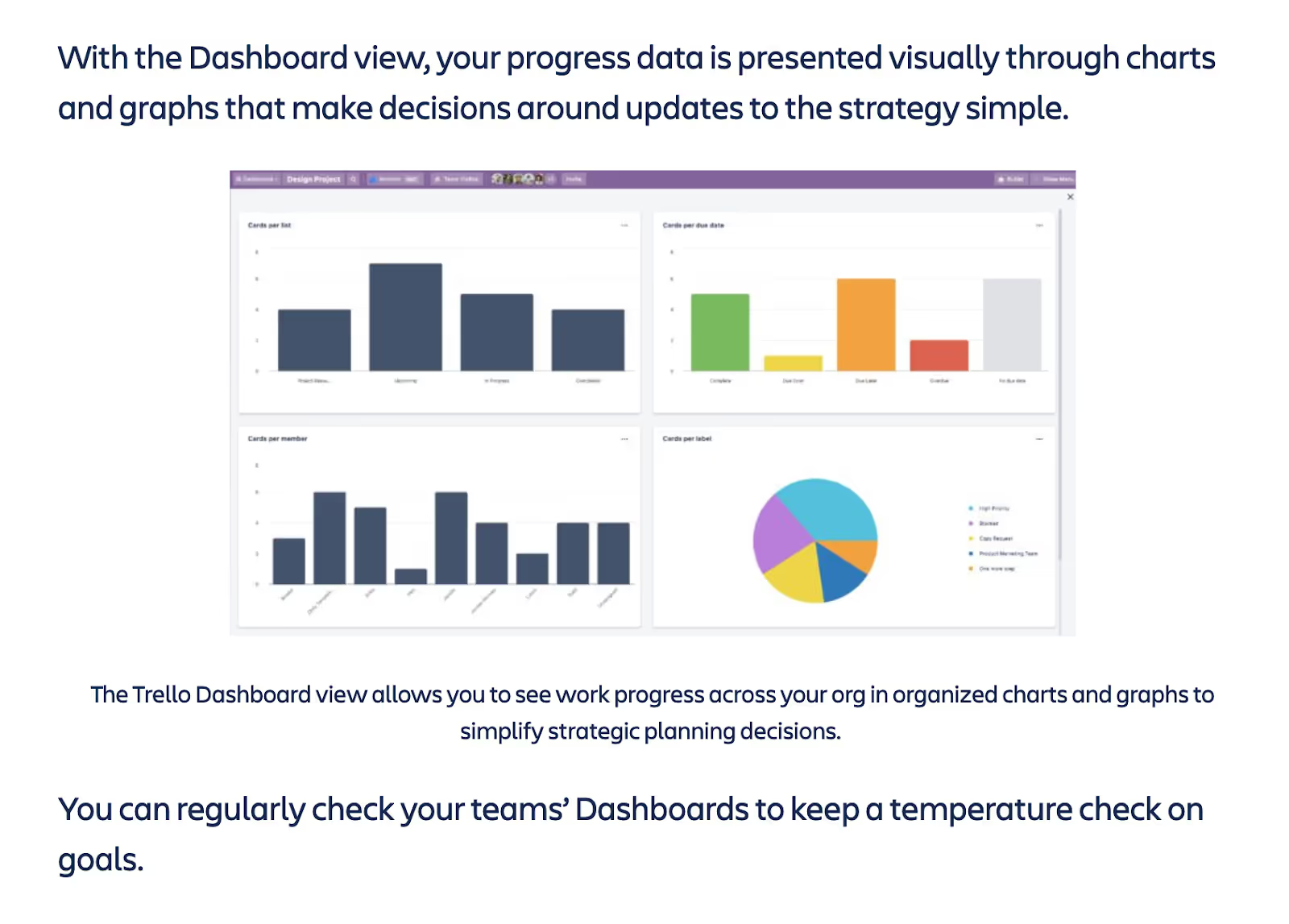
Prospects in the consideration stage now know what to expect from Trello’s product.
It shows users what they can get by signing up for a free trial or paid subscription. So they’re more likely to convert.
Video clips and GIFs from your product allow even deeper engagement.
Content Marketing Institute found video content (including longer formats) to be the seventh-most valuable content asset among B2B marketing teams.
Short clips will catch skimmers’ attention and help readers understand how your solution works.
Not sure where to start? Here are a couple of our favorite screenshotting apps (outside of the native MacOS and Windows tools, which have limited functionality) to try:
- Shottr (Mac). A super-fast app that can record still and scrolling screenshots. All of Shottr’s advertised features, including annotations, cloud uploads, and text recognition, are free to use. Upgrade for early access to new features. Download it here.
- Snagit (Windows and Mac). A more comprehensive app for recording still, scrolling, and video screenshots, as well as audio. A versatile share function makes inserting screenshots into documents, chats, social posts, and cloud storage easy. Snagit is free to try and $62.99 (or £60.92) for a lifelong license. Download it here.
As for creating GIFs from videos, Adobe Express is a reliable free converter you can use in your web browser (after signing up). You can clip sections of your videos and choose sizes and ratios based on where you’ll upload your file.
A product-led approach to customer acquisition and retention
There are good and bad ways to do product-led content marketing.
The bad involves hard-selling solutions under the guise of “helping” potential and existing customers. And it’s counterproductive. It’ll turn customers away before they’ve had a chance to learn about or love your brand.
The good is all about tactfully highlighting your product as the best solution to your ICP’s biggest problems.
Done right, it’ll build trust and authority for your brand and ultimately improve acquisition, retention, and revenue.


According to current understanding of Google, engagement factors like time on site are a key ranking factor. If someone clicks our result and ends their search there, it sends a strong signal that we’ve created content that satisfies their query.
To grab their attention during their search, your page title and meta description must communicate the value they’ll get from your content. But most importantly, it’s got to stand out from the ocean of same-old content on the SERPs.
Attack of the content clones: State of the SERPs in 2021
Search for any given keyword – especially competitive ones – and you’ll likely see a number of similar headlines:
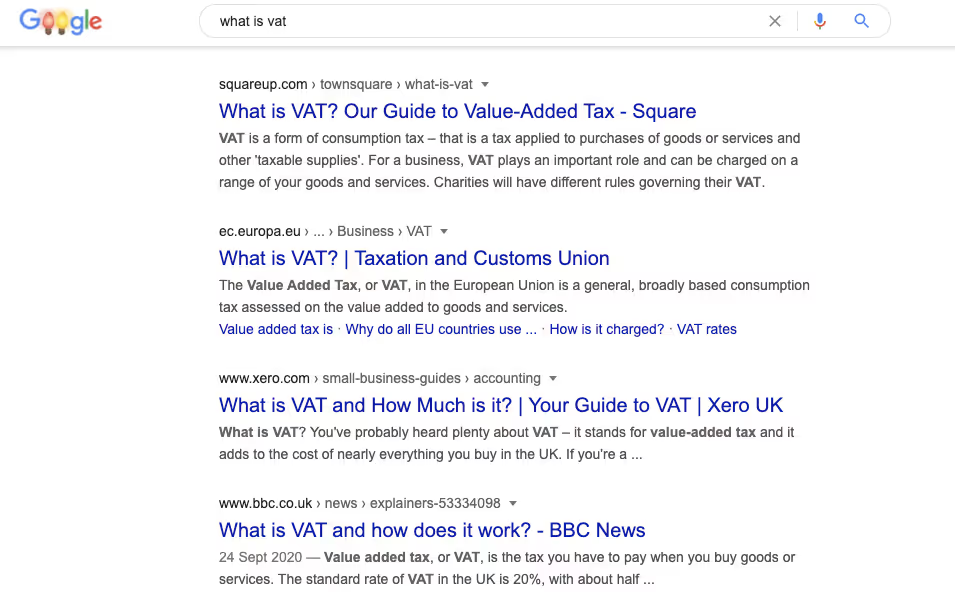
For example, results for the term “what is vat” all provide similar answers to the same question, which can be bucketed into three categories:
- What is VAT?: Repeating the query back to the searcher in an attempt to prove relevancy
- How much is it/how does it work?: A common question people have when looking for information about VAT
- Complete guides: Content positioned as definitive resources
For marketers looking to stand out, taking a skyscraper or 10x content approach is pointless. Building a comprehensive guide that covers the basics is table stakes.
We need to find a truly unique angle that nobody else is covering and delivers on that unique promise.
In a recent conversation with Rand Fishkin, we talked about an article he wrote about outreach tips. He was disappointed with the results he found when searching for articles on the topic, and so he positioned his content accordingly:
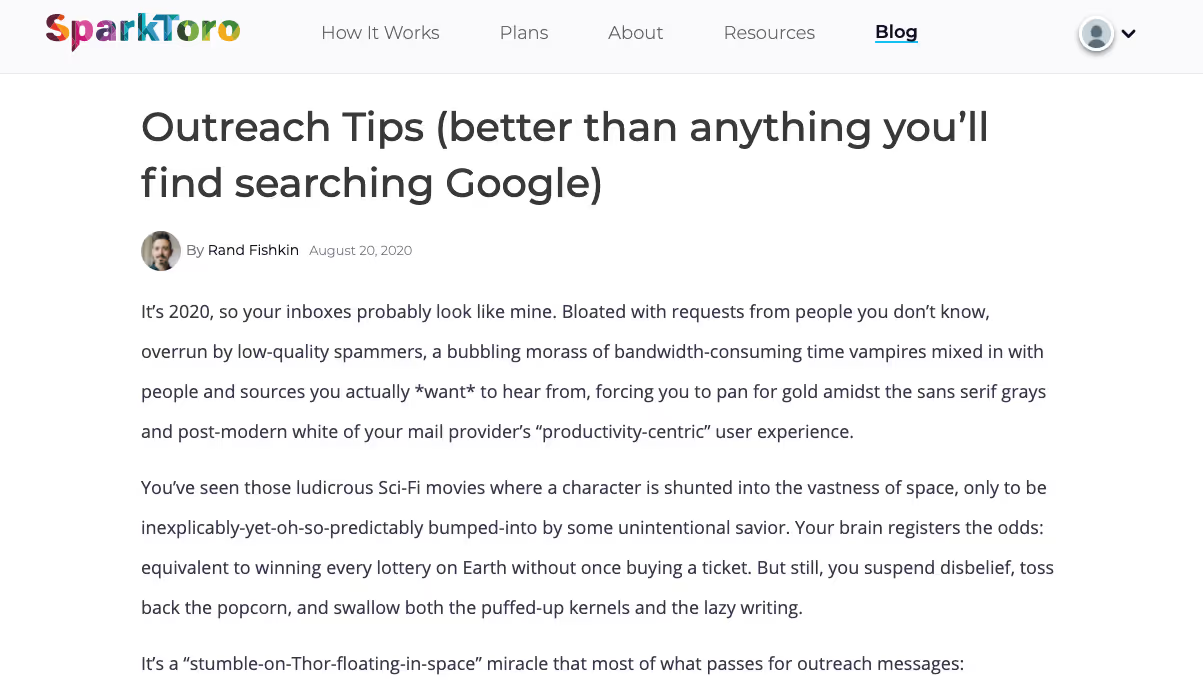
He took a slightly controversial approach, but it paid off. During our chat, we discovered that this article ranks at the top of page one for “outreach tips:”
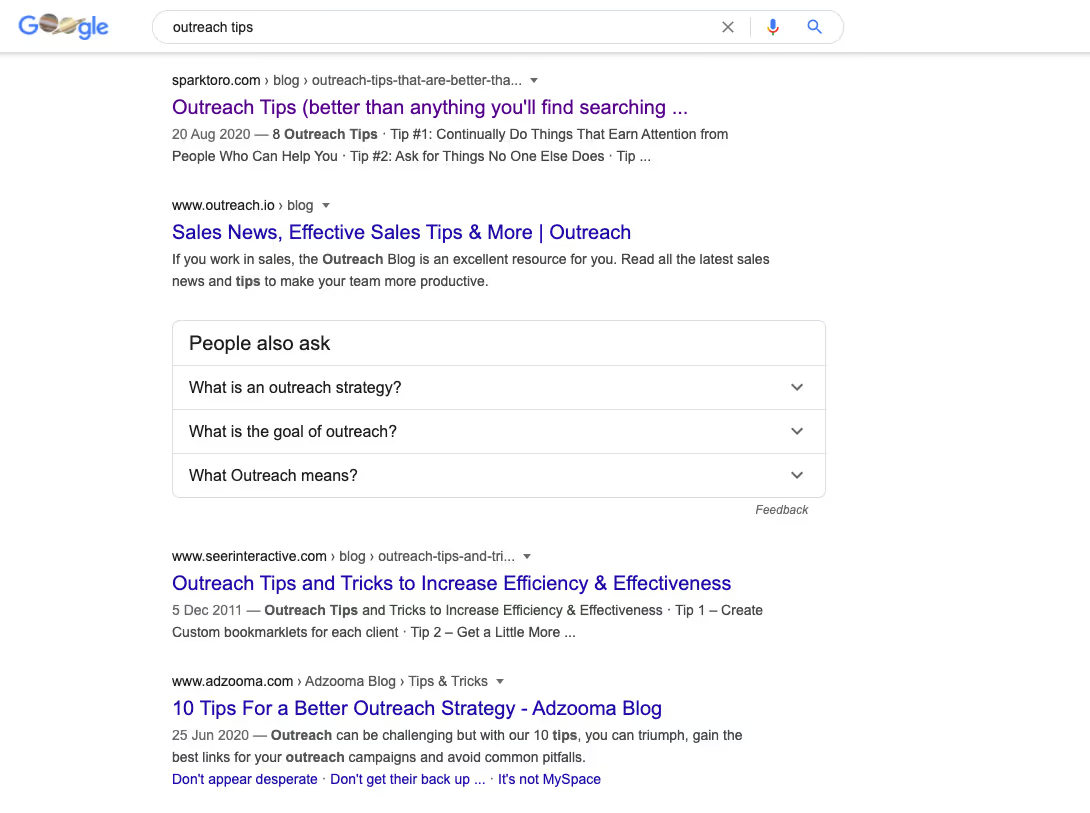
Look at the results above. Which of these headlines stands out the most?
This might seem like a risky move, but there’s a method in the madness. We marketers have come to expect lackluster results when searching for broad keywords. As someone who personally sits within this target audience, I feel this frustration. Rand’s article stands out because it’s breaking the mold. The promise offered by the page title is more compelling than its counterparts.
So, how would we take a similar approach for a topic as dry as “VAT”? The rest of this guide will cover our framework for writing attention-grabbing page titles and meta descriptions. If you’re looking to increase organic CTR from the SERPs, read on.
Researching angles for killer page titles
Your page title is the first thing your audience will notice. So you’ve got to make it exceptional.
Reverse-engineering the SERPs is a good place to start, depending on how competitive your primary target keyword is.
For example, we’ve already identified several angles for our “what is vat” article:
- Defining what VAT is
- The fact it’s a guide
- How much VAT is
- The full definition “value-added tax”
“SERP-stacking” these themes to communicate a well-rounded, comprehensive article is one approach we can take. But for this topic, we’ll quickly blend-in – which is the opposite result of our goal.
So, let’s take the microphone to our audience. The best way to do this is literally getting them in front of a microphone, conducting customer interviews around their challenges and needs.
Another scaleable approach is searching for relevant keywords on Quora. This will provide us with audience sentiment, and uncover potential angles that competing content has failed to include. Here’s what we find for “what is vat”:
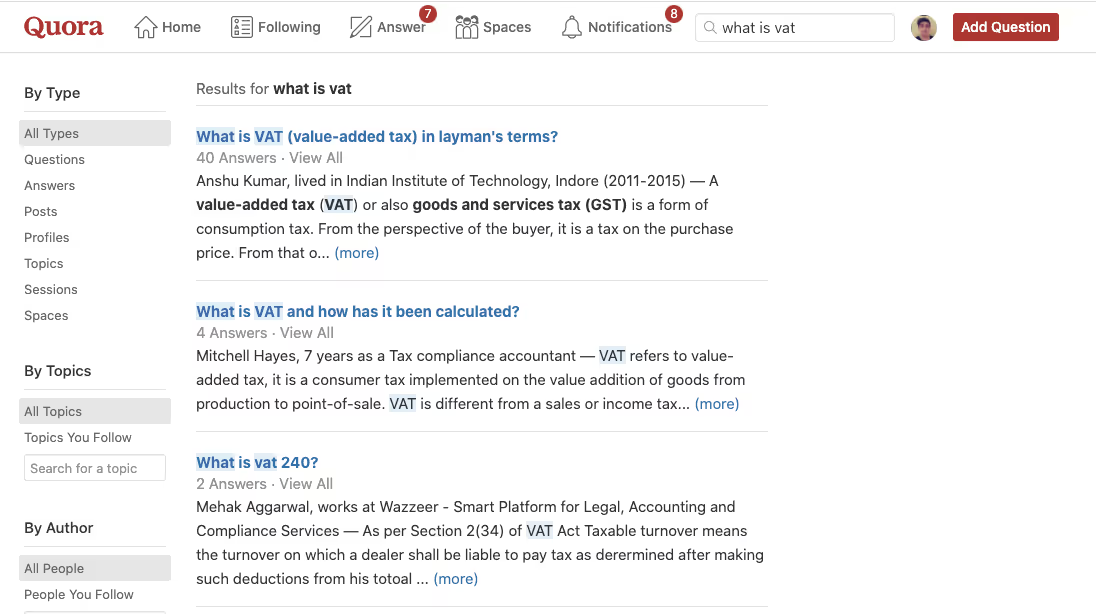
Immediately, I see a huge opportunity in the first result. Here, someone is asking for an explanation in “layman’s terms”. Nobody is making this promise in the SERPs.
Twitter is another great source of insight. But since nobody is tweeting about VAT in this context (and honestly, why would they?), I’ll use “sales pipeline” as an example instead:
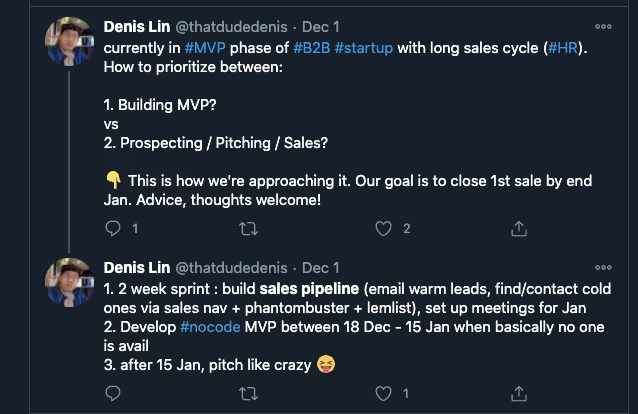
I see two potential angles from this single tweet:
- Why You Should Build Sales Pipelines Before MVP
- How to Build Sales Pipeline & Close Your First Sale
If you’re writing for a startup audience, you’ve just coupled a topic (building sales pipeline) to the priorities and pain-points (before building your MVP and getting the first sale) of your audience. This insight will become tremendously useful in a moment.
Value-driven meta descriptions
I don’t know about you, but I rarely read meta descriptions.
I’m more of an “open-in-new-tab-and-judge-the-introduction” kinda guy.
Still, meta descriptions are important for communicating the value of your content to searchers.
This is your opportunity to show them your content will answer their most pressing questions. It’s also a chance to get them clicking on your content with anticipation.
We use a framework that takes one or all of these approaches:
- See what common themes arise on the SERPs
- Summarise what our content covers
- Look for questions people are asking elsewhere
Let’s take another look at the SERPs to build a more complete picture of searcher needs. For our “what is vat” article, these are the themes that keep coming up:
- “Current VAT rates – standard 20% and rates for reduced rate and zero-rated items…”
- “…is a tax applied to purchases of goods or services and other ‘taxable supplies…”
- “…broadly based consumption tax assessed on the value added to goods and services.”
- “For a business, VAT plays an important role and can be charged on a range of your goods and services.”
- “…it stands for value-added tax and it adds to the cost of nearly everything you buy in the UK.”
- “Value added tax, or VAT, is the tax you have to pay when you buy goods or services.“
Unlike page titles, there’s a tremendous amount of validation in these page descriptions. While a strong page title will stand out, our meta description should reaffirm they’ll find what they’re looking for.
In a way, Google has already done this for us. The elements are all here on page one. We just need to apply it to our own content.
The more a particular phrase or theme arises, the more we should be inclined to use it. Based on our findings, a possible meta description for our “what is vat” guide could be:
“VAT (currently at a rate of 20%), is value-added tax on purchases of products and services. Learn how to calculate it and what it means for your business in this complete guide.”
But as we’ve already discovered, there’s more to the story than the SERPs offer us…
Bringing it together & creating cohesive metadata
We have everything we need to craft attention-grabbing page titles and meta descriptions that communicates our content’s value.
Let’s start with our page title – which, from our research, is a no-brainer:
“What is VAT? A Layman’s Guide to Value-Added Tax”
Here, we’re demonstrating that we truly get our audience. We’re essentially saying:” “VAT can be complex, so we’re giving you content that’s easy to understand”.
We’re also communicating the fact it’s a guide, building context around the positioning of our content and setting expectations.
[[component]]
Next, let’s revisit our meta description. While it’s nice and comprehensive, this first draft comes in at 177 characters. As the recommended limit is 155 to 158 characters, we need to cut some of the fat.
After revisiting the SERPs (and putting ourselves back into our audience’s shoes), we’ve come up with the following:
“In this complete guide to VAT, you’ll learn how to calculate value-added tax and what it means for your business (current rate: 20%).”
This description communicates the following:
- Re-affirm the context (this result is a complete guide)
- You’ll learn how to calculate it
- Why it matters for your business
- The current rate
Including the current rate of VAT brings the answer to the SERPs itself. We’re providing utility in the SERPs for anyone who needs this information immediately.
Standing out, intelligently
You spend so much time producing and distributing your content. But metadata is part of the puzzle that often gets neglected.
Page titles and meta descriptions should make up a critical part of your content creation and promotion process. Without it, nobody will click-through, which means Google will likely decide your content is not relevant enough.
I know writers who craft ten or more headlines for their content. Take the same approach with your page titles and meta descriptions, and you’ll see your CTR soar.


If you want to start meaningful conversations, build trust, earn a spot in the consideration set, and convert leads, you must invest in high-quality content.
Why low-value content creates terrible experiences
Low-effort content translates as low-quality content. It’s generic, teaches nothing new, and barely skims the surface when it comes to actionable advice that helps readers solve problems.
This incentivizes buyers to seek complete answers elsewhere and actively ignore your content in the future.
As such, content that doesn’t solve problems and looks like everything else is a race to the bottom.
It’s true that if you get on-page SEO right and answer search queries just enough to masquerade as depth, it might rank. But articles optimized for search alone destroy credibility because the moment buyers dig in, they’ll notice they’re thin as a rake.
Thin advice creates terrible experiences because:
- It leaves out the “why”: Sharing “why” gives readers key contextual information that helps them understand the value they’ll get from your content. It’s intriguing, relatable, and pokes at shared pain points which fuel the audience’s desire to find out if it provides solutions.
- It doesn’t explain “how”: If readers don’t know how to fix the problems you poked at, or achieve jobs to be done (JTBD), they’re left with more questions than answers. If the “why” verifies there’s work to be done, the “how” practically bridges the knowledge gap. Including one without the other is the fastest way to harm brand equity and lose trust.
- It skips examples: Examples bring the “how” and “why” to life. They allow readers to picture themselves taking action based on the insights they’ve learned from specific use cases. If a marketing initiative generated impressive revenue figures by following a specific playbook, for example, the reader can apply those insights to their unique situation and pick and choose which gems to implement. Bad content leaves readers without clear paths forward.
- It doesn’t inject unique insights: Unique insights help you build credibility and stand out from the crowd. It’s where you share your point of view and lived experiences, add something new to the conversation, take a contrarian stance, or showcase results. Without it, you’re missing the most significant factor of all: differentiation.
To differentiate and create memorable content that keeps your business top of mind (and adds you to the consideration set), you must go beyond the basics.
A reliable way to differentiate yourself is by injecting creativity into your content. Learn how to build trust and a competitive moat in our article on using creativity in content marketing.
A “velocity-first” strategy that prioritizes publishing speed and traffic over quality content can do more harm than good.
If you generate tons of traffic through organic search and deliver a terrible experience, users will bounce, look elsewhere, and remember your brand for all the wrong reasons.
It also does you no favors in building brand awareness and establishing credibility with decision-makers.
Grizzle’s founder & CEO, Tom Whatley doesn’t mince words on the subject:
The power of quality content (and why you shouldn’t settle for less)
Instead of playing to a crowd that leaves after the first few songs, put a show together where the audience craves an encore.
Like a phenomenal concert, quality content engages from start to finish and empowers your audience to convert and become loyal fans.
Based on experience and first-party results, we know this to be true. But powerful third-party data from an industry titan is empirically persuasive.
According to Semrush’s State of Content Marketing 2022 Global Report, 55% of respondents said improving the quality of their content was the top tactic that contributed to their overall success last year. 61% noted that “making content more authentic” helped their content rank organically. And, 40% plan to invest their budget in building better quality written content.
The hard work you put into a content strategy that prioritizes quality is worth its weight in gold because it acts to future-proof your content. When it’s time to fire up your production line, your work today can pay dividends for years to come.
That’s because quality evergreen content can be continually repurposed and redistributed. And SEO-driven content can be optimized and improved upon consistently to show your audience and Google that it’s still relevant.
For example, Ahrefs grew to an eight-figure ARR company and achieved 65% growth year-over-year by prioritizing quality over quantity. One of their primary tactics is updating their best-performing SEO-driven articles and re-distributing them.
They don’t publish low-effort search articles, celebrate the fact that they rank, and then rewrite those articles down the line. That strategy would provide a terrible user experience (for reasons we’ve described) and waste your time and money.
The only way to build a future-proofed content marketing program is to start slow and lay a strong foundation.
Practically, this involves:
- Defining your editorial standards: These are the rules you’ll follow to build and uphold your reputation and effectively serve your audience. They define who you are, how you’ll represent yourself, and how to communicate effectively. The editorial standards and guidelines must be reflected in the final product whenever you create content. Otherwise, you’re left hoping it’s relevant, credible, polished, and correctly formatted, which isn’t strategic.
- Building a strong content operation that leverages great writers: Crafting quality content requires an expert’s touch. You need a team that understands how to dig beneath the surface with in-depth research, ask leading questions that extract useful and relevant information from SMEs, structure a narrative that’s logical, cohesive, engaging and easy to digest and polish it to the point of perfection. Beyond that, your content operation must follow core project management principles so that your editorial calendar, content production workflows, and SEO audits run smoothly.
Once this foundation is in place, you can ramp up your production and publishing frequency.
For example, we’ve spent years working with a SaaS brand that we now produce 15 to 20 articles a month for. We can maintain quality at this scale because of the editorial standards and operational workflows we took time to establish at the beginning of our engagement, and the results speak for themselves:

As Tim Soulo, CMO of Ahrefs says, you can grow traffic by publishing often, but if you want to grow traffic that converts, prioritize quality.
We recommend starting with a publishing cadence of one article per week, then ramping up. But before you drive the car, you need to assemble an engine that will last.
We’ve explained why editorial standards and a strong content operation are critical. Here’s explicitly how to build those functions.
Establish editorial standards that help you deliver unmatched value
Similar to how you write mission, vision, and values statements when building a business, editorial standards serve as the foundation for your content creation process.
Without them, you and your team have no way of knowing if what you create represents your brand and communicates your position effectively and deliberately.
Start by defining what quality content looks like to you and how you’ll create it. Make sure that everybody that will touch your content has access to this guidance, and update it as needed.
This way, you’ll have a resource that team members and stakeholders can refer back to, and a process by which to hold everybody accountable to detailed standards.
To stay organized, break your editorial standards into three categories: goals, values, and integrity.
1. Editorial goals
These outline the reasons behind why you’re creating content and who you’re creating it for.
For example, if a content marketing goal is to increase user acquisition, an editorial goal could be to create content that:
- Educates potential buyers on why your product or service is the right choice
- Helps buyers make purchase decisions
If you have more than one content marketing goal, ensure each one gets an editorial goal counterpart.
This way, every single piece of content you create will be tied to your overall content strategy, positioned to serve your audience, and set up to help you reach your end goals.
2. Editorial values
Editorial values describe how you’ll provide meaningful experiences to readers. If you want to reach your editorial goals, you have to build credibility and trust with buyers—and valuable experiences are the best way to do that.
Continuing with our example of wanting to increase user acquisition via educational content, to deliver editorial value, it’s key to define how you’ll differentiate from the competition.
One way to do this could be to share actionable insights supported by owned data and personal experiences. You could also share opinions on industry trends (i.e. whether or not you agree with them and why). This will help you to:
- Create unique content that’s incredibly comprehensive and compelling
- Build credibility, become an industry-leading brand, and gain the trust of buyers
Along the same vein, decide which content formats will work best to help you reach your goals.
For example, educational content that teaches readers how to do something, or presents a new strategic way of thinking, often works best with “How to” formats. Whereas opinionated positions that allow you to take a stance on industry trends work best as the “thought leadership” content.
Defining these details before you begin creating content helps you present each topic in the most digestible and impactful way possible.
3. Editorial integrity
Editorial integrity ensures that the content you create upholds your brand reputation and reflects your preferences (e.g. your tone of voice and writing style).
The best way to maintain editorial integrity is by building and maintaining detailed content guidelines.
These help you get clear on preferences for formatting, typography, punctuation, tone of voice, how to cite, attribute, and present stats, facts, and sources, what competitors to avoid including in your content, what partners to mention, internal and external linking best practices, and what CTAs to add throughout.
Here’s what the “Key information to keep top of mind” section of our own content guidelines looks like:
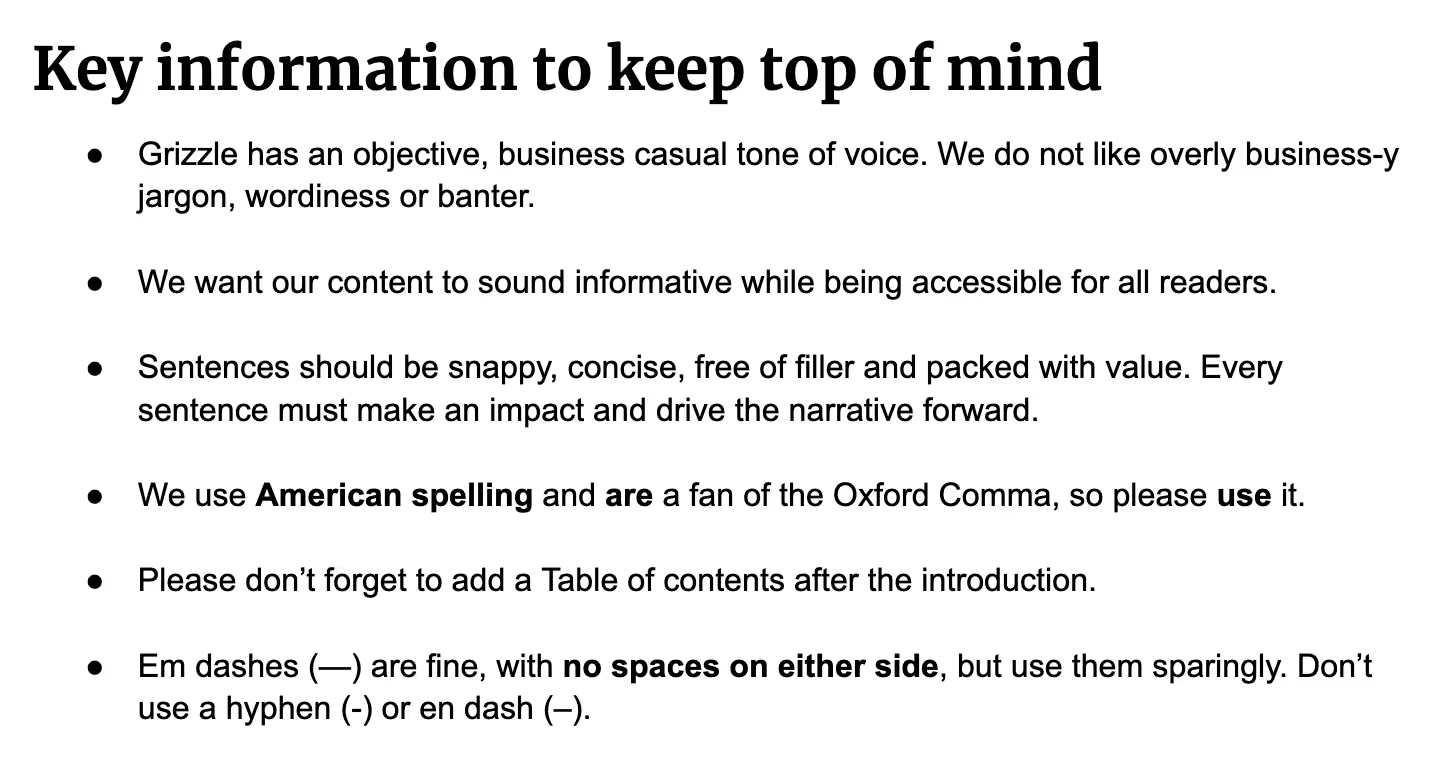
Besides content guidelines, you can also create a “Getting started writing with BRAND” resource that acts as an onboarding guide and gets writers and editors up to speed with your editorial standards.
Sections can include:
- What BRAND does
- BRAND’s writing style (with detailed examples)
- BRAND’s content goals
- BRAND’s products (and how to represent them in content)
- Link to BRAND’s content guidelines
This is a great way to amalgamate editorial goals, values, and integrity standards in one centralized place to stay organized.
With your editorial standards defined and mapped out, you’ve laid a strong foundation to refer back to throughout the content production process.
They’ll act as a true north for why you’re creating content in the first place, how exactly to do it effectively, and hold every person involved accountable.
Build a strong content operation that engineers quality in its sleep
Editorial standards without a strong team to execute them are akin to a stack of paper blowing in the wind. Or, a book of poetry written in a language that the reader doesn’t understand.
To ensure your standards are followed and upheld, you must enlist a team of A-players that understand the importance of quality content, how to create it, and how to run a tight quality control ship.
Here’s how we recommend hiring first-rate writers and editors, running smooth content workflows, and getting key feedback from stakeholders and SMEs so expectations are always aligned.
1. Hire writers that understand the power of quality (and how to produce it)
Strong writers first and foremost must understand the importance of valuable content.
This wasn’t always the case, unfortunately. This is why we still hear the “velocity-first” argument echoing through social media conversations.
Because quality wasn’t always a priority, sometimes less experienced writers are more valuable contributors than experienced ones. It’s easier to train somebody on how to write a strong paragraph than the principle behind why a strong paragraph matters.
Of course, newer writers can take longer to bring up to speed, and there is a large subset of experienced writers that have always prioritized quality regardless of what Google had to say about it.
We’ve reviewed thousands of applications over the years and trust us, we have seen it all.
So, how do you separate the great from the good? Run a paid pilot project.
Here’s the process we use Grizzle:
- Choose a topic that aligns with your goals: This helps you gauge whether candidates have subject matter expertise on topics that matter to your brand or are brilliant researchers that can craft compelling narratives based on detailed analysis.
- Create a test brief: Share information about your target audience, write an angle that explains how you want this piece of content to stand out, and build a detailed outline. This helps you see how well they follow instructions and evaluates critical thinking skills.
- Split the project into two milestones: Milestone one tests ~250 words and gives you a taste of their writing style and ability to introduce a topic, make an argument for why it’s important, supplement it with an example, and add a takeaway (all key elements of quality content). Milestone two is ~750 words and tests their topical knowledge in more depth, ability to answer questions/intent fully, how well they analyze and present results, and creative chops.
- Gauge how they fold in feedback: Feedback is a key part of the production process. The best candidates take in your feedback and turn around excellent edits that hit the nail on the head. As long as the feedback you provide explains what changes you want, and why, they should turn around spot-on edits without much effort.
You’ll still need to onboard and train new writers so they’re aligned on your content strategy, editorial standards, and expectations, which is where a “Getting started writing with BRAND'' document really shines.
2. Run a smooth production line and prioritize continuous feedback
If you’re disorganized, creating content can be a hectic process. There’s always something to create, review, give feedback on, publish, promote, audit, and optimize.
Disorganization will negatively impact quality and waste valuable time and resources.
As a bare-bones basic, you need an editorial calendar. It’ll help you commit to publishing content on a set cadence, and you can work backward from the “live” date to schedule production stage milestones.
But that’s not enough. To stay organized and on top of quality control, you must create and follow dedicated workflows and project management processes to ensure nothing slips through the cracks or is rushed.
First, establish your content production stages. Then, build processes and SOPs for each one. These may vary depending on your process and needs, but generally, a content production line is made up of these stages:
- Brief
- Outline
- Draft
- Editorial
- Repurposing
- Publication
- Promotion
- Optimization
Each stage must be accompanied by a custom workflow and should follow a waterfall project management methodology (i.e. a prescriptive set of steps that’s actioned before moving to the next stage).
For example, after you create a brief, share it with SMEs and stakeholders to get their feedback within X time frame (two days is a good turnaround time). Then, action their feedback the following day and ship it back for a final look and sign-off before creating the outline.
Repeat this “do” and “review” process throughout each stage so that key stakeholders can contribute thoughts, ideas, and feedback before you expend effort that may go to waste. When you continuously align expectations, you save time and resources.
Of course, before you ship the first draft over, your editorial team should run a developmental and copy edit, accompanied by a proofread, to ensure it’s aligned with the brief and outline and is in a presentable state.
I break down the difference between the three editing types and how they fit together in this thread:
To ensure people complete the tasks in your workflows by assigned deadlines, enlist the help of a project management tool like ClickUp, Airtable, or Asana.
3. Spend time finding great editors (aka your ace in the hole)
Speaking of editorial, great writers should compose an excellent draft and run a self-edit, but great editors are the glue that bring it all together.
They have an out-of-this-world-like ability to see through content like the matrix and spot exactly what needs to be done to up the quality level.
They also deeply understand how people read content online. The Nielsen Norman Group published research on Eye Tracking and discovered that when people arrive on a page, they quickly run a content appraisal.
During these few seconds, they’re assessing the “nature, quality, importance, and potential value of the page’s information.”
Two critical elements they scan are headings and introductions. They want to understand if the content aligns with their query, if it appears credible, and if it will be useful to read.
Misaligned headings and fluffy introductions are credibility killers. Great editors know this and ensure each element hooks, compels, and ties benefits to outcomes.
Introductions full of generalizations and aspirational filler are boring and don’t give buyers a reason to learn more. Introductions that poke at pain points, make a compelling argument and clarify what the reader will learn if they keep reading pique curiosity and are difficult to click away from.
Regarding integrity, editors also fact-check every internal and external source to ensure it’s correct, original, and accurately interpreted. This isn’t always easy to do, but sharing an article with 100% accurate and credible information goes a long way in building trust, so it’s worth the effort.
Prioritize quality, or lose the long game
You have two choices: prioritize quality or play the dopamine game.
The dopamine game costs less and might generate quick traffic but provides a terrible user experience, kills credibility, and barely converts.
The quality play is a long game. It requires upfront effort, and you won’t see results immediately (unless you have a sophisticated distribution strategy, a diversified content portfolio, and align content calendars with other goals beyond search).
It requires a bigger investment, but provides an excellent user experience, helps you achieve your goals, and has a bigger ROI in the long run.
Of course, there’s a bonus option three, and that’s where people like us come in. Nobody said that you have to produce quality content alone.
Leveraging experts with proven systems and processes that get results allows you to have your cake and eat it too.


In this article, we go beyond content marketing basics and cover the principles behind content that generates a high average time on page, builds emotional resonance, and drives conversions. I also share before and after examples of edited content and show how small changes can make a big impact.
1. Create emotion-driven content to plant persuasive seeds
Your content is an asset that will help you achieve a goal, like increased conversions, more website traffic, or credibility that lands you in the consideration set.
But what job-to-be-done (JTBD) does it fulfill? How can you strategically motivate, empower, and influence the decision-making process—even in long sales cycles?
If your messaging doesn’t align with readers’ JTBD, it won’t resonate. Attempting to connect with or persuade readers solely with logic and data discounts the emotional motivators behind buying decisions.
Emotional motivators are future-based desires. They range from wanting to grow confidence to feeling a sense of belonging to building a successful business..
Consumers feel most aligned with their favorite brands when they experience trustworthiness (83%), integrity (79%), and honesty (77%). But even when a brand is trusted, it often still fails to speak to its customers’ emotional drivers.
This missed opportunity costs money. Fully connected customers are 52% more valuable:
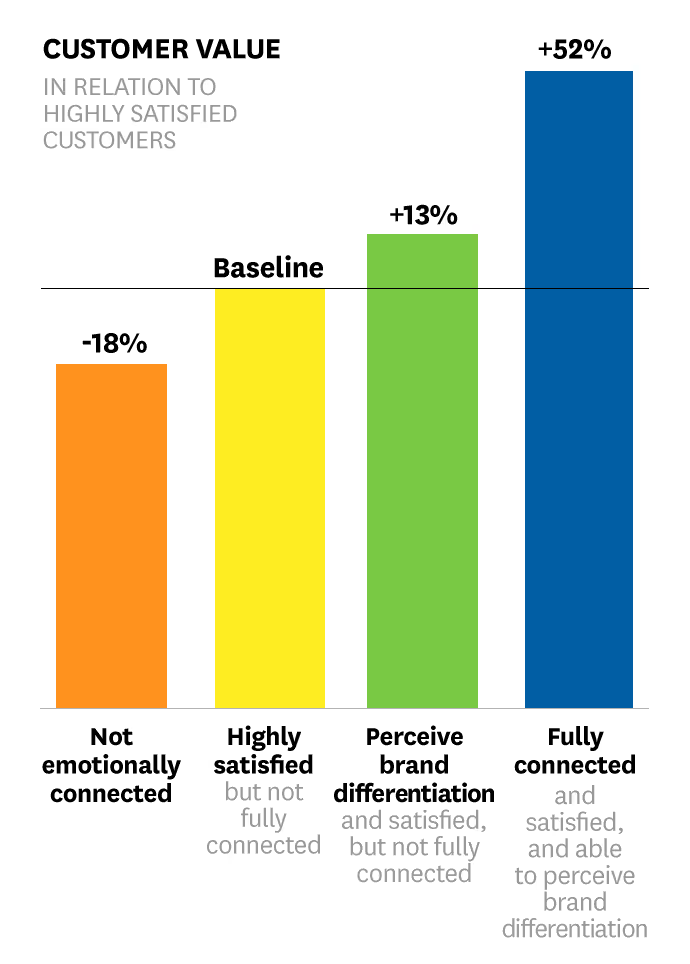
Emotional drivers vary based on your brand, category, customers, customer segments, and stage of the buying cycle. Conduct research (surveys, phone calls, data-driven insights) to uncover the key motivators that drive your audience, then execute emotion-driven content.
Here are a few ways to do that:
Inject storytelling into your narrative
It helps to think of your content as a conversation between yourself (the narrator) and your audience (the reader).
The bridge is storytelling, which is all too often left out of a data-driven narrative:
“Content that relies only on data to tell your story can end up falling flat. Worse, it can overtake the heart of the matter—creating stories that align with your strategy and speak on behalf of your brand.”
To get to the heart of the matter, return to your emotional motivator research to answer:
- What keeps your audience up at night?
- What do they dream about doing/achieving?
- What makes them trust information and what makes them wary?
- What kind of content do they find compelling, and why?
- What’s their primary JTBD and what emotional driver is that tied to?
As you build your story, continuously confront your readers' pain points or desires. This will create a personalized experience that helps them understand, connect with, and trust your solutions.
For example, Patagonia’s audience is primarily driven by the desire to feel a sense of belonging and to protect the environment. The team behind the outdoor brand knows how critical it is, therefore, to make their audience feel like they belong.
I wrote about how they do this in an article on storytelling for the CXL blog:
“Their Climbing Stories, for example, showcase anecdotal experiences, often told in the first person. They’re full of tips and tricks, practical methodologies, and recommendations. Stories from the mountains, as told by Patagonia’s customers themselves.
Emotionally, they make the reader feel like they’re part of something bigger. Practically, they inspire new and improved purchases to solve a challenge (e.g. how to pack for alpine climbing).”
Patagonia cleverly builds trust and resonance by creating a space where their customers can tell stories to each other.
Lavender, an AI email assistant software, also masterfully uses storytelling to connect with its audience. At time of writing, they’ve grown to 26,000+ followers on LinkedIn by posting humorous videos that are universally relatable.
Their target audience is sales reps, who’s biggest pain point (and barrier to success) is getting their emails ignored.
Watch how they address this common struggle, and position Lavender as the hero, in this short yet brilliant video:
If you’re already a fan of Lavender, this makes you smile because you’ve experienced a massive uptick in email opens like Kyle Coleman:
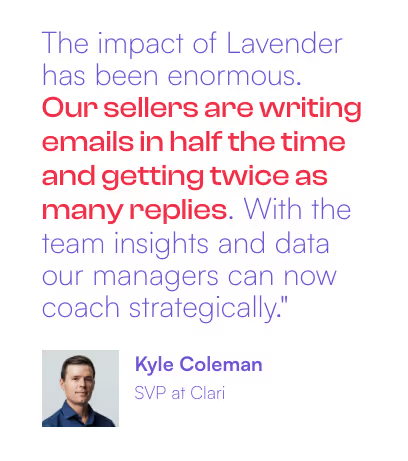
If you’re a potential customer, this makes you curious and eager to see if what they’re boasting holds truth.
Storytelling, whether owned or leveraged, is only one way to plant persuasive seeds. Let’s look at another.
Spike emotional resonance with creativity
When everyone sounds like each other, people are drawn to innovative ideas. Creativity is a strong way to differentiate and create memorable content that stays top of mind.
Done right, it entices audiences to think in new ways, consider new concepts, and overcome skepticism. When you offer value in a way that no one else does, it builds trust, which is paramount in gaining a competitive advantage.
However, if you recall, trust alone won’t move the needle. You need to use creativity to speak to those high-impact motivators that drive purchases.
One way to do that is to bring experts into the conversation. Sounds simple, but many content marketers still rely solely on third-party data to drive first-person narratives.
SMEs can help you find unique angles, make contrarian points, or speak to why established norms work so well.
They’re also personalization powerhouses. Hearing how a like-minded expert approaches a problem, overcomes a boundary, or achieves a desired outcome makes it easier to picture doing the same thing in your own life. It humanizes the topic—in turn, humanizing the brand.
For example, Semrush has a customer segment that’s driven by a desire to succeed at work and in their personal lives. To speak to those drivers, they need to make their customers feel that by using their product, they can lead more meaningful lives.
They did just that in a newsletter that shared SME insights through an emotive storytelling lens. Told through the eyes of SME Gaby: SEO by day, DJ by night:
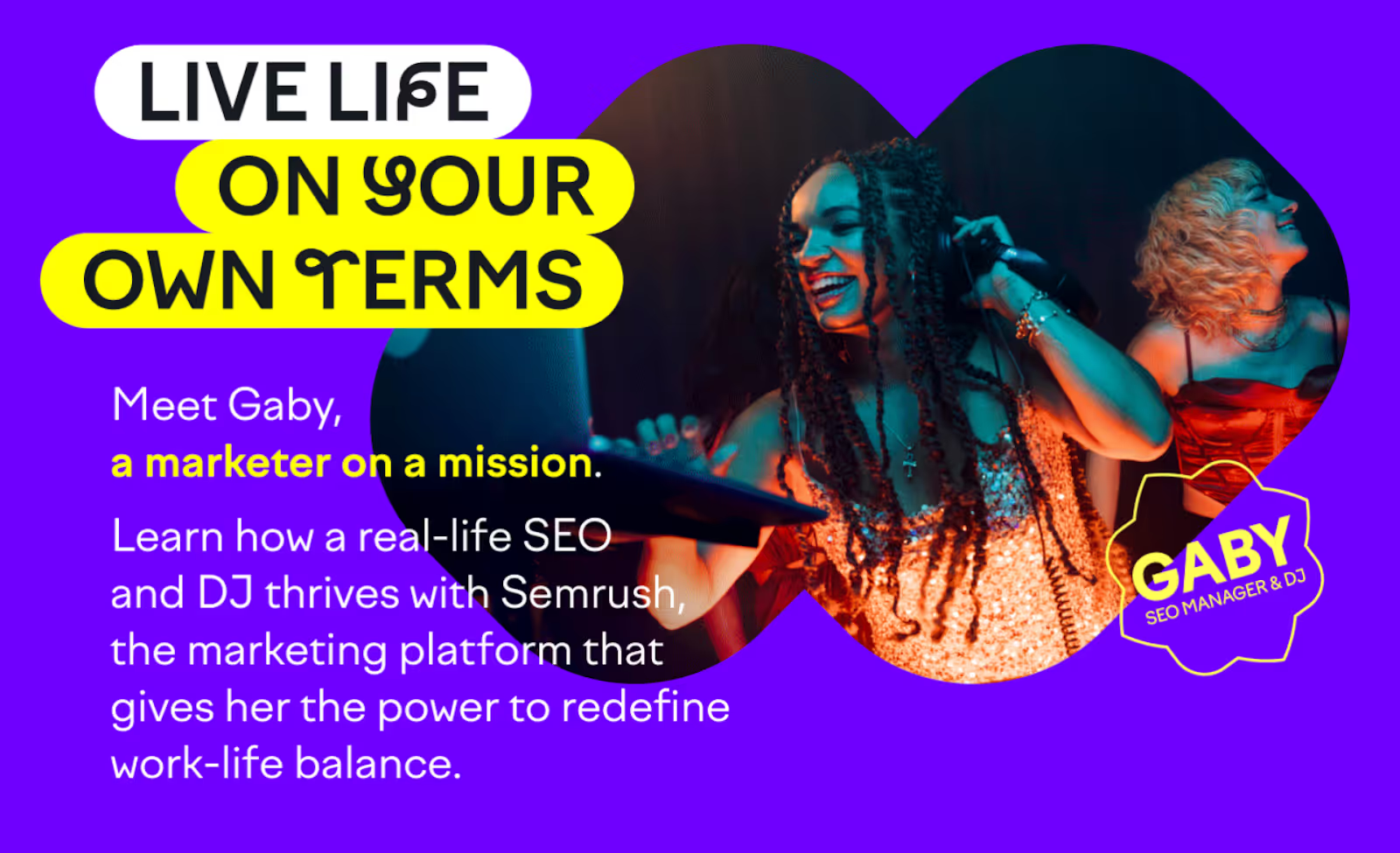
Gaby lives life on her own terms—an image that evokes freedom and worth. Through Semrush, Gaby can redefine her work-life balance and experience the best of both worlds.
While Gaby doesn’t share any expert tips per se, her position (SEO specialist at Peacock) and lifestyle (thriving DJ and aspiring producer) is creatively positioned to add credibility to the conversation.
It’s a masterclass in spiking emotional resonance. Anybody with a desire to live life on their own terms will feel inspired to check out how Semrush can aid their journey.
2. Drive your points home with relatable examples
Want to kill emotional resonance before it has a chance to work its way into the subconscious and influence decisions?
Brands devote countless hours to strategy and research, only to miserably underperform on execution. They’re proud that they’ve come up with a solid roadmap, but refuse to spend the necessary time building editorial standards that will allow them to produce high-quality content at scale.
One of the biggest differences between mediocre and valuable content is the ability to overcome the generalization gap:
Too many content marketers make a point and then leave the reader hanging. Where's the takeaway, example, or actionable advice?
Yes, content needs to be skimmable . Even if your reader is lazy or in a rush, you shouldn’t be.
Explain the “why” behind the “what” to remove guesswork and add value
Never miss a chance to explain your point further. That could leave the reader guessing and motivate them to find the "why" somewhere else.
For example, if you write a sentence like, “X is especially true because of Y”, you need to explain why Y matters.
Take this before and after as a case in point.
Before: “It's clear that the user experience Podia facilitates is valuable, particularly in a mid-pandemic world."
Ok, but why?
After: “It's clear that the user experience Podia facilitates is valuable, particularly in a mid-pandemic world where people have extra time, a desire to learn something new, and an unparalleled impulse to connect with others."
Most people can relate to feeling isolated and yearning to connect during a pandemic. Now, you’ve not only explained why, but you’ve connected with your audience on that crucial emotional level.
This adds a human element to your content. It’s what helps you go beyond the role of a robotic business trying to sell something to make a profit. It shows that you understand because you feel it too.
Nobody wants to feel like they're being sold to. Everybody wants to feel seen and heard.
Similar to how sales superstars master the art of connecting with their prospects on a personal level, use specificity to drive authentic connections.
Show, don’t tell to prove authenticity
These days, “take my word for it” doesn't fly. Not when social proof and word of mouth influence buying behavior, purchasing decisions, and brand loyalty above all.
A Deloitte study finds that, in order to bring authenticity into the digital age, you need to lead with purpose and center the human experience:
“Purpose answers an all-important question, ‘Why does a company exist?’—and the answer can serve as the beacon for all organizational decision-making.”
To prove authenticity, make sure to demonstrate exactly how you accomplish your goals. If you have permission, inject social proof by centering a real customer story that personalizes your data.
For example, Co-Founder and Co-CEO Alina Vandenberghe understood the power of a strong brand before she started Chili Piper. Its brand has managed to differentiate amongst steep competition like Salesforce.
Peep Laja of CXL writes:
“I've been watching the meteoric rise of Chili Piper. So many lessons to be learned from this company.
Their net revenue retention is super high (which also landed them an amazing valuation during their series B, like a 20x multiplier on ARR).”
Alina Vandenberghe wrote an article on how they built the brand from the inside out. She doesn’t simply talk about the journey, she gives specific examples of how they skyrocketed brand awareness and audience building:
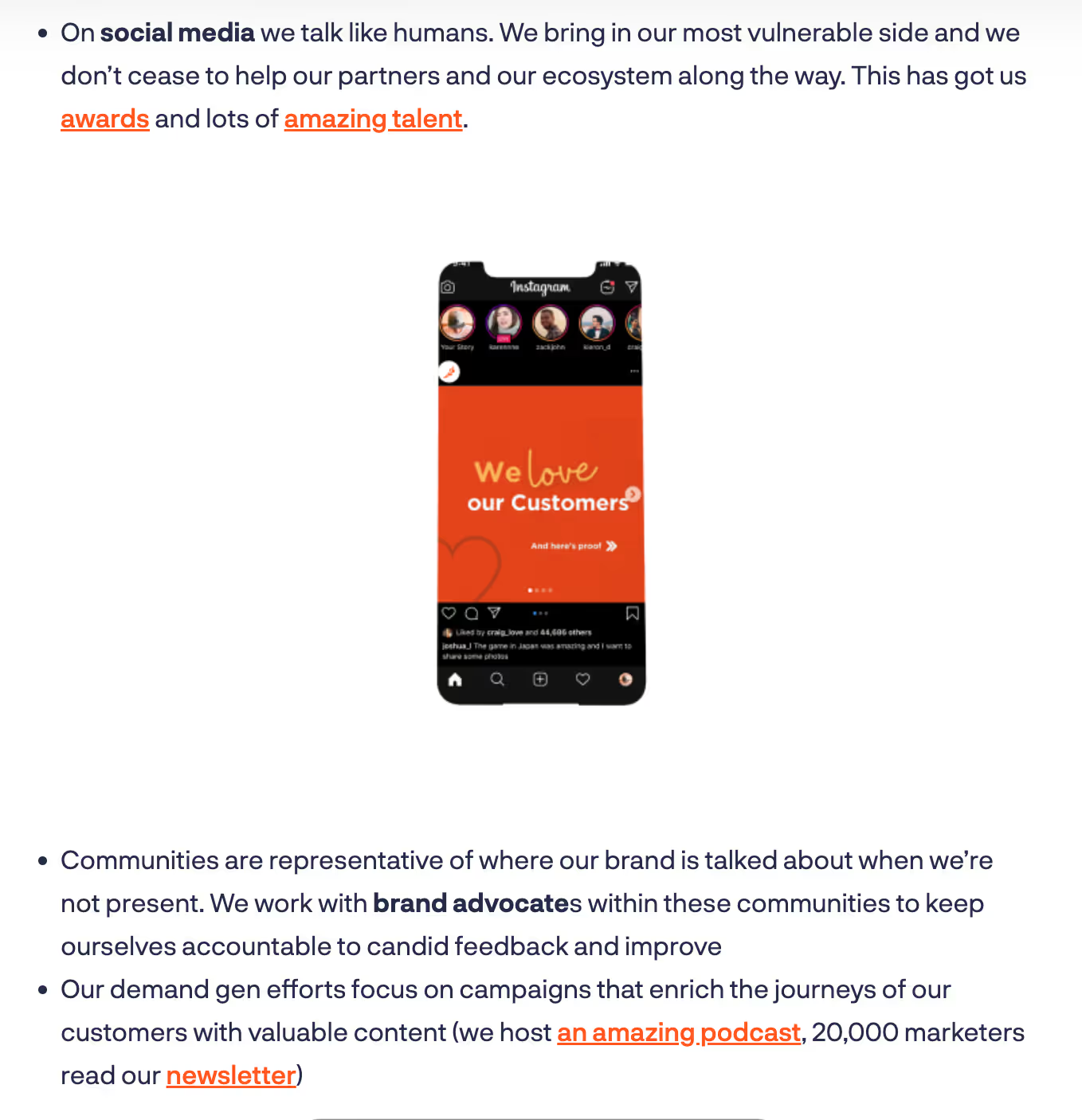
Authentic content often correlates with transparency. When you give away your ‘secrets’ for free, people feel more connected to your purpose and want to come along for the ride.
3. Declutter your copy and avoid redundancy
This may seem basic, but even advanced content writers struggle with wordiness and redundancy.
We all have publishing deadlines breathing down our necks. But if you’re starting to feel like you’re prioritizing quantity over quality, catch yourself.
Figure out why your sentences are averaging 20+ words and set up a strategy to reset and refocus.
Create a process for self-accountability to stay on track
At Grizzle, our writers create a detailed outline before getting started to make sure they avoid waffle. A comprehensive outline acts as a roadmap to follow, which reduces the chance you’ll repeat key points (which adds friction to the reading experience).
But if you’re a short-outline, write-as-you-research kind of creator, catch yourself at the end. Take a few hours away from your draft and revisit it before you publish.
Your message needs to be simple, clear, interesting, and skimmable. Complexity and wordiness do you no favors and certainly don’t give you an intellectual upper hand.
Content marketing isn’t intended to mimic dissertation’s, argumentative essays, workflow documentation, or anything else that calls for longer prose.
To declutter your copy, focus on these key copywriting principles:
Use active not passive voice to empower your reader to take action
Active voice is easier to skim and empowers the reader to take action.
Why? Because we're putting the power in their hands.
Rather than telling the reader that something can happen to them, we want them to feel like they can take charge and make it happen for themselves.
This ideally leads to the reader clicking a CTA or internal link, which works to build a stronger connection and gets them closer to becoming a customer.
For example:
Passive voice: “If you don’t have a mathematics degree, gaining professional qualifications like these is likely to boost your career prospects.
Active voice: “If you don’t have a mathematics degree, pursue relevant professional qualifications to boost your career prospects."
The language is more actionable and likely to inspire and energize the reader.
Another example:
Passive voice: “To optimize the time of your sales team, utilizing a data-driven marketing automation approach is key.”
Active voice: “To optimize your sales team’s time, utilize a data-driven marketing automation approach.”
It’s cleaner, easier to read, and tells the target audience (in this case, sales managers) exactly what to do (i.e. learn from data and automate repeatable tasks).
Rather than a solution that reads like half-baked advice, active voice empowers the reader to take matters into their own hands.
Trim the fat to get to the point
Never use more words than you need to. To quote William Strunk Jr., co-author of “The Elements of Style”:
“Omit needless words! Omit needless words! Omit needless words!”
People skim, but when they do land on a section of interest, they need to be engaged.
If your sentences twist and turn and are full of words that don’t really need to be there just to further make a point that you feel is important then you’ll lose them in a heartbeat.
See what I did there?
Let’s try that again. If your sentences are redundant and wordy, your readers will leave.
Here are a few examples of how to trim the fat:
Before: “To start making a plan, sit down and ask yourself the following questions:”
After: “To formulate a plan, ask:”
Before: “Affiliate marketing is often paid out by getting a free product or service.”
After: “Affiliate marketing is often paid via product or service payouts.”
Before: “To get more likes on Twitter than you’re currently getting; to squeeze everything you can out of a post, you need to approach content tactically."
After: “To get more likes on Twitter, approach content tactically.”
Your reader gets the same point, faster. Cutting superfluous words is not about cutting value. Quite the opposite. It creates more value because it’s easier to understand.
Avoid redundancy to preempt boredom and cultivate your character
I think of redundancy in two buckets:
- Repeated words or phrases that are overused and thus redundant
- Repeated ideas that are unnecessary because you’ve already made your point
Avoid both types.
Here’s an example of redundant words:
Before: “The roles begin to diverge once you take technical skills into account. Sales engineers have technical skills that allow them to identify patterns that someone without technical expertise may miss.”
See how the phrase technical expertise is starting to sound like a tongue twister?
After: “The roles begin to diverge once you take technical skills into account. Sales engineers have the industry expertise to identify patterns that an untrained eye may miss.”
That’s a lot easier to get through.
Let’s look at one more example.
Before: “When working with potential customers, technical sales engineers can explain complex concepts in a customer-friendly way. They use their knowledge to explain to potential clients how the product works and what makes it unique.”
After: “When working with prospects and leads, technical sales engineers can explain complex concepts in a customer-friendly way. These experts can demonstrate exactly how your solution will produce desired results and what makes it unique.”
Variety makes copy more compelling. Nobody wants to read the same word over and over. At best, it will make your copy look sloppy. At worst, it will look like keyword stuffing, which is the fastest way to appear robotic instead of a relatable, human narrator.
Redundant ideas are harder to neatly demonstrate as they often pop up throughout content rather than in the same sentence or paragraph.
For example purposes, I’ve condensed redundant ideas into one paragraph:
Before: “When pitching to investors, use data to dial up the pain and show how trends in digital adoption could harm business if they don’t act fast. As an example, [company name] outlined the opportunity investing in digital transformation presents. They hit stakeholders with some pain, and then showed them how they can turn it into an opportunity.”
After: “When pitching to investors, use data to dial up the pain and show how trends in digital adoption could harm business if they don’t act fast. Then, use examples to outline the opportunity on the other side of these pain points. As an example, [company name] used qualitative and quantitative data to demonstrate risk and showcase outcomes.”
The difference is nuanced but important. The first is slightly repetitive, and the second makes the same point without any repetition.
In the first example, the writer makes a point that you should ‘dial up the pain’ then ‘outline the opportunity’ this pain presents. They wrap up the paragraph with the same exact point, stated differently. It’s still effective, but ever so slightly repetitive, which we don’t want.
The second example wraps the ‘use pain to then outline opportunities’ point into the entire paragraph. Thus, they make the same point, but in a uniquely different way. It flows smoother and fit better into a seamless storytelling narrative.
It’s impossible not to repeat your ideas throughout a piece of content writing, but in doing so, make sure they flow seamlessly and aren’t obvious repetitions of one another.
This way, by the time your reader gets to the end, you’ve driven your point home so smoothly that they fully understand your argument but don’t feel exhausted or bored by repetition.
Key takeaways
Content marketers that master emotional resonance thrive. Content marketers that create strategies built to spike emotional resonance, then execute them with a quality-first mindset win.
Devote equal time to strategy and execution to build a competitive advantage and an army of loyal fans.
Fuel your growth with content that actually delivers.


